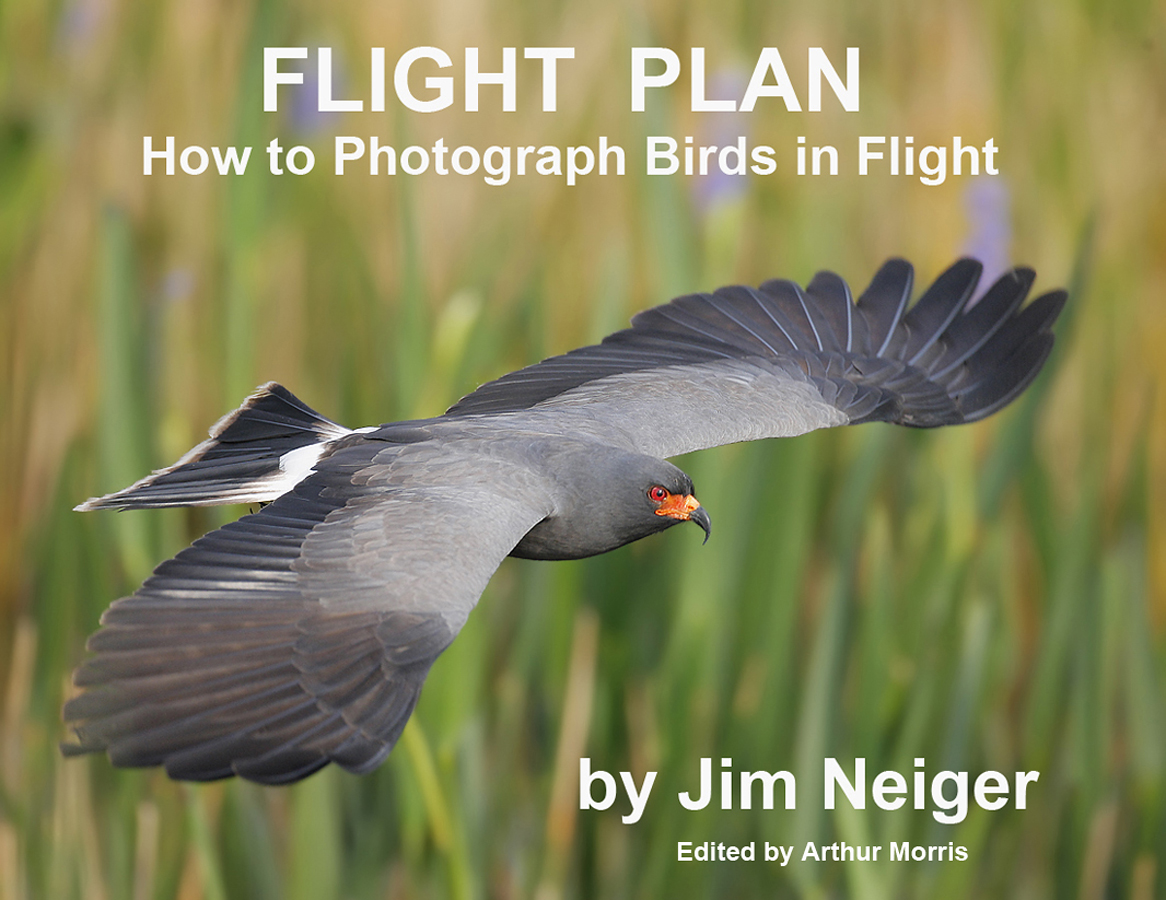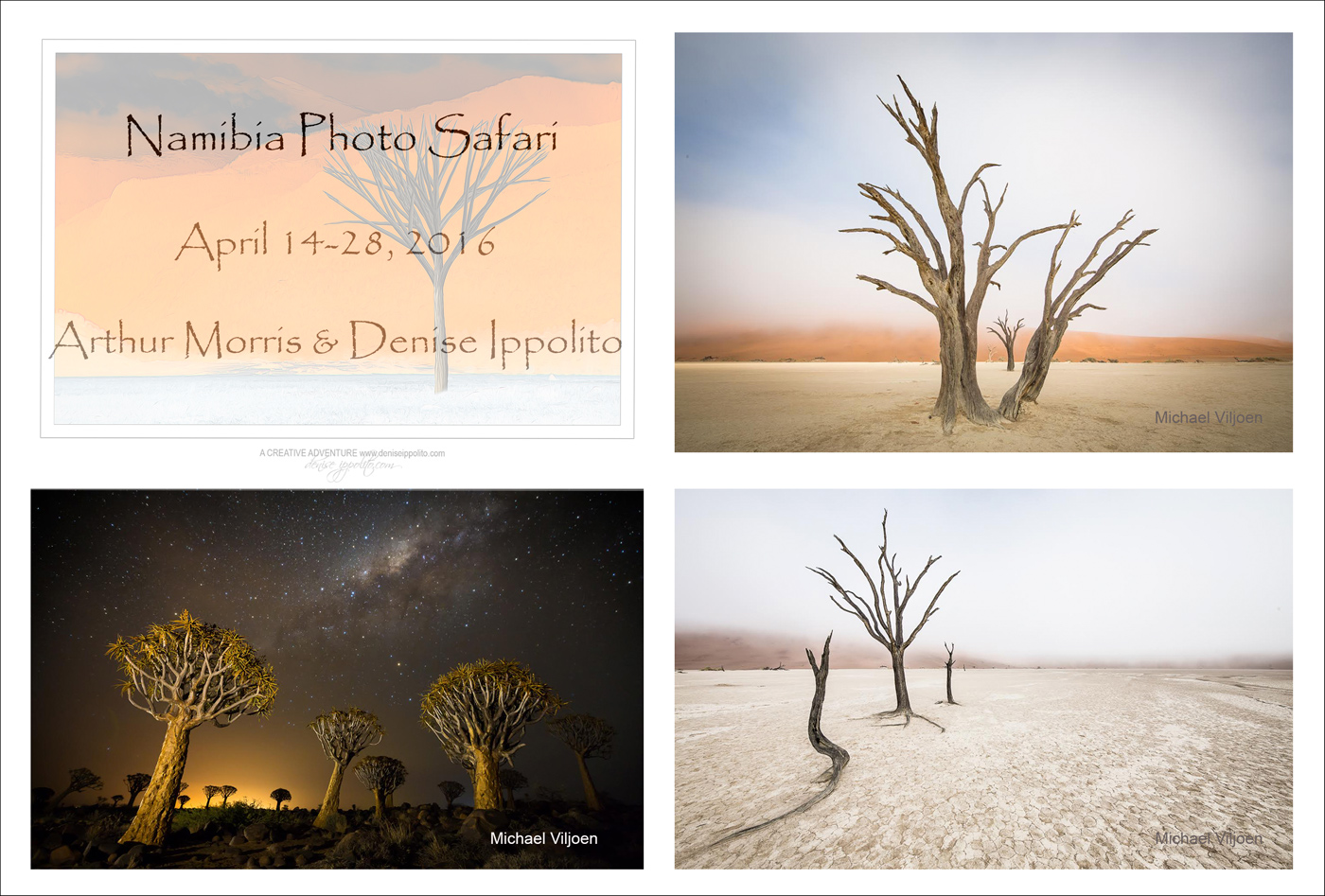December 27th, 2015 Please note: This IPT has been cancelled due to extremely poor conditions at the refuge in January 2016. artie
|
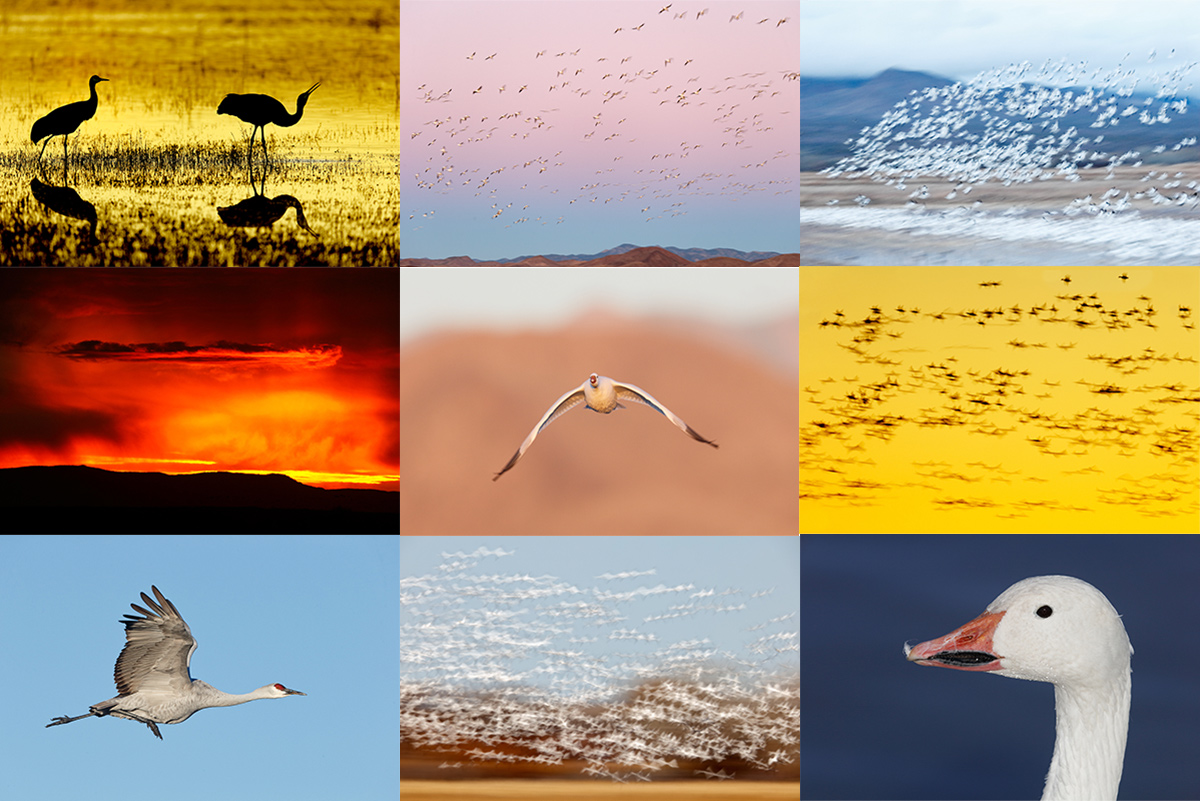
|
|
The Best of Bosque 2015
|
The Facts
Next season, I am offering a 4 1/2-DAY Bosque IPT in mid-January. And yes, there are lots of less costly workshops being offered these days. Many of them are downright cheap. There are strict requirements for becoming a workshop leader these days: you must own a camera…. Please remember that you get exactly what you pay for. With me you will have an instructor with more days of teaching and more in-the-field photography experience at Bosque than anyone living or dead: 21 seasons worth. And two BBC Wildlife Photographer of the Year-honored images from Bosque. If you want the finest in photographic instruction and want to be assured of being in the right spot at exactly the right time every day, do join me.
Bosque del Apache 2017 BIRDS AS ART/Instructional Photo-Tour. January 13 (afternoon session) through January 17, 2017. 4 1/2 DAYS: $1899. Limit 12/Openings 10.
One half day followed by four full days. Includes four lunches, a comprehensive introductory program on the evening of January 13, and unequaled in-classroom and in-the-field instruction. Breakfasts are on-the-run/grab what you can or motel lobby or get-up-early-and-get to McDonalds (right next door). Four early morning sessions. Five afternoon sessions. The last afternoon will be spent at the Albuquerque Zoo photographing Wood Ducks. This will allow folks to stay in ABQ that evening and grab an early morning flight home (if that works for them).
Photograph tens of thousands of Snow Geese, 10,000 Sandhill Cranes, ducks, amazing sunrises, sunsets, and blast-offs. Live, eat, and breathe photography with the world’s premier photographic educator at one of his very favorite photography locations on the planet. Top-notch in-the-field and Photoshop instruction. This will make 21 consecutive seasons at Bosque for me. Nobody knows the place better than I do. Nobody understands the wind and the light better than I do. Join me to learn to think like a pro, to see like a pro, to recognize situations, and to anticipate them based on the weather, especially the sky conditions, the light, and the wind direction. Every time I make a move I will let you know why. When you head home being able to apply what you’ve learned on your home turf will prove to be invaluable.
This workshop includes 4 pre-dawn morning and 5 afternoon photography sessions, an inspirational, introductory slide program after dinner on your own on Friday, 1/13/17, four lunches, and after-lunch digital workflow, Photoshop, and image critiquing sessions.
There is never a set itinerary on a Bosque IPT; each day is tailored to the local conditions and to the weather. I need to be totally flexible in order to maximize both the photographic and learning opportunities. We will be up early each day leaving the hotel by 5:30 am to be in position for sunrise. We usually photograph until about 10:30am. Then it’s back to Socorro for lunch and followed at some point by a classroom session with the group. There is almost always room for a short nap in there somewhere. We head back to the refuge each afternoon and photograph until sunset. We will be photographing lots of Snow Geese and lots of Sandhill Cranes with the emphasis on expanding both your technical skills and your creativity. As always, we will make time to do some non-avian creative stuff.
|
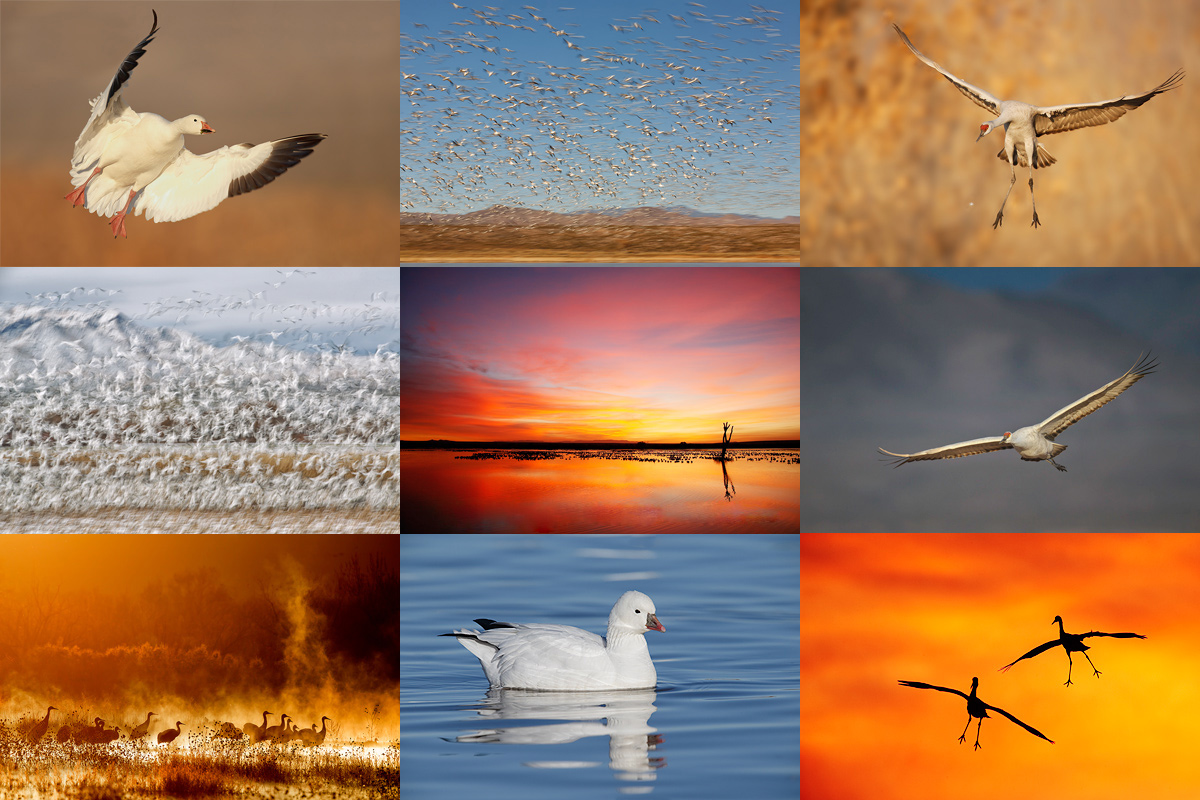
|
|
Join me in January 2015 to learn to read Bosque’s amazing light and use it to create dramatic images.
|
How Do I Sign Up?
A $599 non-refundable deposit is required to hold your slot for this IPT. Your balance, payable only by check, will be due on 9/13/2016. If you cancel and the trip fills, I will be glad to apply a credit applicable to a future IPT for the full amount less a $100 processing fee. If we do not receive your check for the balance on or before the due date we will try to fill your spot from the waiting list. Whether or not your spot is filled, you will lose your deposit. If not, you can secure your spot by paying your balance.
Please print, complete, and sign the form that is linked to here and shoot it to us along with your deposit check (made out to “Arthur Morris.”) You can also leave your deposit with a credit card by calling the office at 863-692-0906. If you register by phone, please print, complete and sign the form as noted above and either mail it to us or e-mail the scan. If you have any questions, please feel free to contact me via e-mail.
|
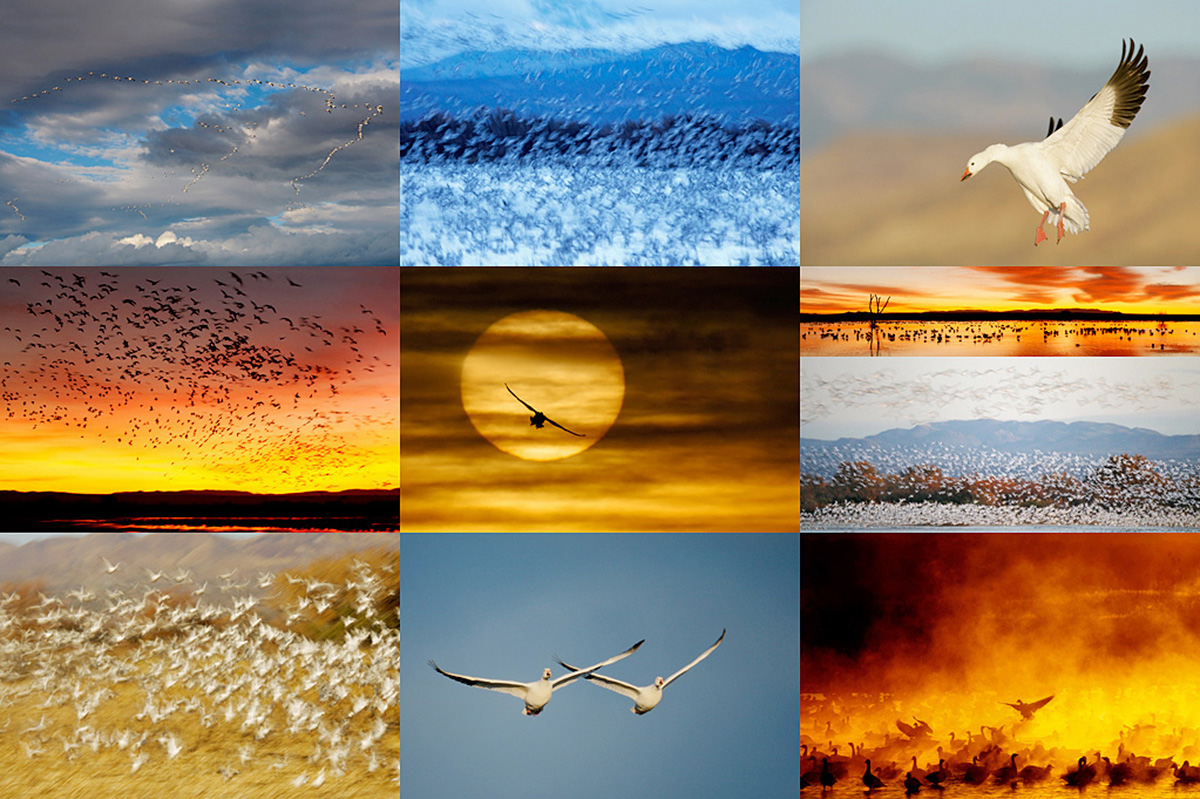
|
|
There are two BBC Wildlife Photographer of the Year Competition-honored images along with a National Wildlife Contest winner on this card…. Join me in January 2017 to learn to create contest-quality images.
|
Small Group Pre-IPT In-the-Field Instruction (I-T-F): January 11 & 12, 2017: $375/morning session. Limit six.
Though I am not sure exactly when, I will be flying to New Mexico early to scout. What can I say? I love the place. Right now I am offering two I-T-F morning photography sessions as above. The sessions will run from 6:00-10:00am and will include an informal image review session at lunch. Lunch is on me. Right now registration is open only to folks registering for the IPT. This will allow participants to maximize their travel dollars and get a head start on learning. Sign up for one or for both.
Facebook
Be sure to like and follow BAA on Facebook by clicking on the logo link upper right. Tanks a stack!
Typos
In all blog posts and Bulletins, feel free to e-mail or to leave a comment regarding any typos or errors. Just be right 🙂
December 26th, 2015 What’s Up?
I spent most of Thursday writing the new Southern Oceans Guide that I started working on about three weeks ago. I hope to have it finished in two weeks.
I watched lots of NBA basketball. The Golden State Warriors continue to make history every day. The record now stands at 28 wins, 1 loss, the best-ever NBA start.
A Nice Holiday Gift from Jim Keener
As the BAA Online Store was down from Thursday evening through most of the day on Friday, I had put a note in yesterday’s blog stating that folks were welcome to call in their orders. (The store was back up on Friday afternoon.)
The phone rang at 1:39pm and I picked up to a pleasant voice. It was a Jim Keener calling from Albuquerque to order Digital Basics and both APTATS I and APTATS II. We chatted for a while and he told me that he had moved to Albuquerque to be close to Bosque. I was quite impressed. After I finished taking his order Jim said, “I need to thank you for changing my life, for inspiring me with your images and your teaching.”
After we hung up I e-mailed Jim and asked him to expand on what he had told me on the phone. He wrote:
I bought a lot of gear in August 2013 when I was 70 and was looking for things to photograph. I was at a friend’s home in Rancho Mirage, CA and must have been underfoot,because she handed me her Canon 400mm f/5.6 lens and told me to go outside and play. I saw a Great Egret across a pond, focused on it, and waited for it to fly. Finally it took to the air. In that instant I was hooked on bird photography. I scoured the internet for information on bird photography and found your B&H video describing the lenses you use for photographing birds and nature. After a bit more searching I found the BIRDS AS ART website, your blog, and BirdPhotographers.Net. I was amazed at the quality of guidance and the courtesy on the BPN forums–I hang out in Eager to Learn (ETL) right now, and I was amazed at the expertise that you share every day on your blog.
How nice is that?
Out of curiosity I clicked on Jim’s website and checked out his Bosque gallery. I thought that I recognized one image and then 100% for sure recognized another, a Sandhill Crane image of Jim’s that I had recently commented on in the ETL Forum. You can find that thread here. There were lots of reposts including two by me but the image was still not looking very good so I asked Jim if he would kindly send me the RAW file. He did.
|

|
|
This JPEG accurately represents the RAW file that Jim sent to me via a Dropbox.
|
My Final BPN Comment
Again, you can find the whole thread here.
Thanks for sending me the RAW file Jim. I converted it in DPP 4 and used my standard Photoshop workflow most especially including Filter/Blur/Surface Blur on the background only, some Eye Doctor work, and my NIK Color EFX Pro 50/50 recipe at 35%. Total time: about 4 minutes….
Your RAW file was about a full stop underexposed; this is not what you want to go with a 7D III ISO 1600 file . And your crop was way too tight…..
Non-the-less there was a pretty good image in your RAW file.
artie
|
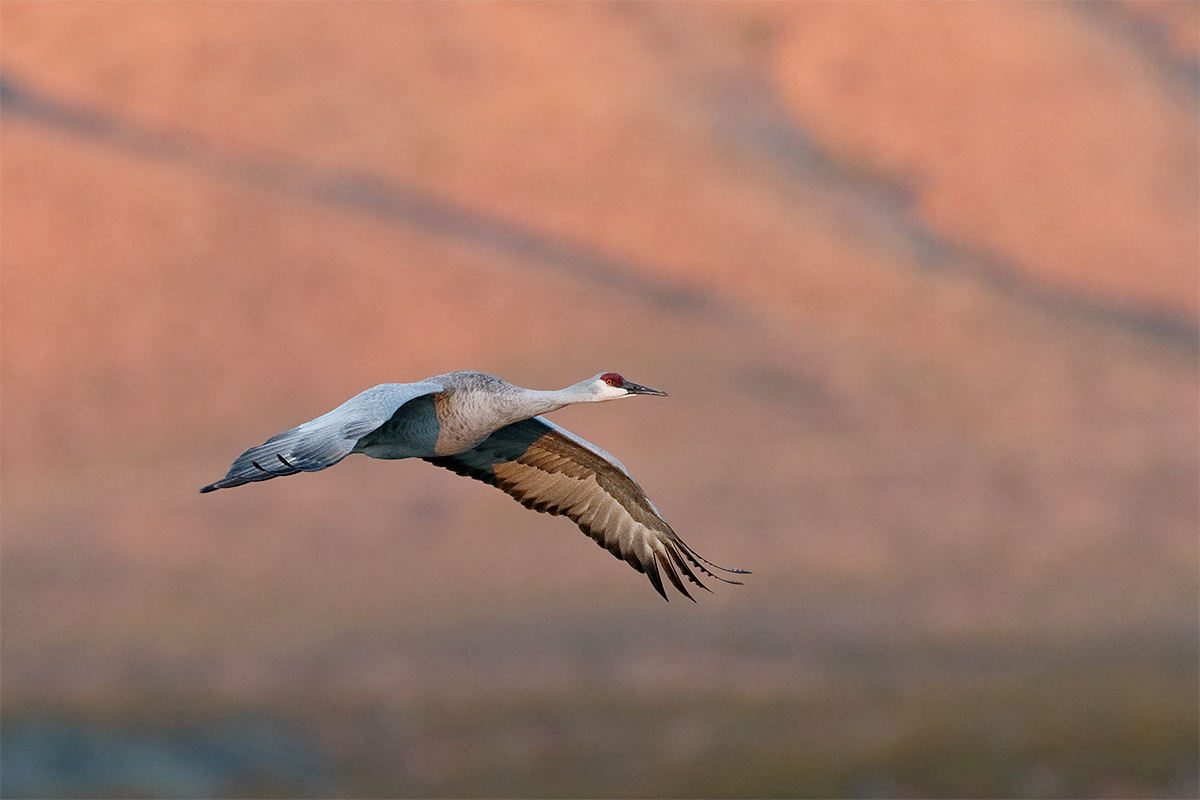
|
|
This is the image that I created from his under-exposed RAW file after converting it in DPP 4. Notice that the background is pretty darned smooth.
|
Digital Basics
Everything that I did to optimize Jim’s image is covered in detail in my Digital Basics File–written in my easy-to-follow, easy-to-understand style. Are you tired of making your images look worse in Photoshop? Digital Basics File is an instructional PDF that is sent via e-mail. It includes my complete digital workflow, dozens of great Photoshop tips, details on using all of my image clean-up tools, the use of Contrast Masks, several different ways of expanding and filling in canvas, all of my time-saving Keyboard Shortcuts, Quick Masking, Layer Masking, and NIK Color Efex Pro basics, Contrast Masks, Digital Eye Doctor techniques, using Gaussian Blurs, Dodge and Burn, a variety of ways to make selections, how to create time-saving actions, the Surface Blur settings that I use to smooth background noise, and tons more.
APTATS I & II
Learn the details of advanced Quick Masking techniques in APTATS I. Learn Advanced Layer Masking Techniques in APTATS I. Mention this blog post and apply a $5 discount to either with phone orders only. Buy both APTATS I and APTATS II and we will be glad to apply at $15 discount with phone orders. Please call Jim or Jennifer weekdays at 863-221-2372 to take advantage of this special offer. You can find the same deal in the BAA Online Store here.
|
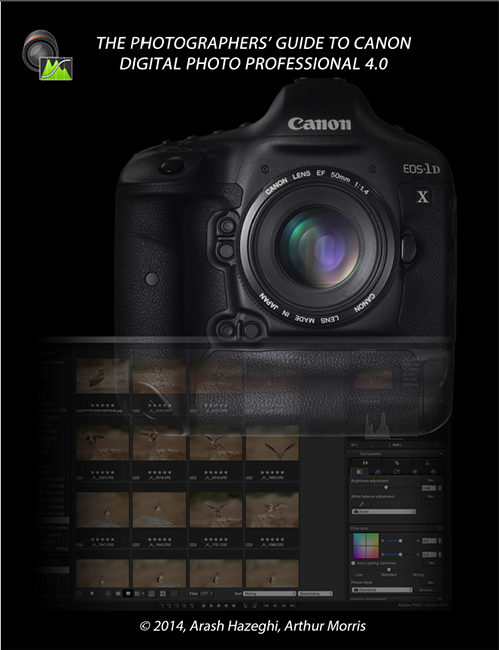
|
|
You can order your copy of “The Photographers’ Guide to Canon Digital Photo Professional 4.0” (aka the DPP 4 Raw Conversion eGuide) by Arash Hazeghi and Arthur Morris by clicking here.
|
The DPP 4 eGuide (PDF)
The RAW file for today’s image was of course converted in DPP 4. Learn how and why I and many other discerning photographers choose and use only DPP 4 to convert their Canon RAW files in the DPP 4 RAW Conversion Guide by Arash Hazeghi and yours truly. The latest version supports all of the newer Canon camera bodies and several older models including the EOS-7D and the EOS-1D Mark IV. The DPP IV Guide is the ideal companion to the 7D Mark II User’s Guide, a runaway best seller.
The DPP 4 eGuide (PDF) Updated for 1D Mark IV and the original 7D
The DPP 4 eGuide was recently updated to include the luminance and chrominance noise reduction values for both the 1D Mark IV and the original 7D. If you purchased your copy from BAA please e-mail Jim and request the DPP 4 1d IV/7D update. Please be sure to cut and paste page 1 into your e-mail as proof of purchase.
DPP 4 Kudos
From Richard Gollard via e-mail:
I have been doing tons of studying the books and PDFs that I have purchased from BIRDS AS ART. And I have to say that after reading the DPP 4 conversion guide that you did with Arash Hazeghi I tried DPP 4 and was blown away with the difference from the conversions that I made with Adobe Photoshop and Lightroom. Thanks for the consistently great information.


Please Remember to use our Affiliate Links 🙂
To show your appreciation for my continuing efforts here, we ask, as always, that you get in the habit of using my B&H affiliate links on the right side of the blog for all of your photo and electronics purchases. Please check the availability of all photographic accessories in the BIRDS AS ART Online Store, especially the Mongoose M3.6 tripod heads, Gitzo tripods, Wimberley heads and plates, LensCoats and accessories, and the like. We sell only what I have used, have tested, and can depend on. We will not sell you junk. We know what you need to make creating great images easy and fun. And we are always glad to answer your gear questions via e-mail. I just learned that my account was suspended during my absence; it should be up and running by Monday at the latest.
I would of course appreciate your using our B&H affiliate links for all of your major gear, video, and electronic purchases. For the photographic stuff mentioned in the paragraph above we, meaning BAA, would of course greatly appreciate your business. Here is a huge thank you to the many who have been using our links on a regular basis and visiting the BAA Online store as well.
Facebook
Be sure to like and follow BAA on Facebook by clicking on the logo link upper right. Tanks a stack!
Typos
In all blog posts and Bulletins, feel free to e-mail or to leave a comment regarding any typos or errors. Just be right 🙂
December 25th, 2015 What’s Up?
For those of you who celebrate Christmas, I hope that Santa has left some great photo gear for you under the tree. I was thrilled to learn recently that this year Santa began using our BH affiliate links for all lenses and camera bodies. And he does buy his accessories from the BAA Online Store.
I learned from Ted Cheeseman on Wednesday that OCT/NOV 2016 South Georgia/Falklands expedition is filling nicely: if you have been thinking of making this trip and would like to become part of the BAA group, please scroll down and do not tarry.
Important Note
Please understand that if you are up in the air about selling any old gear that the price of your item is dropping every day….
Selling Your Used Gear Through BIRDS AS ART
Selling your used (or like-new) photo gear through the BAA Blog or via a BAA Online Bulletin is a great idea. We charge only a 5% commission. One of the more popular used gear for sale sites charges a minimum of 20%. Plus assorted fees! Yikes. The minimum item price here is $500 (or less for a $25 fee). If you are interested please e-mail with the words Items for Sale Info Request cut and pasted into the Subject line :). Stuff that is priced fairly–I offer free pricing advice, usually sells in no time flat. In the past few months, we have sold just about everything in sight. Do know that prices on some items like the EOS-1D Mark IV, the old Canon 500mm, the EOS-7D, and the original 400mm IS DO lens have been dropping steadily. You can see all current listings by clicking here or by clicking on the Used Photo Gear tab on the yellow-orange tab on the right side of the menu bar above.
Things have been heating up on the Used Gear page lately.
- Troy Duong sold his Canon 500mm f/4L IS II lens for $7500.00 in late December 2015.
- Walt Anderson sold a used Canon 1D X for $3000 in late December to a BAA friend before it was even listed!
- Larry Master sold a Canon EOS-1D Mark IV in excellent condition for $1399 in mid-December 2015.
- Melissa Hahn sold her Canon 400mm f/2.8L IS II lens in mint condition now for $8299 in early December, 2015.
- Monte Brown sold his 300mm 2.8 II lens in near-mint condition for $4499 two days after it was listed in mid-December, 2015.
- Stephen Zarate sold his used Canon 100-400mm L IS zoom lens very quickly in early December for $650, the original asking price.
- Kenton Rowe sold his Canon 200-400mm f/4L IS lens with Internal 1.4X Extender in early December for $9799.
- Brent Bridges sold his Canon 600 II for the full asking price, $9799,in early December 2015.
- Mike Ederegger sold his AF-S Nikkor 200-400mm F/4 G ED VR II in excellent condition for $ 5199 right after it was listed.
|
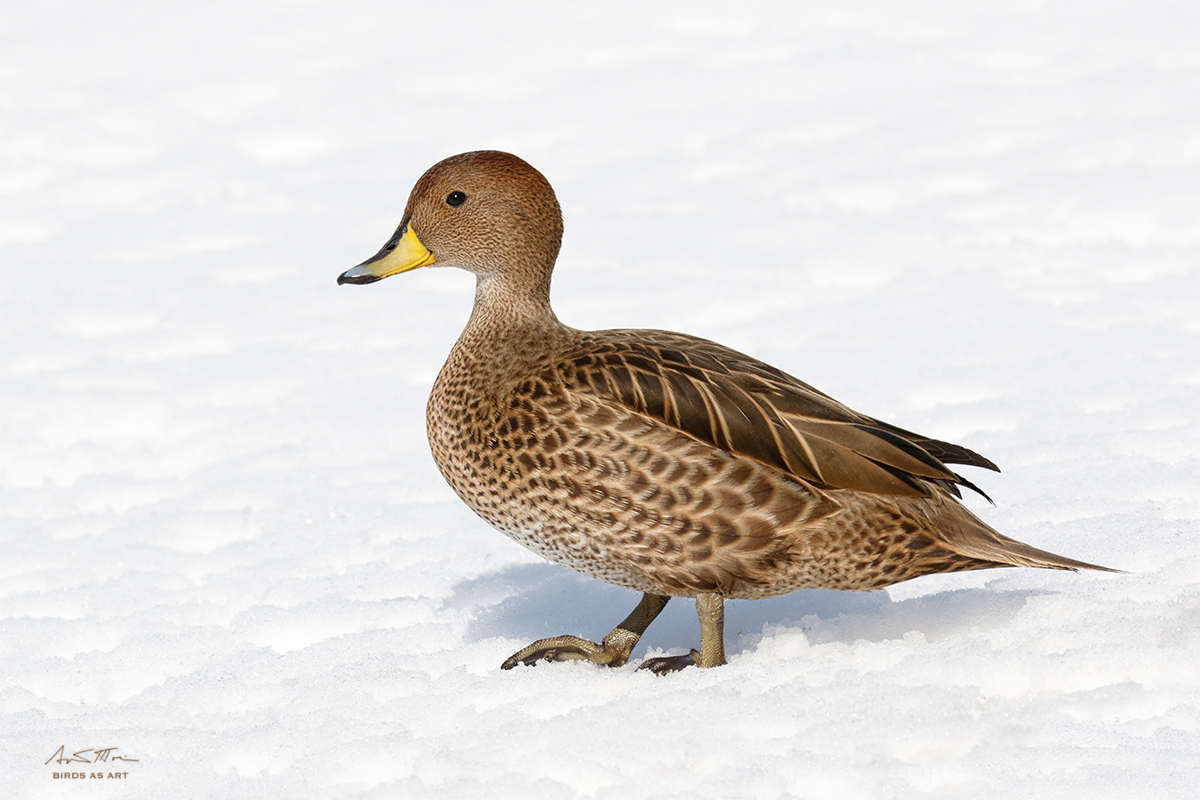
|
|
This image was created at Grytviken, South Georgia with the hand held Canon EF 100-400mm f/4.5-5.6L IS II USM lens (at 400mm) and the amazing Canon EOS 7D Mark II. ISO 400. Evaluative metering +1 stop: 1/1000 sec. at f/11 in Manual mode.
Center AF point (Manual selection)/AI Servo/Shutter Button AF as framed was active at the moment of exposure (as is almost always best when hand holding). The active AF point was on the side of the duck’s breast. Click on the image to see a larger version.
South Georgia Pintail
|
Grytviken, South Georgia
Grytviken is mandatory landing on all South Georgia trips as you need to go through South Georgia customs there. I always skip the champagne toast at the Shackelton grave as there are some nice wildlife opportunities. In addition there is access to a derelict whaling station, a lovely old church, and quite a few rotting ships along the shoreline.
Duckstaposition
With the successful completion of the Rat Eradication Project, there were lots more South Georgia Pintails about on the grass at
Grytviken. Better yet, there were many little areas filled with snow. If it had been a golf course, I would have said that the sand traps were full of snow.
For some reason, the ducks liked the snow; the trick to making a good image was to get a complete snow background. As the snow bunkers were small and the ducks like to stand along the edges, this was not easy to do. To come up with a complete snow background with today’s image required a decent crop and some APTATS II work on the lower right corner. See the next image for more on that.
Another Depth-of-Field Question
Why did I stop down to f/11 when I would usually be working at f/5.6 with this combination. Note: “To get more depth-of-field” is not the answer I am looking for. I want to know why it was necessary in this specific set or circumstances to get down to f/11.
|
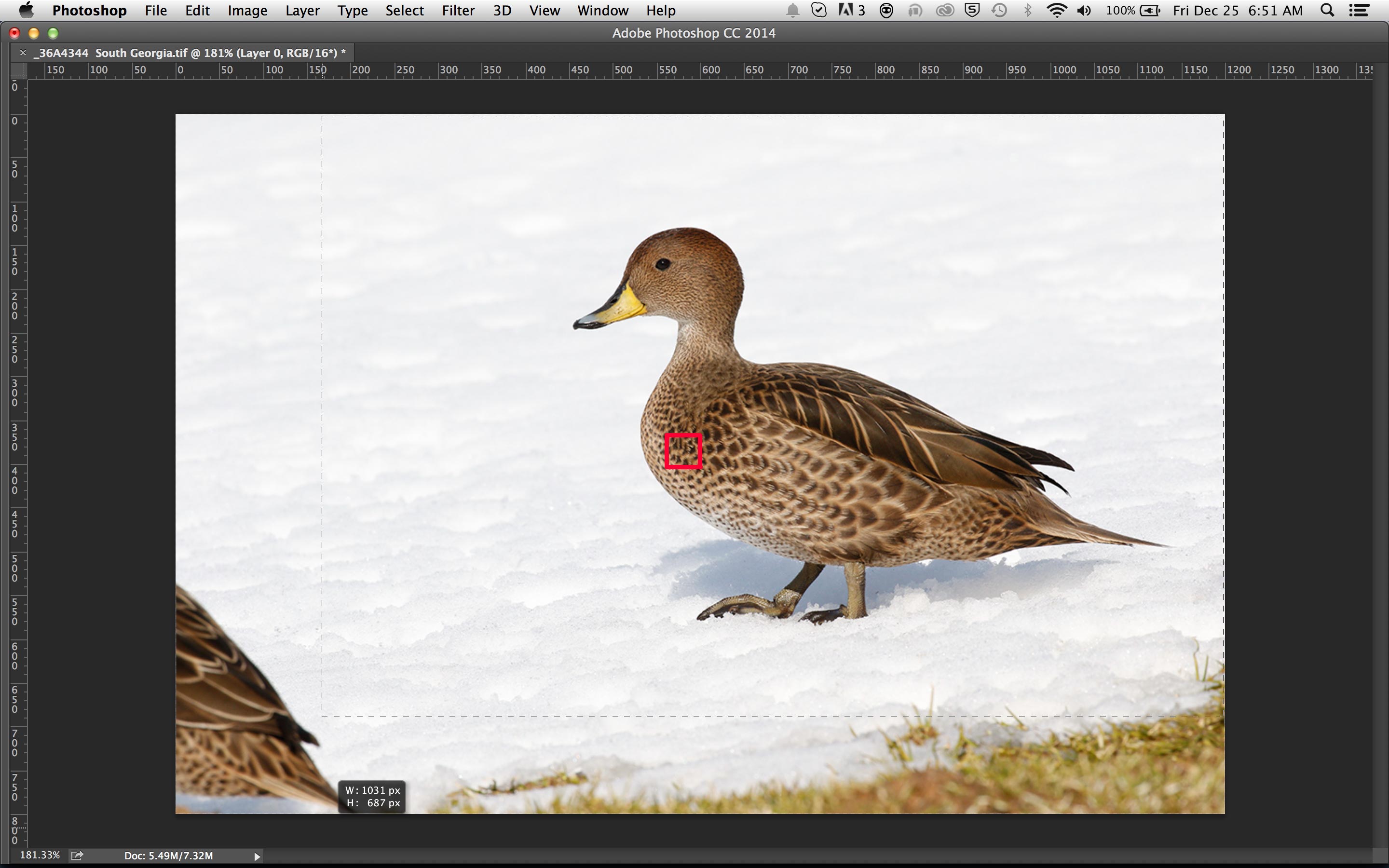
|
|
The complete JPEG here represents the full frame original capture.
|
Creating the Pure Snow Background
The full frame capture above represents the full frame original image. The dotted line shows the approximate crop. I added the red square in Photoshop to show the position of the selected AF sensor. Note the extraneous grass in the lower right corner that ruined the pure snow background. I executed one of the flip and flop tutorials from APTATS II to cover the offending grass; this technique involves adding a Regular Layer Mask to refine the repair.
Digital Basics
Everything that I did to optimize today’s image–did you notice the bill clean-up?–is covered in detail in my Digital Basics File–written in my easy-to-follow, easy-to-understand style. Are you tired of making your images look worse in Photoshop? Digital Basics File is an instructional PDF that is sent via e-mail. It includes my complete digital workflow, dozens of great Photoshop tips, details on using all of my image clean-up tools, the use of Contrast Masks, several different ways of expanding and filling in canvas, all of my time-saving Keyboard Shortcuts, Quick Masking, Layer Masking, and NIK Color Efex Pro basics, Contrast Masks, Digital Eye Doctor techniques, using Gaussian Blurs, Tim Grey Dodge and Burn, a variety of ways to make selections, how to create time-saving actions, the Surface Blur settings that I use to smooth background noise, and tons more.
APTATS I & II
Learn the details of advanced Quick Masking techniques in APTATS I. Learn Advanced Layer Masking Techniques in APTATS I. Mention this blog post and apply a $5 discount to either with phone orders only. Buy both APTATS I and APTATS II and we will be glad to apply at $15 discount with phone orders. Please call Jim or Jennifer weekdays at 863-221-2372 to take advantage of this special offer. You can find the same deal in the BAA Online Store here.
|

|
|
You can order your copy of “The Photographers’ Guide to Canon Digital Photo Professional 4.0” (aka the DPP 4 Raw Conversion eGuide) by Arash Hazeghi and Arthur Morris by clicking here.
|
The DPP 4 eGuide (PDF)
The RAW file for today’s image was of course converted in DPP 4. Learn how and why I and many other discerning photographers choose and use only DPP 4 to convert their Canon RAW files in the DPP 4 RAW Conversion Guide by Arash Hazeghi and yours truly. The latest version supports all of the newer Canon camera bodies and several older models including the EOS-7D and the EOS-1D Mark IV. The DPP IV Guide is the ideal companion to the 7D Mark II User’s Guide, a runaway best seller.
The DPP 4 eGuide (PDF) Updated for 1D Mark IV and the original 7D
The DPP 4 eGuide was recently updated to include the luminance and chrominance noise reduction values for both the 1D Mark IV and the original 7D. If you purchased your copy from BAA please e-mail Jim and request the DPP 4 1d IV/7D update. Please be sure to cut and paste page 1 into your e-mail as proof of purchase.
DPP 4 Kudos
From Richard Gollard via e-mail:
I have been doing tons of studying the books and PDFs that I have purchased from BIRDS AS ART. And I have to say that after reading the DPP 4 conversion guide that you did with Arash Hazeghi I tried DPP 4 and was blown away with the difference from the conversions that I made with Adobe Photoshop and Lightroom. Thanks for the consistently great information.
|
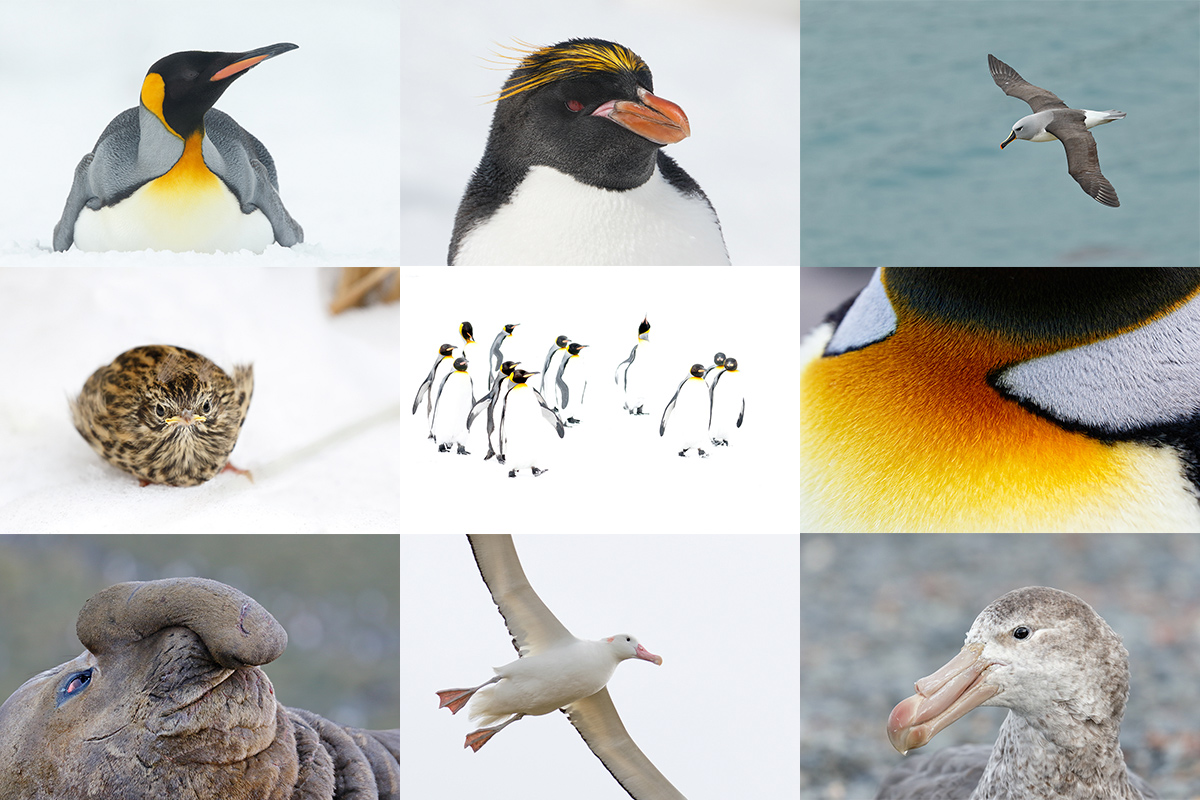
|
|
All images on the card were created on the 2015 Cheesemans’ South Georgia Expedition. From top left clockwise to center: King Penguin resting on Snow, Fortuna Bay; Macaroni Penguin in snow, Cooper Island; Grey-headed Albatross, Elsehul; King Penguin neck abstract, Godthul; Northern Giant Petrel, Undine Harbor; adult Wandering Albatross, Prion Island; Elephant Seal, Undine Harbor; South Georgia Pipit fledgling/thanks Joe Kaplan! Fortuna Bay; high key King Penguins in snow, Fortuna Bay.
Card design and all images copyright 2015: Arthur Morris/BIRDS AS ART
|
The Cheesemans’ 2016 OCT/NOV South Georgia/Falklands Expedition
If reading last Saturday’s blog post here put a thought in your mind about joining the BIRDS AS ART group on the Cheesemans’ 2016 OCT/NOV South Georgia/Falklands Expedition, please shoot me an e-mail with the words “Cheesemans’ Last Southern Ocean Expedition” cut and pasted into the Subject Line with any questions or if you wish to receive additional inspiration. This will surely be my last ship-based trip to the Southern Ocean as well.
|
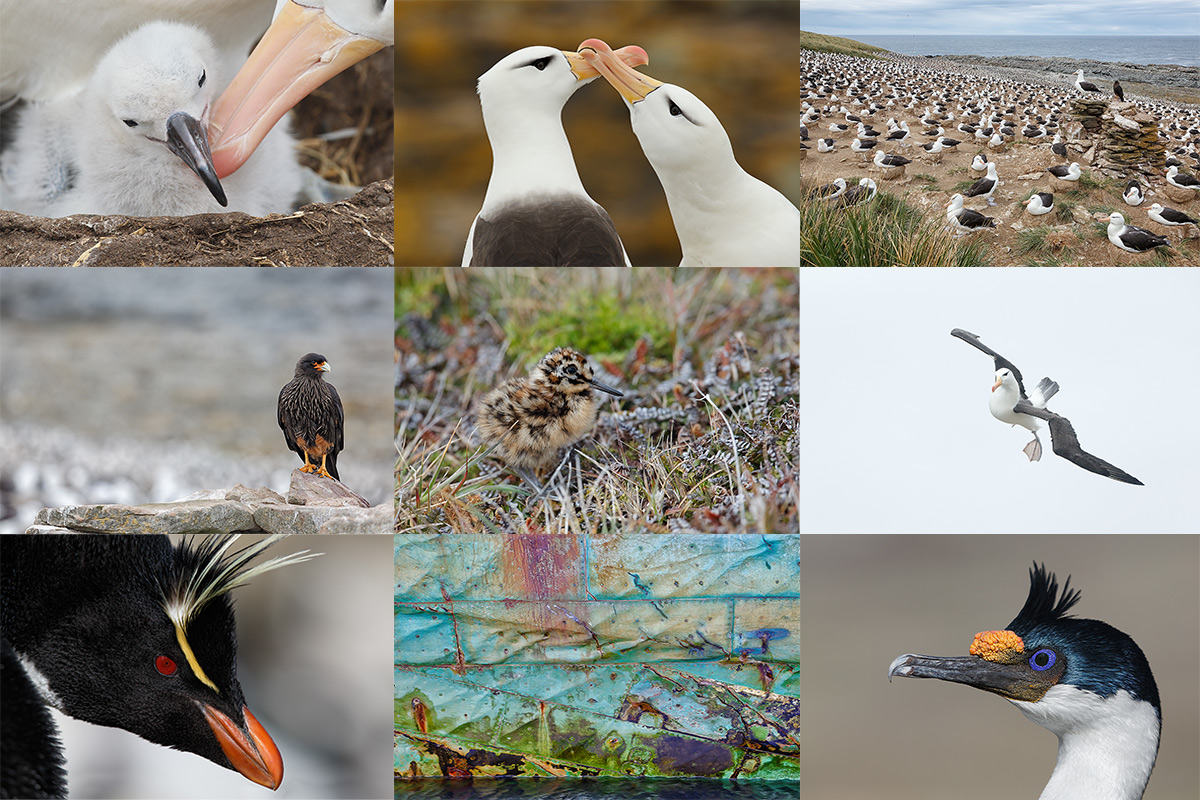
|
|
All of the images on this card were created in the Falklands on the 2014 Cheesemans’ Southern Oceans Expedition. From top left clockwise to center: Black-browed Albatross tending chick, Steeple Jason Island; Black-browed Albatross courting pair, New Island; the Black-browed Albatross colony at Steeple Jason Island; Black-browed Albatross landing, New Island; King Cormorant head portrait, New Island; hull detail/derelict minesweeper, New Island; Rockhopper Penguin head portrait in bright sun, New Island; Striated Caracara, Steeple Jason Island; Magellanic Snipe chick, Sea Lion Island.
|
An Expedition Overview
Experience the vibrant spring of South Georgia, a true Antarctic wildlife paradise. Observe and photograph wildlife behaviors seldom seen beneath the towering, snow-blanketed mountains that dominate the island’s landscape. Southern Elephant Seal bulls fight for breeding rights while females nurse young, overlook vast colonies of loafing King Penguins, watch Macaroni Penguins cavort in the snow, photograph handsome Gray-headed Albatrosses in flight or attending to their cliffside nests and awkward Wandering Albatrosses attempting first flight. The itinerary includes six landing days on South Georgia and three landing days in the Falklands to observe too cute Rockhopper Penguins, Magellanic Penguins standing watch at their nesting burrows, and more Black-browed Albatrosses than you could ever imagine. To commemorate Shackleton’s famous self-rescue crossing South Georgia, CES also offers an optional trek retracing his steps. With Cheesemans’ twenty years of experience in the Antarctic region, they commit to an in-depth exploration of one of the densest wildlife spectacles found anywhere in the world, and with only 100 passengers, they routinely give you the opportunity to completely immerse yourself on each landing.
Two of the scheduled Falklands’ landings, New Island and especially Steeple Jason Island, rival the best locations on South Georgia. Those will likely include Salisbury Plain, St. Andrews Bay, Elsehul, Fortuna Bay, and either Cooper Island or Hercules Bay (for Macaroni Penguins).
Why Sign Up Through BIRDS AS ART?
If you have been thinking and dreaming of finally visiting South Georgia, this is the trip for you. There will likely never be another trip like this as the best outfit in the Southern Oceans business will not be returning after 2016…. Quit dreaming and act now. Though I will not be an expedition staff member on this trip, those who have traveled with me know that I cannot help but teach. And I will be doing a introductory photography program for the entire ship on our crossing to South Georgia. All who sign up via BAA will receive a free copy the new Southern Ocean Photography Guide (a $100 value) that I am currently working on. It will include pre-trip gear and clothing recommendations and a ton of info that you will find to be invaluable.
I will hold informal pre-landing briefings aboard ship so that when you land you know exactly what to expect and where to go. I will be available on the ship to review your images, answer your questions, and conduct informal over-the shoulder Photoshop sessions. And best of all, everyone who signs up under the auspices of BAA are invited to tag along with me on the landings where I will be glad to offer invaluable in-the-field advice. And the same goes for the shipboard birds in flight and marine mammal photographic sessions.
Again, if you would like to join me on what will truly be a once in a lifetime opportunity to a wondrous place, please shoot me an e-mail with the words “Cheesemans’ Last Southern Ocean Expedition” cut and pasted into the Subject Line.
You can learn more about the trip here. If you sign up on your own be sure to mention that you would like to be part of the BAA Group. I’d be glad to answer any and all question via e-mail or by phone at 863-692-0906.
Important Notes
#1: If you fail to e-mail me as noted directly above, and register directly with CES you MUST let them know that you would like to be part of the BIRDS AS ART group.
#2: Joining the BIRDS AS ART group as above will not cost you one penny.
For additional details on the trip and the ship, see Saturday’s blog post here.


Please Remember to use our Affiliate Links 🙂
To show your appreciation for my continuing efforts here, we ask, as always, that you get in the habit of using my B&H affiliate links on the right side of the blog for all of your photo and electronics purchases. Please check the availability of all photographic accessories in the BIRDS AS ART Online Store, especially the Mongoose M3.6 tripod heads, Gitzo tripods, Wimberley heads and plates, LensCoats and accessories, and the like. We sell only what I have used, have tested, and can depend on. We will not sell you junk. We know what you need to make creating great images easy and fun. And we are always glad to answer your gear questions via e-mail. I just learned that my account was suspended during my absence; it should be up and running by Monday at the latest.
I would of course appreciate your using our B&H affiliate links for all of your major gear, video, and electronic purchases. For the photographic stuff mentioned in the paragraph above we, meaning BAA, would of course greatly appreciate your business. Here is a huge thank you to the many who have been using our links on a regular basis and visiting the BAA Online store as well.
Facebook
Be sure to like and follow BAA on Facebook by clicking on the logo link upper right. Tanks a stack!
Typos
In all blog posts and Bulletins, feel free to e-mail or to leave a comment regarding any typos or errors. Just be right 🙂
December 24th, 2015 What’s Up?
I answered a few zillion more e-mails yesterday and began work on a companion CD book for the solo San Diego exhibit. I worked hard with the folks from Cheesemans’ organizing the BIRDS AS ART group on next October’s South Georgia/Falklands expedition, their last. I learned from Ted Cheeseman that this voyage is now 75% full so if you are planning on joining us and would like to become part of the BAA group, please scroll down and do not tarry.


|
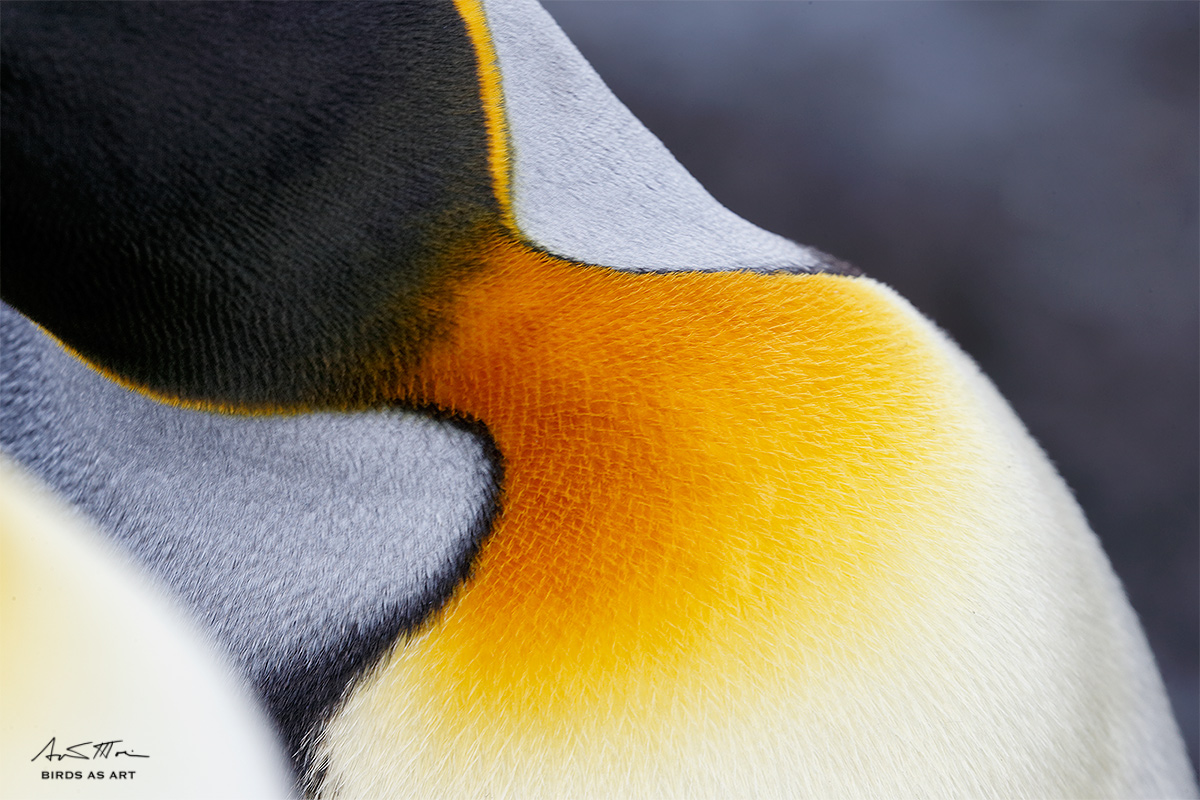
|
|
This image was created at Salisbury Plain on South Georgia on our last day of landings on the memorable 2015 Cheesemans’ South Georgia Expedition with the Induro GIT 304L tripod/Mongoose M3.6-mounted Canon EF 100-400mm f/4.5-5.6L IS II USM lens, the Canon Extender EF 1.4X III (at 560mm), and the rugged Canon EOS-1D X. ISO 400. Evaluative metering +1/3 stop: 1/200 sec. at f/16. AWB.
Center AF point (Manual selection)/AI Servo/Rear Focus AF as framed was active at the moment of exposure. Click here to see the latest version of the Rear Focus Tutorial. Click on the image to see a larger version.
King Penguins neck abstract
|
Canon 100-400II/AF with which Teleconverter?
I receive several e-mails each week asking if the new 100-400II will focus with this camera or that teleconverter. First off, assuming that you have one of the newer Canon camera bodies (5DS R, 5D S, 1D X, 5D III, or 7D II), your body will focus to f/8. As the 100-400 II is effectively an f/5.6 lens, that means that it will autofocus with the 1.4 X III TC at effective f/8, and that it will not autofocus with the 2X III TC at effective f/11. When working with static subject the latter combination can produce some amazing images as long as you (gasp!) focus manually and are working with a sturdy tripod. See the blog post here for a wonderfully sharp example of what is possible.
Do understand that when you add a 1.4X III TC to the 100-400 II (or to any f/5.6 lens) with any camera body, initial focusing acquisition will be slowed somewhat as the AF system needs light (and contrast) so see; adding a 1.4X TC robs the system of one stop of light, going from f/5.6 to f/8 That is one reason that I love using this combination on sunny days (although it worked just fine in cloudy bright conditions for today’s featured image). Note also that with a 1.4X TC on the 100-400 II or on any f/5.6 lens that only the center AF point (plus the 4 assist points if you go to Expand) will be available.
What do you think of the image design: disappointing or fortuitous?
On every South Georgia trip that I have made–5 in all–I create many hundreds if not several thousand tight images of the necks of King Penguins. These birds are both large and curious. Working with a full frame camera for today’s image I did not hesitate to add the 1.4X III TC to the mix.
I was excited to see that the main subject in today’s image had bent its head over backwards creating a new and different shape and new and different patterns. But just as I pressed the shutter button I realized that another penguin had walked into the frame.
What do you think? Do you like the additional penguin breast in the lower left corner? Or do you hate it? Either way, be sure to let us know why. I will share my thoughts with you here in a day or three at most.
Blog Interactivity
Please remember that more learning takes place when the blog is truly interactive. You will learn more by pondering a question and leaving a well thought out response. And when you do leave a comment, everyone else learns more as well.
Depth-of-field Questions
Why f/16 for this image? The extraneous penguin’s breast was only about two inches in front of the subject; why didn’t it show more detail?
|

|
|
All images on the card were created on the 2015 Cheesemans’ South Georgia Expedition. From top left clockwise to center: King Penguin resting on Snow, Fortuna Bay; Macaroni Penguin in snow, Cooper Island; Grey-headed Albatross, Elsehul; King Penguin neck abstract, Godthul; Northern Giant Petrel, Undine Harbor; adult Wandering Albatross, Prion Island; Elephant Seal, Undine Harbor; South Georgia Pipit fledgling/thanks Joe Kaplan! Fortuna Bay; high key King Penguins in snow, Fortuna Bay.
Card design and all images copyright 2015: Arthur Morris/BIRDS AS ART
|
The Cheesemans’ 2016 OCT/NOV South Georgia/Falklands Expedition
If reading last Saturday’s blog post here put a thought in your mind about joining the BIRDS AS ART group on the Cheesemans’ 2016 OCT/NOV South Georgia/Falklands Expedition, please shoot me an e-mail with the words “Cheesemans’ Last Southern Ocean Expedition” cut and pasted into the Subject Line with any questions or if you wish to receive additional inspiration. This will surely be my last ship-based trip to the Southern Ocean as well.
|

|
|
All of the images on this card were created in the Falklands on the 2014 Cheesemans’ Southern Oceans Expedition. From top left clockwise to center: Black-browed Albatross tending chick, Steeple Jason Island; Black-browed Albatross courting pair, New Island; the Black-browed Albatross colony at Steeple Jason Island; Black-browed Albatross landing, New Island; King Cormorant head portrait, New Island; hull detail/derelict minesweeper, New Island; Rockhopper Penguin head portrait in bright sun, New Island; Striated Caracara, Steeple Jason Island; Magellanic Snipe chick, Sea Lion Island.
|
An Expedition Overview
Experience the vibrant spring of South Georgia, a true Antarctic wildlife paradise. Observe and photograph wildlife behaviors seldom seen beneath the towering, snow-blanketed mountains that dominate the island’s landscape. Southern Elephant Seal bulls fight for breeding rights while females nurse young, overlook vast colonies of loafing King Penguins, watch Macaroni Penguins cavort in the snow, photograph handsome Gray-headed Albatrosses in flight or attending to their cliffside nests and awkward Wandering Albatrosses attempting first flight. The itinerary includes six landing days on South Georgia and three landing days in the Falklands to observe too cute Rockhopper Penguins, Magellanic Penguins standing watch at their nesting burrows, and more Black-browed Albatrosses than you could ever imagine. To commemorate Shackleton’s famous self-rescue crossing South Georgia, CES also offers an optional trek retracing his steps. With Cheesemans’ twenty years of experience in the Antarctic region, they commit to an in-depth exploration of one of the densest wildlife spectacles found anywhere in the world, and with only 100 passengers, they routinely give you the opportunity to completely immerse yourself on each landing.
Two of the scheduled Falklands’ landings, New Island and especially Steeple Jason Island, rival the best locations on South Georgia. Those will likely include Salisbury Plain, St. Andrews Bay, Elsehul, Fortuna Bay, and either Cooper Island or Hercules Bay (for Macaroni Penguins).
Why Sign Up Through BIRDS AS ART?
If you have been thinking and dreaming of finally visiting South Georgia, this is the trip for you. There will likely never be another trip like this as the best outfit in the Southern Oceans business will not be returning after 2016…. Quit dreaming and act now. Though I will not be an expedition staff member on this trip, those who have traveled with me know that I cannot help but teach. And I will be doing a introductory photography program for the entire ship on our crossing to South Georgia. All who sign up via BAA will receive a free copy the new Southern Ocean Photography Guide (a $100 value) that I am currently working on. It will include pre-trip gear and clothing recommendations and a ton of info that you will find to be invaluable.
I will hold informal pre-landing briefings aboard ship so that when you land you know exactly what to expect and where to go. I will be available on the ship to review your images, answer your questions, and conduct informal over-the shoulder Photoshop sessions. And best of all, everyone who signs up under the auspices of BAA are invited to tag along with me on the landings where I will be glad to offer invaluable in-the-field advice. And the same goes for the shipboard birds in flight and marine mammal photographic sessions.
Again, if you would like to join me on what will truly be a once in a lifetime opportunity to a wondrous place, please shoot me an e-mail with the words “Cheesemans’ Last Southern Ocean Expedition” cut and pasted into the Subject Line.
You can learn more about the trip here. If you sign up on your own be sure to mention that you would like to be part of the BAA Group. I’d be glad to answer any and all question via e-mail or by phone at 863-692-0906.
Important Notes
#1: If you fail to e-mail me as noted directly above, and register directly with CES you MUST let them know that you would like to be part of the BIRDS AS ART group.
#2: Joining the BIRDS AS ART group as above will not cost you one penny.
For additional details on the trip and the ship, see Saturday’s blog post here.


Please Remember to use our Affiliate Links 🙂
To show your appreciation for my continuing efforts here, we ask, as always, that you get in the habit of using my B&H affiliate links on the right side of the blog for all of your photo and electronics purchases. Please check the availability of all photographic accessories in the BIRDS AS ART Online Store, especially the Mongoose M3.6 tripod heads, Gitzo tripods, Wimberley heads and plates, LensCoats and accessories, and the like. We sell only what I have used, have tested, and can depend on. We will not sell you junk. We know what you need to make creating great images easy and fun. And we are always glad to answer your gear questions via e-mail. I just learned that my account was suspended during my absence; it should be up and running by Monday at the latest.
I would of course appreciate your using our B&H affiliate links for all of your major gear, video, and electronic purchases. For the photographic stuff mentioned in the paragraph above we, meaning BAA, would of course greatly appreciate your business. Here is a huge thank you to the many who have been using our links on a regular basis and visiting the BAA Online store as well.
Facebook
Be sure to like and follow BAA on Facebook by clicking on the logo link upper right. Tanks a stack!
Typos
In all blog posts and Bulletins, feel free to e-mail or to leave a comment regarding any typos or errors. Just be right 🙂
December 23rd, 2015
|
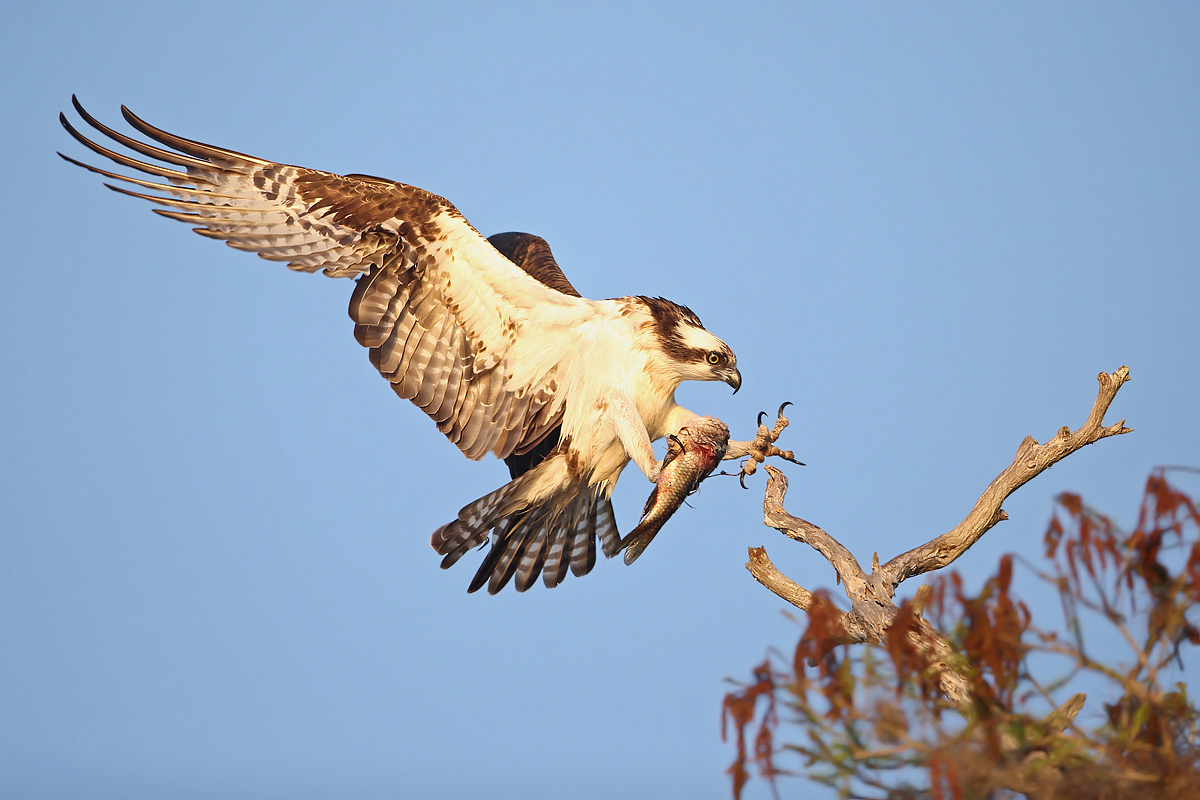
|
|
Osprey landing with fish. Image copyright 2013: Jim Neiger/Flight School Photography
|
Jim Neiger’s Osprey Heaven Workshops 2016
Lake Blue Cypress (Vero Beach), Florida
Flight School Photography returns to Lake Blue Cypress for the seventh year and will be featuring two, five day workshops in spring, 2016. The workshops will be conducted by expert bird photographer Jim Neiger, who knows the lake and surrounding area like no-one else. Jim has spent the past several years perfecting his unique techniques for photographing birds in flight using large telephoto lenses, hand held. The focus of these workshops will be learning Jim’s hand held, long lens techniques for photographing birds in flight and in other action. The workshops will be held in some of the most beautiful, wild, and unspoiled wilderness areas of central Florida.
Each workshop will include a four hour classroom session, welcome dinner, four morning photography sessions, and three afternoon photography sessions. Each photography session will be of three to four hours in duration. Five of the photography sessions will be conducted via a specially configured pontoon boat that has been customized for photography from the water (weather permitting). The remaining photography sessions will be land based sessions in the field. The workshops will be limited to five participants so that everyone may photograph in comfort and receive personalized instruction.
The photography sessions by boat will be held on the unspoiled and unparalleled Lake Blue Cypress. This spectacularly beautiful lake is virtually free of civilization and man made elements. The lake is surrounded by ancient cypress swamp and marshy wetlands. Here, the gorgeous cypress trees grow from the lake bottom, surrounded on all sides by water. Osprey nest by the hundreds in these trees, and participants will be able to photograph them as they fly to and fro, dive for fish, gather nesting materials, and feed their young chicks. Some of the nests are actually at or below eye level when standing in the boat. The only distraction in this pristine, wilderness environment is the constant cries of the Osprey as they frolic in the air and defend their nests from other birds.
Lake Blue Cypress is also a landscape photographers dream. The horizons contain nothing of man’s influence and only the beauty of the real Florida wilderness. Perches and backgrounds are spectacular beyond belief. March and April are the best months to be at Lake Blue Cypress. Many of the birds are actively nesting and rearing their young during this time. Wildflowers cover the stumps and trees like blankets of radiant color. The skies glow with spectacular, multi-hued sunrises and sunsets. Hundreds of different species of birds are possible including the typical Florida waders and water fowl. Large Alligators are commonly seen sunning themselves on top of the fallen trees and stumps amidst the colorful wildflowers. The biggest problem for a photographer here is deciding which subject to photograph. Even the weather cooperates this time of year. It is the dry season and clear, sunny days are the most common weather condition.
|
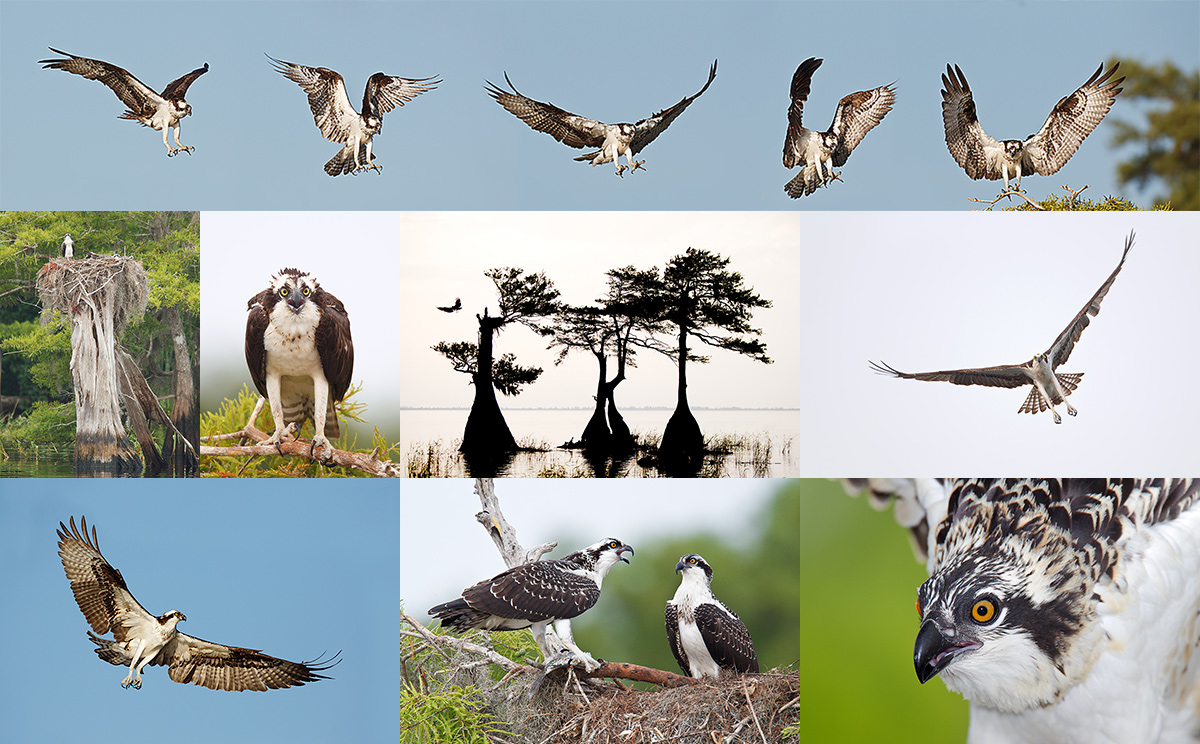
|
|
These are artie’s images from Lake Blue Cypress trips with Jim Neiger.
|
The photography sessions on land will be held in remote areas of southern Osceola County. Here, participants are likely to have opportunities to photograph birds that are endangered and rarely seen. Possible species include: Whooping Cranes, Swallow-tailed Kites, Great Horned Owls, Barred Owls, and Red Shoulder Hawks, among others. Sandhill Cranes, a common bird in Central Florida, are tame enough to approach as closely as you like. Participants will also learn how to safely use bird song recordings to attract birds. Jim has developed his own, innovative techniques for using recordings to attract birds, in such a way, that amazing photographic opportunities are common when they would be almost impossible otherwise. This includes special techniques that encourage birds to fly and land in desired ways, which provide spectacular opportunities for flight images and images on perches chosen for their beauty.
Jim consistently produces amazing flight images. His imagination and dedication have resulted in his developing many new techniques, techniques that can only be learned from Jim. His Flight School Photography Workshops are a must for any serious nature photographer. artie
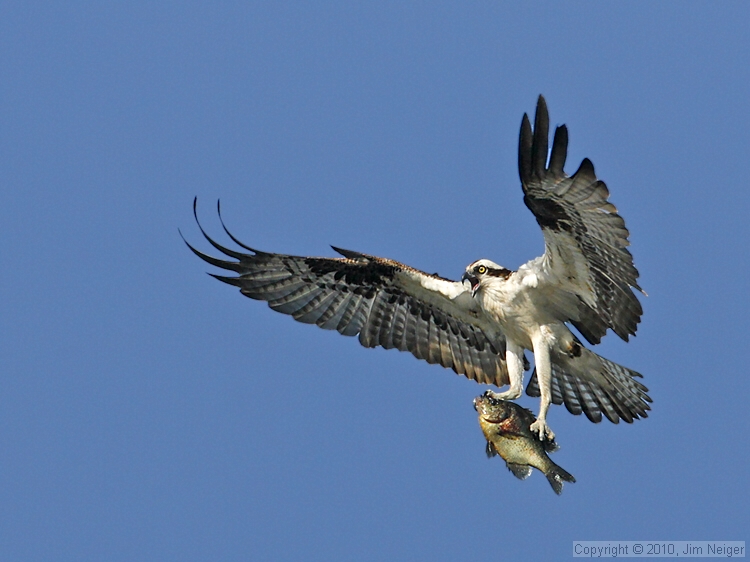
|
|
Osprey landing with bream. Image copyright 2010: Jim Neiger/Flight School Photography
|
Workshop Dates
Workshop LBC-1: April 17-21, 2016
Workshop LBC-2: April 24-28, 2016
|
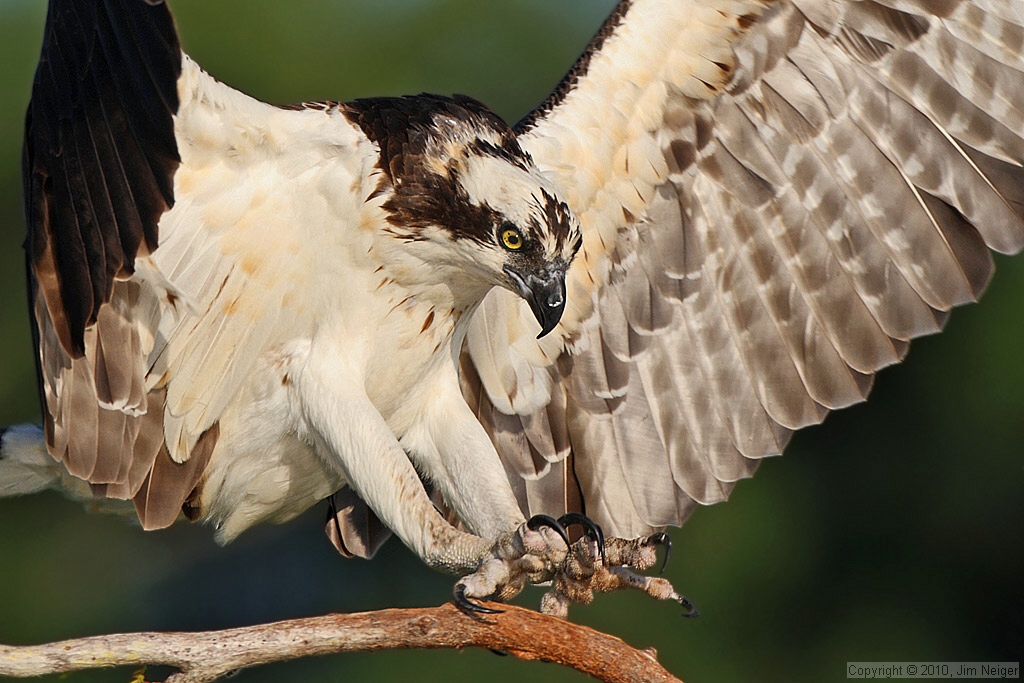
|
|
Osprey landing tight. Image copyright 2010: Jim Neiger/Flight School Photography
|
Workshop Itinerary
Day 1 (afternoon/evening ): Morning arrival in Vero Beach, which is the base location for the workshops. There will be a four hour classroom session from 2:00pm to 6:00pm in the hotel meeting room. This will be followed by a welcome dinner with the group. The classroom instruction will focus on using hand held techniques for photographing birds in flight to prepare participants for the subsequent photography sessions.
Days 2: Morning photography session via boat on Lake Blue Cypress. Mid-day siesta and lunch break on your own. Afternoon/evening photography session on Lake Blue Cypress. Late dinner on your own.
Day 3: Morning photography session via boat on Lake Blue Cypress. Mid-day siesta and lunch break. Afternoon/evening photography session on Lake Blue Cypress. Late dinner on your own.
Day 4: Mini caravan to land locations for morning photography session. Mid-day siesta and lunch break. Afternoon/evening photography session. Dinner on your own.
Day 5 (morning): Morning photography session via boat on Lake Blue Cypress.
Please note: The itinerary may be re-arranged to take advantage of the best weather conditions for photography sessions by boat.
|
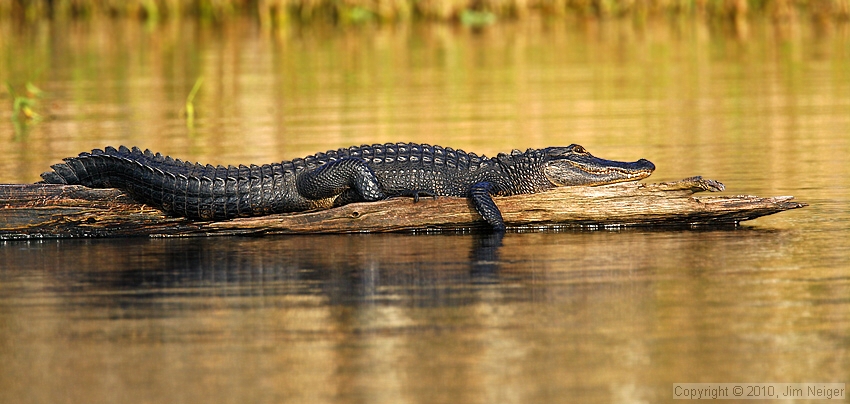
|
|
American Alligator on log. Image copyright 2010: Jim Neiger/Flight School Photography
|
Workshop Costs and Payment
The cost of each workshop is $1750 per person. Each workshop includes a four hour formal classroom instruction session, a welcome dinner, 4 morning photography sessions, and 3 afternoon photography sessions. The photography sessions include personalized instruction in the field. Each participant will receive a copy of Jim’s e-book “Flight Plan – How to Photograph Birds in Flight” when they sign up for the workshop. Discounted lodging is available, but is not included in the workshop fee. A $875 non-refundable deposit is required to reserve a spot in a workshop. The remaining $875 is due 30 days before the start date of the workshop. If you are unable to attend the workshop, after paying the balance, the balance payment will be refunded ONLY if your spot can be filled, on short notice, from the waiting list. All workshop payments must be made by check or money order. Credit cards are not accepted.
|
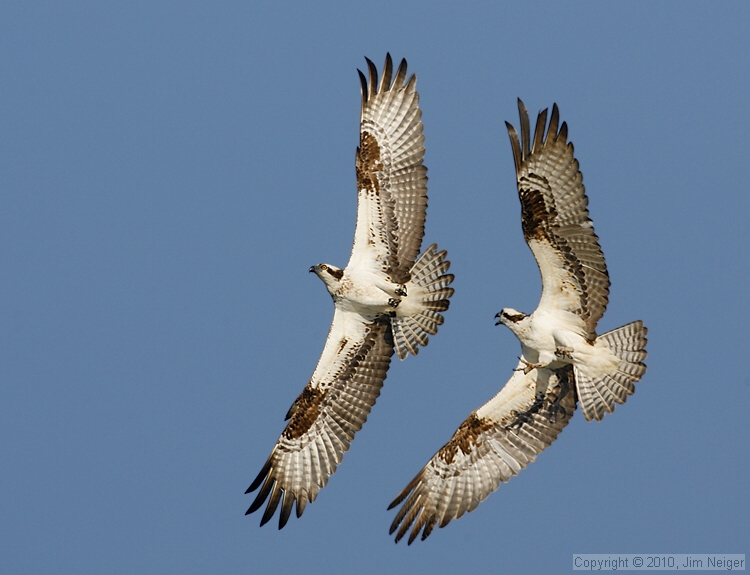
|
|
Juvenile Ospreys squabbling in flight. Image copyright 2010: Jim Neiger/Flight School Photography
|
Participant Requirements
Participants should have working knowledge of how to create a properly exposed image, a telephoto lens of 400mm or more (300mm with a teleconverter is acceptable), and be physically capable of holding their camera and lens up to their eye in shooting position for at least 20 seconds. Participants must also have a vehicle to travel to and from the photography locations.
|
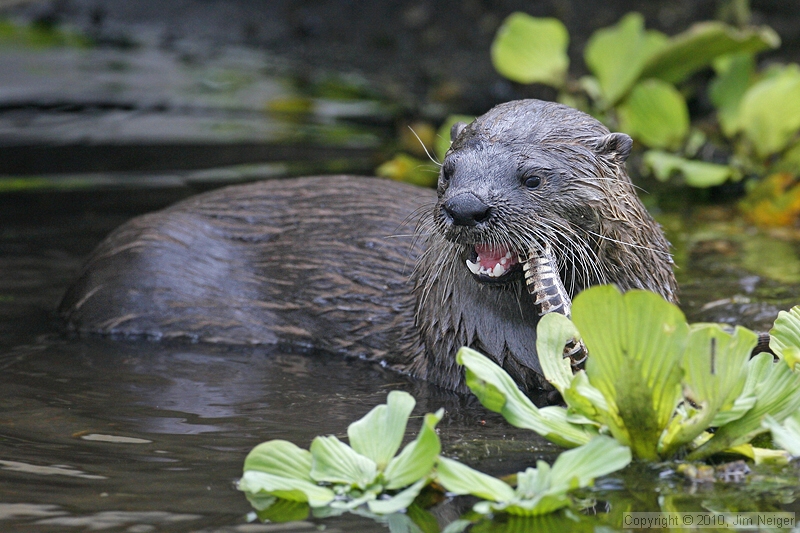
|
|
River Otter eating snake. Image copyright 2010: Jim Neiger/Flight School Photography
|
Lodging and Logistics
Workshop participants who require lodging during the workshop should stay at the hotel in Vero Beach where the classroom sessions will be conducted. Participants arriving via air arrive at the Orlando International Airport, which is the closest major airport to Vero Beach. Rental vehicles are available at the airport. Flight School Photography will assist participants with arranging the sharing of vehicles and/or lodging if desired. Detailed information will be provided when you sign up for the workshop or upon request. Lodging, transportation, and meals (except for welcome dinner) are not included.
Learn more here. View Jim’s incredible image gallery here. And see some of artie’s images here.
|
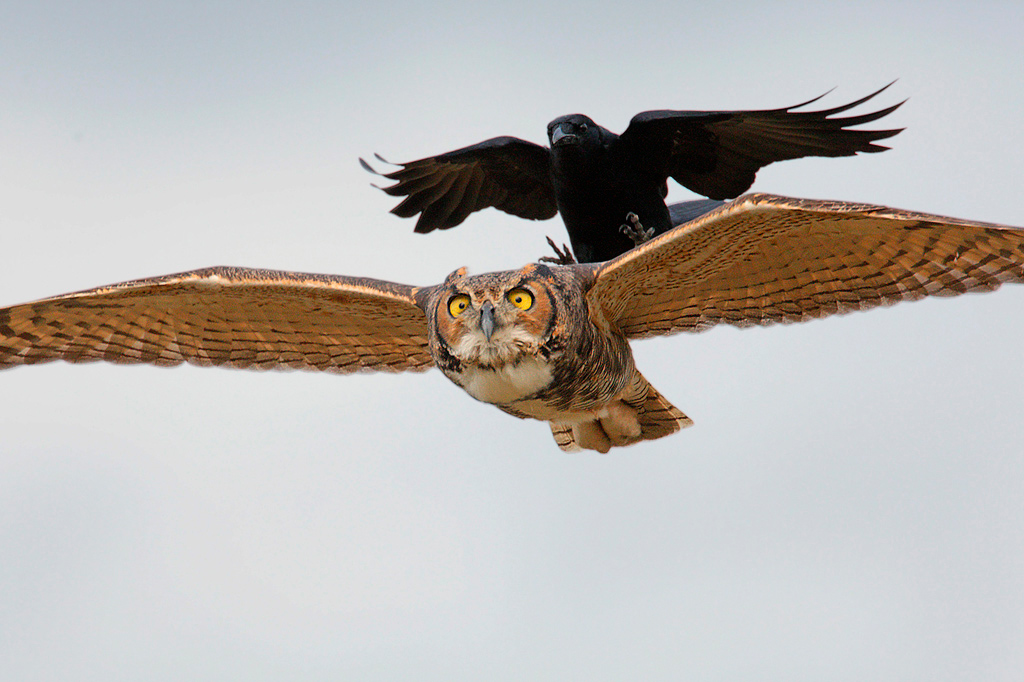
|
|
Great Horned Owl being harassed by Fish Crow. BBC Honored image copyright: Jim Neiger/Flight School Photography
|
Flight School Custom Anytime Workshops
Flight School Photography offers private, customized workshops, September thru May, in some of the most beautiful, wild, and unspoiled areas of central Florida. Your instructor and guide, Jim Neiger, has spent several years observing, studying, and photographing the varied birds near his home in central Florida and knows this avian rich area like no one else. If you prefer, Jim will travel to a location selected by you to provide personal instruction.
These individual or small group workshops are tailored exclusively to the participants’ interests, goals, and schedule. Workshops are conducted by boat, on land, or a combination of both. Personalized instruction lets you make the most of your time. The workshops can range from a single half-day workshop to multi-day or week-long workshops. Snacks and drinks are provided during every workshop session.
You have the following options: scheduling a private, individual custom workshop; putting together a small group of photographers for a customized workshop; or having Jim travel to your location to provide a custom workshop. You can also choose the species you wish to focus on and/or the topics you would like to learn more about. Jim’s experience in the central Florida area allows him to locate the most sought after species in settings and conditions that are optimal for photography.
Custom Workshops by Boat
Jim’s pontoon boat was purchased and customized specifically for use during photography workshops. It is roomy, comfortable, and stable. The boat is equipped with an extremely quiet, four-stroke motor for silent cruising. It also has a powerful, silent, electric trolling motor with wireless remote control. This allows Jim to position the boat precisely and silently. The boat has a capacity of twelve people, but Jim limits the number of participants to five or less so that everyone has room to photograph in comfort. The boat can be configured with no top, a half canopy to provide shelter from sun and rain, or with a half enclosure that can completely protect participants from the elements. Using the boat allows close access to some of the most difficult and desirable subjects in North America. Many of the images of these subjects in their wetland habitat would not be possible from land.
Custom Workshops on Land
Land-based sessions are held in a number of wild and remote locations of central Florida. Jim has spent several years learning the out-of-the-way wilderness areas in the region. He has also written a best selling guide to photographing birds in central Florida. The variety of birds in the area is astounding; Jim knows where to find them and how best to photograph them. Participants will need to provide their own vehicle for the land-based workshops, unless there is only 1 photographer.
Both land and boat workshops are likely to provide participants with opportunities to photograph birds that are uncommon and rarely seen. Possible subjects include: Crested Caracara, Sandhill Cranes, Whooping Cranes, Barred and Great Horned Owls, Bald Eagles, Osprey, Snail Kites, Red-Shouldered Hawks, Red Cockaded Woodpeckers, Pileated Woodpeckers, Limpkins, Ibis, Wood Storks, Purple Gallinules, various wading birds, warblers, sparrows, and many others too numerous to list.
Custom Workshop Instruction
Custom workshops may also include personalized, in-the-field instruction; formal classroom instruction; or an introductory slide presentation, if desired. Topics may include instruction devoted to learning or practicing:
· Jim’s unique handheld techniques for photographing birds in flight using long telephoto lenses.
· Jim’s unique techniques for using recordings safely to attract and photograph birds successfully
· Making proper exposures working in manual exposure mode
· Other nature photography topics of your choice
Learn more about Jim’s Flight School Custom Anytime Workshops here. See the spectacular image gallery here. See the custom workshop rates here.
Contact Information
Contact Information: Jim Neiger, Flight School Photography, Inc. 550 Basin Drive, Kissimmee, FL 34744-4804
Cell phone: (407) 247-5200. e-mail.
Flight School website.
Flight Plan
I can say without a doubt that after spending more than two months (part time) editing Jim Neiger’s great e-Guide–Flight Plan–two years ago–that my flight photography improved by leaps and bound whether I am working off a tripod or hand holding. His explanation of the bumping the focus technique finally sunk in. Learning to use this technique regularly is a huge help for any all types of flight photography.
You can learn more about Flight Plan here or order a copy by clicking here.
Bob Hollowell’s Flight Plan Comments
I just wanted to send kudos to both you and Jim Neiger for the excellent E-book that you referenced in a recent BAA blog post. I immediately purchased a copy, and have finished my first read and will now read it a second time just to make sure I’m ready to take it to the field. My favorite haunt is Squaw Creek NWR and I’ve stumbled & fumbled with flight photos using both tripod & monopod as support for my Canon 7D, and just can’t seem to come up with real sharp photos using that method. Jim’s text is well written, and really puts flight photography in a whole new perspective for me. I’m 76 years old, and I’m sure I’ll have to experiment with the handholding methodology a bit, but I’m excited at the prospect of applying Jim’s methods.
Thanks again… Bob H.
December 22nd, 2015 What’s Up?
I spent a good part of the day working on exhibit-related tasks, the largest of which was writing the captions for the eleven image groupings: Bosque, Galapagos, Gulls and Terns, Japan in Winter, Midway, Odds and Ends, Puffins and Gannets, San Diego, Shorebirds, the Southern Ocean, and Wading Birds. I hope to be posting some firm info on the exhibit here very soon so that you can make your travel plans 🙂
I continue to feel pretty good and I continue to work very hard for long hours every day par for the course 🙂 I am looking forward to getting back in the pool this week….
Selling Your Used Gear Through BIRDS AS ART
Selling your used (or like-new) photo gear through the BAA Blog or via a BAA Online Bulletin is a great idea. We charge only a 5% commission. One of the more popular used gear for sale sites charges a minimum of 20%. Plus assorted fees! Yikes. The minimum item price here is $500 (or less for a $25 fee). If you are interested please e-mail with the words Items for Sale Info Request cut and pasted into the Subject line :). Stuff that is priced fairly–I offer free pricing advice, usually sells in no time flat. In the past few months, we have sold just about everything in sight. Do know that prices on some items like the EOS-1D Mark IV, the old Canon 500mm, the EOS-7D, and the original 400mm IS DO lens have been dropping steadily. You can see all current listings by clicking here or by clicking on the Used Photo Gear tab on the yellow-orange tab on the right side of the menu bar above.
Things have been heating up on the Used Gear page lately.
- Walt Anderson sold a used Canon 1D X for $3000 yesterday before it was even listed!
- Larry Master sold a Canon EOS-1D Mark IV in excellent condition for $1399 in mid-December 2015.
- Melissa Hahn sold her Canon 400mm f/2.8L IS II lens in mint condition now for $8299 in early December, 2015.
- Monte Brown sold his 300mm 2.8 II lens in near-mint condition for $4499 two days after it was listed in mid-December, 2015.
- Stephen Zarate sold his used Canon 100-400mm L IS zoom lens very quickly in early December for $650, the original asking price.
- Kenton Rowe sold his Canon 200-400mm f/4L IS lens with Internal 1.4X Extender in early December for $9799.
- Brent Bridges sold his Canon 600 II for the full asking price, $9799,in early December 2015.
- Alan and Sara Levine sold their old 300 f/2.8L IS lens in early December for $3175.
- Mike Ederegger sold his AF-S Nikkor 200-400mm F/4 G ED VR II in excellent condition for $ 5199 right after it was listed.
Amazing 7D Mark II/PIXMA PRO-100 Printer Kit Deal
Get a 7D II for a ridiculous $1049 and a free PIXMA PRO-100 Printer. With paper!
Y’all know how much I love my 7D II. Heck, look no further than the featured image in the blog post here and be sure to check out the amazing image quality. That plus the 7D II’s 1.6 crop factor which gives you lots of extra reach with lots of pixels. Also included within this kit is the PIXMA PRO-100 wireless inkjet printer, which prints up to 4800 x 2400 dpi and supports media up to 13 x 19″. An eight-color ink system realizes true color rendition and incorporates three monochrome inks for enhanced density and black and white printing capabilities.


South Georgia OCT/NOV 2016
If you have been thinking of joining me as part of the BIRDS AS ART group on the last-ever Cheesemans’ South Georgia expedition, please note that cabin choices are becoming quite limited. If you are seriously interested, please do not tarry. Scroll down for details or shoot me an e-mail. If you are desperate to make the trip call me at the home/office: 863-692-0906.
|
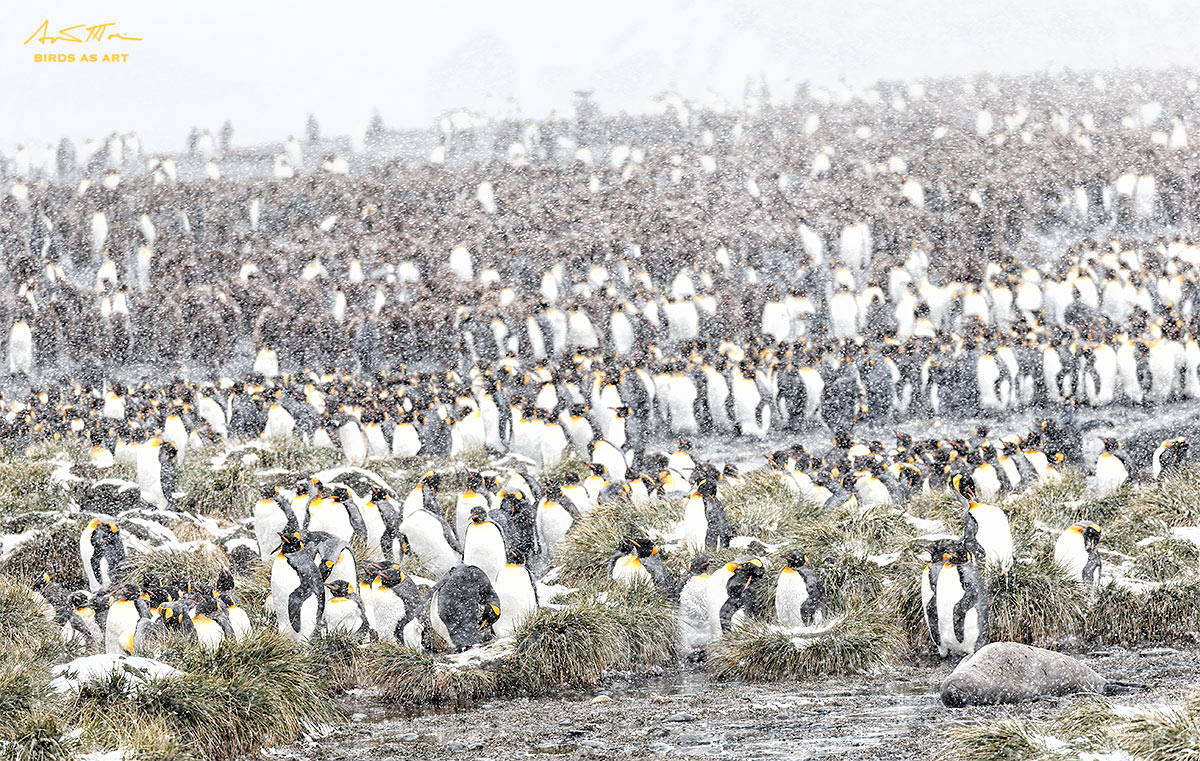
|
|
This image was created at Gold Harbor, South Georgia on the fabulous OCT/NOV 2015 Cheesemans’ South Georgia Expedition with the Induro GIT 304L Tripod/Mongoose M3.6-mounted Canon EF 100-400mm f/4.5-5.6L IS II USM lens (at 400mm and the rugged Canon EOS-1D X. ISO 160. Evaluative metering +1 1/3 stops: 1/500 sec. at f/5.6. Cloudy WB.
Center AF point/AI Servo Expand/Rear Focus AF on the penguin just behind the head of the baby Elephant Seal near the lower right corner and re-compose. Click here to see the latest version of the Rear Focus Tutorial. Click on the image to see a larger version.
King Penguins and friends in snow storm
|
Lots of Bloody Penguins in a Snowstorm!
Yesterday’s blog post, “Life and Death on South Georgia… Warning: Bloody, Gruesome & Gory” was hugely popular. And heck, there were lots of Brits on my last trip to South Georgia so give me a break on today’s title 🙂
Three Great Snowstorm Photo Tips
#1: be sure to have the lens hood on your telephoto lens.
#2: be sure to point your lens away from the wind to avoid getting snow and moisture on the front element.
#3: be sure to have several zip lock plastic bags in your Xtrahand Magnum vest, each with an old cotton t-shirt in it so that when you screw up on #2–don’t worry, you will do it several times during each shooting session–you can turn your back to the wind, remove the lens hood, and dry the front element of your lens…. Why several dry t-shirts? Two reasons: you will invariably get the first t-shirt wet after one or two drying sessions. And, you will continue to forget on #2….
Lessons on Photographing Piles of Penguins…
Photographing the huge assemblages of King Penguins on the Gold Harbor, Salisbury Plains and St. Andrews Bay landings on a Southern Oceans expedition is not as easy as it might seems. There are so many birds that you need to pay attention to lots of small but important details. Keep reading to learn a ton.
Note: this feature was adapted from the lead item in BIRDS AS ART Bulletin #478. You can view that here.
- Get as high a vantage point as possible. This might include climbing atop a ridge or a large hill or simply getting on top of a mound of tussock grass. For today’s featured image I was able to get nicely above the birds by climbing a gentle slope and then finding a stable spot on top of a large tussock; every bit of elevation helps.
- Unless you are doing a frame filling pure pattern shot, strive for a clean lower edge as above.
- Zoom lenses are really helpful when it comes to framing. Take extreme care when it comes to checking the left and right frame-edges… Small crops and a bit of Photoshop edge cleanup can work wonders as they did with the image above.
- Working on a tripod can really help with careful framing; remember to do as I say not as I do 🙂
- Try to find a close bird or animal that is distinctive either by position or pose so that it can serve as a compositional anchor, as the seal and the two birds immediately behind it did for today’s image.
- Consider the options and choose your perspective carefully.
- As far as the upper frame edge, at times it is possible to have a clean upper edge as in today’s featured image, but often the birds will simply disappear out of the frame especially if you are working at a wide aperture.
- Speaking of f/stops, your best option when hand holding is to work wide open or close to it. If you are on a tripod and the birds are resting or sleeping, you have the option of going to a tiny aperture and trying to get lots of depth of field with the range of sharpness extending either well back in the frame or actually covering all of the birds; this is largely a function of your focal length and how far away from the birds you are. It is generally not my style. In today’s image a really small aperture would likely have blurred the snowflakes too much for my taste; I wanted them relatively sharp.
|

|
|
All images on the card were created on the 2015 Cheesemans’ South Georgia Expedition. From top left clockwise to center: King Penguin resting on Snow, Fortuna Bay; Macaroni Penguin in snow, Cooper Island; Grey-headed Albatross, Elsehul; King Penguin neck abstract, Godthul; Northern Giant Petrel, Undine Harbor; adult Wandering Albatross, Prion Island; Elephant Seal, Undine Harbor; South Georgia Pipit fledgling/thanks Joe Kaplan! Fortuna Bay; high key King Penguins in snow, Fortuna Bay.
Card design and all images copyright 2015: Arthur Morris/BIRDS AS ART
|
The Cheesemans’ 2016 OCT/NOV South Georgia/Falklands Expedition
If reading last Saturday’s blog post here put a thought in your mind about joining the BIRDS AS ART group on the Cheesemans’ 2016 OCT/NOV South Georgia/Falklands Expedition, please shoot me an e-mail with the words “Cheesemans’ Last South Georgia Expedition” cut and pasted into the Subject Line with any questions or if you wish to receive additional inspiration. This will surely be my last ship-based trip to the Southern Ocean as well.
|

|
|
All of the images on this card were created in the Falklands on the 2014 Cheesemans’ Southern Oceans Expedition. From top left clockwise to center: Black-browed Albatross tending chick, Steeple Jason Island; Black-browed Albatross courting pair, New Island; the Black-browed Albatross colony at Steeple Jason Island; Black-browed Albatross landing, New Island; King Cormorant head portrait, New Island; hull detail/derelict minesweeper, New Island; Rockhopper Penguin head portrait in bright sun, New Island; Striated Caracara, Steeple Jason Island; Magellanic Snipe chick, Sea Lion Island.
|
An Expedition Overview
Experience the vibrant spring of South Georgia, a true Antarctic wildlife paradise. Observe and photograph wildlife behaviors seldom seen beneath the towering, snow-blanketed mountains that dominate the island’s landscape. Southern Elephant Seal bulls fight for breeding rights while females nurse young, overlook vast colonies of loafing King Penguins, watch Macaroni Penguins cavort in the snow, photograph handsome Gray-headed Albatrosses in flight or attending to their cliffside nests and awkward Wandering Albatrosses attempting first flight. The itinerary includes six landing days on South Georgia and three landing days in the Falklands to observe too cute Rockhopper Penguins, Magellanic Penguins standing watch at their nesting burrows, and more Black-browed Albatrosses than you could ever imagine. To commemorate Shackleton’s famous self-rescue crossing South Georgia, CES also offers an optional trek retracing his steps. With Cheesemans’ twenty years of experience in the Antarctic region, they commit to an in-depth exploration of one of the densest wildlife spectacles found anywhere in the world, and with only 100 passengers, they routinely give you the opportunity to completely immerse yourself on each landing.
Two of the scheduled Falklands’ landings, New Island and especially Steeple Jason Island, rival the best locations on South Georgia. Those will likely include Salisbury Plain, St. Andrews Bay, Elsehul, Fortuna Bay, and either Cooper Island or Hercules Bay (for Macaroni Penguins).
Why Sign Up Through BIRDS AS ART?
If you have been thinking and dreaming of finally visiting South Georgia, this is the trip for you. There will likely never be another trip like this as the best outfit in the Southern Oceans business will not be returning after 2016…. Quit dreaming and act now. Though I will not be an expedition staff member on this trip, those who have traveled with me know that I cannot help but teach. And I will be doing a introductory photography program for the entire ship on our crossing to South Georgia. All who sign up via BAA will receive a free copy the new Southern Ocean Photography Guide (a $100 value) that I am currently working on. It will include pre-trip gear and clothing recommendations and a ton of info that you will find to be invaluable.
I will hold informal pre-landing briefings aboard ship so that when you land you know exactly what to expect and where to go. I will be available on the ship to review your images, answer your questions, and conduct informal over-the shoulder Photoshop sessions. And best of all, everyone who signs up under the auspices of BAA are invited to tag along with me on the landings where I will be glad to offer invaluable in-the-field advice. And the same goes for the shipboard birds in flight and marine mammal photographic sessions.
Again, if you would like to join me on what will truly be a once in a lifetime opportunity to a wondrous place, please shoot me an e-mail with the words “Cheesemans’ Last South Georgia Expedition” cut and pasted into the Subject Line.
You can learn more about the trip here. If you sign up on your own be sure to mention that you would like to be part of the BAA Group. I’d be glad to answer any and all question via e-mail or by phone at 863-692-0906.
Important Notes
#1: If you fail to e-mail me as noted directly above, and register directly with CES you MUST let them know that you would like to be part of the BIRDS AS ART group.
#2: Joining the BIRDS AS ART group as above will not cost you one penny.
For additional details on the trip and the ship, see Saturday’s blog post here.


Please Remember to use our Affiliate Links 🙂
To show your appreciation for my continuing efforts here, we ask, as always, that you use our the B&H and Amazon affiliate links on the right side of the blog for all of your purchases. B&H is recommended for you major photography gear purchases, Amazon for your household, entertainment, and general purpose stuff. Please check the availability of all photographic accessories in the BIRDS AS ART Online Store, especially the Mongoose M3.6 tripod heads, Gitzo tripods, Wimberley heads and plates, LensCoats and accessories, and the like. We sell only what I have used, have tested, and can depend on. We will not sell you junk. We know what you need to make creating great images easy and fun. And we are always glad to answer your gear questions via e-mail. I just learned that my account was suspended during my absence; it should be up and running by Monday at the latest.
I would of course appreciate your using our B&H affiliate links for all of your major gear, video, and electronic purchases. For the photographic stuff mentioned in the paragraph above we, meaning BAA, would of course greatly appreciate your business. Here is a huge thank you to the many who have been using our links on a regular basis and visiting the BAA Online store as well.
|

|
|
You can check these great holiday offers plus free next day shipping by clicking here.
|
B&H Free Next Day Holiday Shipping (on Selected Items)
Just two more days!
Click here and then either click on a category or a brand of by clicking on the red See All Qualified Items box. This deal is just what the holidays ordered. From now till December 23rd.
Facebook
Be sure to like and follow BAA on Facebook by clicking on the logo link upper right. Tanks a stack!
Typos
In all blog posts and Bulletins, feel free to e-mail or to leave a comment regarding any typos or errors. Just be right 🙂
December 21st, 2015 What’s Up?
I had a long to-do list for Sunday but wound up watching too much NFL football. The NY Football Giants one-hand catch phenom Odell Beckham Jr. dropped a sure, wide open touchdown pass on the game’s third play. Using both hands…. A bit later on in the game one of their usually sure-handed defensive backs dropped a sure pick six (interception returned for a touchdown) only 30 yards from the goal line. I should have explained that the Giants were playing with their whole season on the line: lose and miss the playoffs. And I should have mentioned that they were playing the undefeated Carolina Panthers with their superman quarterback Cam Newton. Ah, what could have been.
By the end of the third quarter the Giants were down by 28 points, 35-7. Game over Season over for the Giants. Right? Not so fast. With a bit more than a minute left in the game the Giants capped off an amazing comeback on the second touchdown pass caught by the aforementioned Odell Beckham Jr. And tied the score!
Only to lose in regulation on a Panther field goal with no time left on the clock. It was yet another fitting and well deserved loss in a Giants’ season marred by countless squandered opportunities. Not to mention countless games squandered away.
So what’s the good news? I am feeling pretty darned good for the first time since October 20. Two months is a long time for a cold and congestion. I hope that it is gone for good!


South Georgia OCT/NOV 2016
If you have been thinking of joining me as part of the BIRDS AS ART group on the last-ever South Georgia expedition, please note that cabin choices are becoming quite limited. If you are seriously interested, please do not tarry. Scroll down for details.
Amazing 7D Mark II/PIXMA PRO-100 Printer Kit Deal
Get a 7D II for a ridiculous $1049 and a free PIXMA PRO-100 Printer. With paper!
Y’all know how much I love my 7D II. Heck, look no further than the featured image in the blog post here and be sure to check out the amazing image quality. That plus the 7D II’s 1.6 crop factor which gives you lots of extra reach with lots of pixels. Also included within this kit is the PIXMA PRO-100 wireless inkjet printer, which prints up to 4800 x 2400 dpi and supports media up to 13 x 19″. An eight-color ink system realizes true color rendition and incorporates three monochrome inks for enhanced density and black and white printing capabilities.
What’s in the Kit?
Canon EOS 7D Mark II DSLR Camera (Body Only)
Canon PIXMA PRO-100 Wireless Professional Inkjet Photo Printer
Canon SG-201 Photo Paper Plus Semi-Gloss (13 x 19″, 50 Sheets)
Ruggard Commando 36 DSLR Shoulder Bag
SanDisk 32GB Ultra UHS-I SDHC Memory Card (Class 10)
Please note that there is a $350 mail-in rebate with this offer.
|
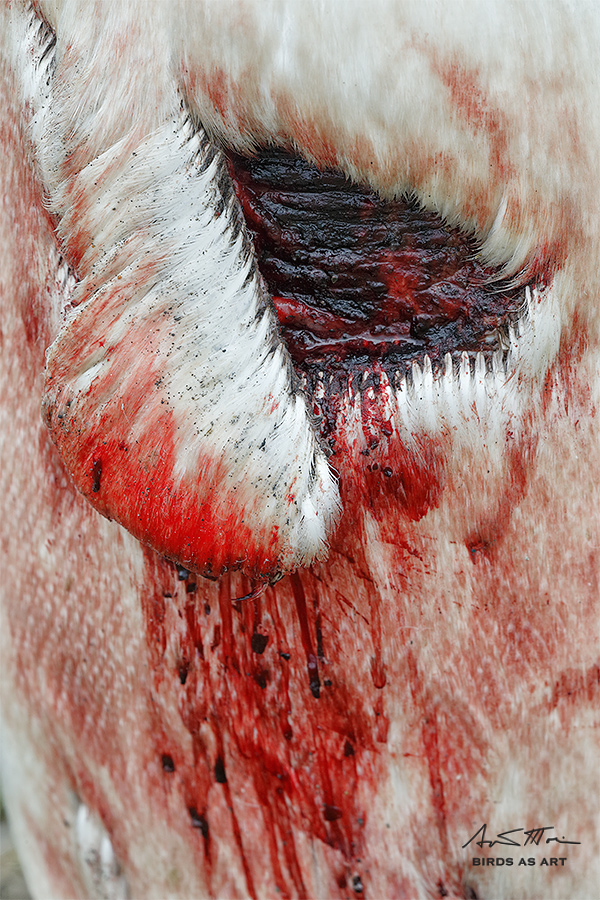
|
|
This image was created at St. Andrews Bay, South Georgia on the OCT/NOV Cheesemans’ Expedition with the Induro GIT 304L tripod/Mongoose M3.6-mounted Canon EF 100-400mm f/4.5-5.6L IS II USM lens, the Canon Extender EF 1.4X III (at 560mm), and the rugged Canon EOS-1D X. ISO 400. Evaluative metering +2/3 stop: 1/200 sec. at f/11. AWB. Should have been evaluative metering +1 1/3 stops as I needed to open this up during the RAW conversion in DPP 4.
Center AF point (by necessity)/AI Servo Expand/Rear Focus AF on the center of the breast as framed was active at the moment of exposure. Click here to see the latest version of the Rear Focus Tutorial.
King Penguin with large wound on breast
|
Warning: Gruesome & Gory
I saw more than a few bloody animals and birds on my last South Georgia expedition. The big male Elephant Seals led the league in gory wounds, wounds that were received in territorial/breeding dominance battles with other large males. King Penguins were not far behind but this wound in today’s featured image was the most gruesome by far. “It is possibly a prop injury but those would likely be on the penguin’s back” said Expedition Leader Ted Cheeseman when I shared this image with him. But he was not big on the wound having been caused by either a Leopard Seal or an Orca. Who knows? If you have a theory you are invited to share it with us here by leaving a comment.
This image is in stark contrast to the typically beautiful images made of this most handsome and colorful subject. I have spent hours and hours creating tight abstracts of the patterns on the necks of King Penguins. Life goes on. And in this case, sure death.
|

|
|
All images on the card were created on the 2015 Cheesemans’ South Georgia Expedition. From top left clockwise to center: King Penguin resting on Snow, Fortuna Bay; Macaroni Penguin in snow, Cooper Island; Grey-headed Albatross, Elsehul; King Penguin neck abstract, Godthul; Northern Giant Petrel, Undine Harbor; adult Wandering Albatross, Prion Island; Elephant Seal, Undine Harbor; South Georgia Pipit fledgling/thanks Joe Kaplan! Fortuna Bay; high key King Penguins in snow, Fortuna Bay.
Card design and all images copyright 2015: Arthur Morris/BIRDS AS ART
|
The Cheesemans’ 2016 OCT/NOV South Georgia/Falklands Expedition
If reading last Saturday’s blog post here put a thought in your mind about joining the BIRDS AS ART group on the Cheesemans’ 2016 OCT/NOV South Georgia/Falklands Expedition, please shoot me an e-mail with the words “Cheesemans’ Last South Georgia Expedition” cut and pasted into the Subject Line with any questions or if you wish to receive additional inspiration. This will surely be my last ship-based trip to the Southern Ocean as well.
|

|
|
All of the images on this card were created in the Falklands on the 2014 Cheesemans’ Southern Oceans Expedition. From top left clockwise to center: Black-browed Albatross tending chick, Steeple Jason Island; Black-browed Albatross courting pair, New Island; the Black-browed Albatross colony at Steeple Jason Island; Black-browed Albatross landing, New Island; King Cormorant head portrait, New Island; hull detail/derelict minesweeper, New Island; Rockhopper Penguin head portrait in bright sun, New Island; Striated Caracara, Steeple Jason Island; Magellanic Snipe chick, Sea Lion Island.
|
An Expedition Overview
Experience the vibrant spring of South Georgia, a true Antarctic wildlife paradise. Observe and photograph wildlife behaviors seldom seen beneath the towering, snow-blanketed mountains that dominate the island’s landscape. Southern Elephant Seal bulls fight for breeding rights while females nurse young, overlook vast colonies of loafing King Penguins, watch Macaroni Penguins cavort in the snow, photograph handsome Gray-headed Albatrosses in flight or attending to their cliffside nests and awkward Wandering Albatrosses attempting first flight. The itinerary includes six landing days on South Georgia and three landing days in the Falklands to observe too cute Rockhopper Penguins, Magellanic Penguins standing watch at their nesting burrows, and more Black-browed Albatrosses than you could ever imagine. To commemorate Shackleton’s famous self-rescue crossing South Georgia, CES also offers an optional trek retracing his steps. With Cheesemans’ twenty years of experience in the Antarctic region, they commit to an in-depth exploration of one of the densest wildlife spectacles found anywhere in the world, and with only 100 passengers, they routinely give you the opportunity to completely immerse yourself on each landing.
Two of the scheduled Falklands’ landings, New Island and especially Steeple Jason Island, rival the best locations on South Georgia. Those will likely include Salisbury Plain, St. Andrews Bay, Elsehul, Fortuna Bay, and either Cooper Island or Hercules Bay (for Macaroni Penguins).
Why Sign Up Through BIRDS AS ART?
If you have been thinking and dreaming of finally visiting South Georgia, this is the trip for you. There will likely never be another trip like this as the best outfit in the Southern Oceans business will not be returning after 2016…. Quit dreaming and act now. Though I will not be an expedition staff member on this trip, those who have traveled with me know that I cannot help but teach. And I will be doing a introductory photography program for the entire ship on our crossing to South Georgia. All who sign up via BAA will receive a free copy the new Southern Ocean Photography Guide (a $100 value) that I am currently working on. It will include pre-trip gear and clothing recommendations and a ton of info that you will find to be invaluable.
I will hold informal pre-landing briefings aboard ship so that when you land you know exactly what to expect and where to go. I will be available on the ship to review your images, answer your questions, and conduct informal over-the shoulder Photoshop sessions. And best of all, everyone who signs up under the auspices of BAA are invited to tag along with me on the landings where I will be glad to offer invaluable in-the-field advice. And the same goes for the shipboard birds in flight and marine mammal photographic sessions.
Again, if you would like to join me on what will truly be a once in a lifetime opportunity to a wondrous place, please shoot me an e-mail with the words “Cheesemans’ Last South Georgia Expedition” cut and pasted into the Subject Line.
You can learn more about the trip here. If you sign up on your own be sure to mention that you would like to be part of the BAA Group. I’d be glad to answer any and all question via e-mail or by phone at 863-692-0906.
Important Notes
#1: If you fail to e-mail me as noted directly above, and register directly with CES you MUST let them know that you would like to be part of the BIRDS AS ART group.
#2: Joining the BIRDS AS ART group as above will not cost you one penny.
For additional details on the trip and the ship, see Saturday’s blog post here.


Please Remember to use our Affiliate Links 🙂
To show your appreciation for my continuing efforts here, we ask, as always, that you use our the B&H and Amazon affiliate links on the right side of the blog for all of your purchases. B&H is recommended for you major photography gear purchases, Amazon for your household, entertainment, and general purpose stuff. Please check the availability of all photographic accessories in the BIRDS AS ART Online Store, especially the Mongoose M3.6 tripod heads, Gitzo tripods, Wimberley heads and plates, LensCoats and accessories, and the like. We sell only what I have used, have tested, and can depend on. We will not sell you junk. We know what you need to make creating great images easy and fun. And we are always glad to answer your gear questions via e-mail. I just learned that my account was suspended during my absence; it should be up and running by Monday at the latest.
I would of course appreciate your using our B&H affiliate links for all of your major gear, video, and electronic purchases. For the photographic stuff mentioned in the paragraph above we, meaning BAA, would of course greatly appreciate your business. Here is a huge thank you to the many who have been using our links on a regular basis and visiting the BAA Online store as well.
|

|
|
You can check these great holiday offers plus free next day shipping by clicking here.
|
B&H Free Next Day Holiday Shipping (on Selected Items)
Just two more days!
Click here and then either click on a category or a brand of by clicking on the red See All Qualified Items box. This deal is just what the holidays ordered. From now till December 23rd.
Facebook
Be sure to like and follow BAA on Facebook by clicking on the logo link upper right. Tanks a stack!
Typos
In all blog posts and Bulletins, feel free to e-mail or to leave a comment regarding any typos or errors. Just be right 🙂
December 20th, 2015 What’s Up?
I spent a few hours nearly finishing up the 2015 Bosque Current Conditions Guide and an equal amount of time doing critiques on BirdPhotographers.Net where honest critiques are done gently. BPN: it ain’t just birds. With my insane travel schedule, the upcoming San Diego exhibit, and the Bosque IPTs, I have not been spending much time there lately.
Amazing 7D Mark II/PIXMA PRO-100 Printer Kit Deal
Get a 7D II for a ridiculous $1049 and a free PIXMA PRO-100 Printer. With paper!
Y’all know how much I love my 7D II. Heck, look no further than today’s featured image to check out the amazing image quality. That plus the 7D II’s 1.6 crop factor which gives you lots of extra reach with lots of pixels. Also included within this kit is the PIXMA PRO-100 wireless inkjet printer, which prints up to 4800 x 2400 dpi and supports media up to 13 x 19″. An eight-color ink system realizes true color rendition and incorporates three monochrome inks for enhanced density and black and white printing capabilities.
What’s in the Kit?
Canon EOS 7D Mark II DSLR Camera (Body Only)
Canon PIXMA PRO-100 Wireless Professional Inkjet Photo Printer
Canon SG-201 Photo Paper Plus Semi-Gloss (13 x 19″, 50 Sheets)
Ruggard Commando 36 DSLR Shoulder Bag
SanDisk 32GB Ultra UHS-I SDHC Memory Card (Class 10)
Please note that there is a $350 mail-in rebate with this offer.
|
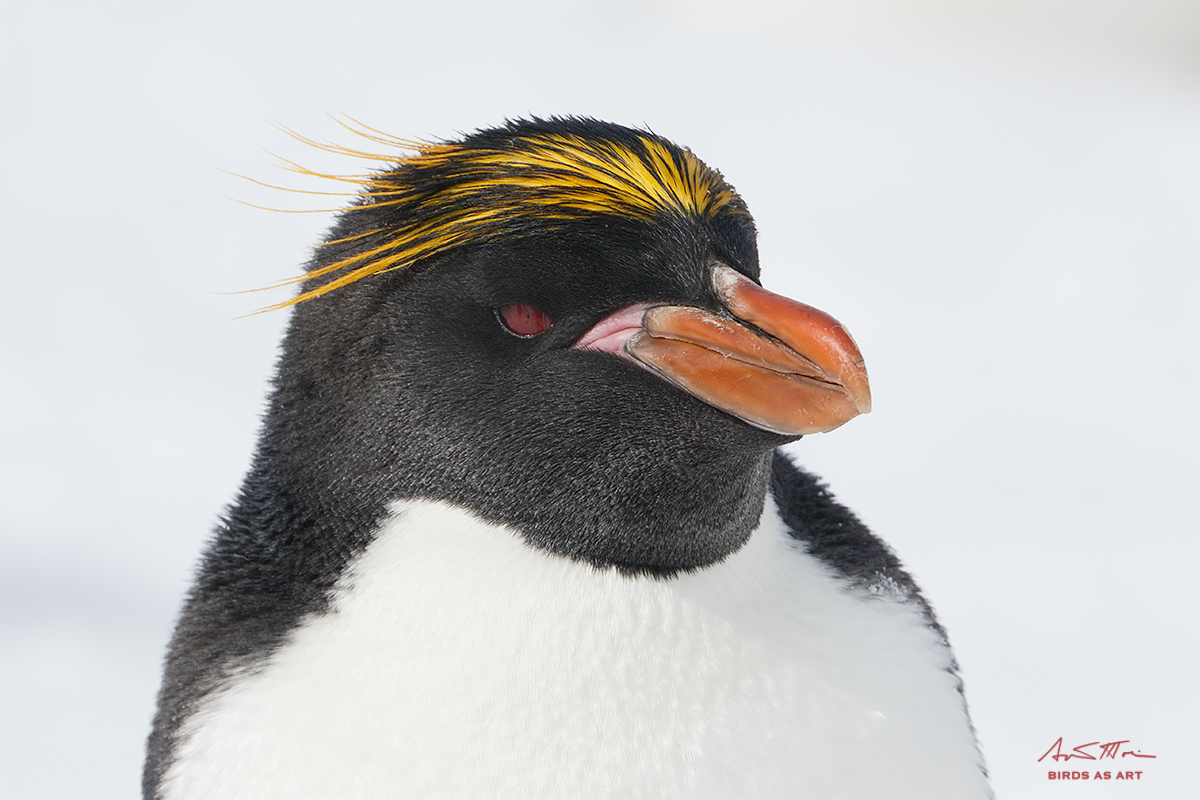
|
|
This image was created on the 2015 Cheesemans’ South Georgia Expedition with the Induro GIT 304L tripod/Mongoose M3.6-mounted Canon EF 400mm f/4 DO IS II USM lens, the Canon Extender EF 2X III, and the amazing Canon EOS 7D Mark II. ISO 400. Evaluative metering +2/3 stop: 1/640 sec. at f/11 in Manual mode.
Center AF point (Manual selection)/AI Servo/Rear Focus AF as originally framed was active at the moment of exposure. The active AF point was just below and behind the bird’s gape. Click here to see the latest version of the Rear Focus Tutorial. Click on the image to see a larger version.
Macaroni Penguin head portrait in snow
|
How Often Do We Get a Second Chance?
On my 2012 Cheesemans’ Southern Ocean Expedition I snoozed and lost when I decided–worried about my left knee–to stay on the ship on the Cooper Bay landing in a big snowstorm. Thanks to the kindness of friends, you can see what I missed in the November 18, 2012 blog post here.
There was lots of snow on the ground on the 11/6 landing on the great 2015 South Georgia Expedition. There was no way I was gonna miss that landing. And as fate would have it, there was lots of snow on the ground. I brought both the 100-400II and the new 400 DO II up the hill along with a 1D X, a 7D II, and both teleconverters. As the snow and the large stands of tussock grass made it hard to move around I got myself a good seat on a small mound and waited for the birds to oblige. They did.
I went super long with the 400 DO II, the 2X III TC, and the 7D II. With the cloudy bright conditions and all that snow, I was fine working at ISO 400. I set the exposure manually to two stops above the reading off the snow. I stopped down to f/11 both for a little extra sharpness as compared to f/8 and for a bit of extra depth of field; I knew that I would be working tight. The closer you are to the minimum focusing distance of your lens the more you need some extra d-o-f.
I created more than 700 images that morning and kept about 150 of them. This is the single frame that thrilled me. I guess that redemption might just be best served cold. 🙂
Exposure Question
If I set the exposure to two stops above the meter reading off the snow why did the analogue scale show only +2/3 stop as framed?
|

|
|
All images on the card were created on the 2015 Cheesemans’ South Georgia Expedition. From top left clockwise to center: King Penguin resting on Snow, Fortuna Bay; Macaroni Penguin in snow, Cooper Island; Grey-headed Albatross, Elsehul; King Penguin neck abstract, Godthul; Northern Giant Petrel, Undine Harbor; adult Wandering Albatross, Prion Island; Elephant Seal, Undine Harbor; South Georgia Pipit fledgling/thanks Joe Kaplan! Fortuna Bay; high key King Penguins in snow, Fortuna Bay.
Card design and all images copyright 2015: Arthur Morris/BIRDS AS ART
|
The Cheesemans’ 2016 OCT/NOV South Georgia/Falklands Expedition
If reading last Saturday’s blog post here put a thought in your mind about joining the BIRDS AS ART group on the Cheesemans’ 2016 OCT/NOV South Georgia/Falklands Expedition, please shoot me an e-mail with the words “Cheesemans’ Last South Georgia Expedition” cut and pasted into the Subject Line with any questions or if you wish to receive additional inspiration. This will surely be my last ship-based trip to the Southern Ocean as well.
|

|
|
All of the images on this card were created in the Falklands on the 2014 Cheesemans’ Southern Oceans Expedition. From top left clockwise to center: Black-browed Albatross tending chick, Steeple Jason Island; Black-browed Albatross courting pair, New Island; the Black-browed Albatross colony at Steeple Jason Island; Black-browed Albatross landing, New Island; King Cormorant head portrait, New Island; hull detail/derelict minesweeper, New Island; Rockhopper Penguin head portrait in bright sun, New Island; Striated Caracara, Steeple Jason Island; Magellanic Snipe chick, Sea Lion Island.
|
An Expedition Overview
Experience the vibrant spring of South Georgia, a true Antarctic wildlife paradise. Observe and photograph wildlife behaviors seldom seen beneath the towering, snow-blanketed mountains that dominate the island’s landscape. Southern Elephant Seal bulls fight for breeding rights while females nurse young, overlook vast colonies of loafing King Penguins, watch Macaroni Penguins cavort in the snow, photograph handsome Gray-headed Albatrosses in flight or attending to their cliffside nests and awkward Wandering Albatrosses attempting first flight. The itinerary includes six landing days on South Georgia and three landing days in the Falklands to observe too cute Rockhopper Penguins, Magellanic Penguins standing watch at their nesting burrows, and more Black-browed Albatrosses than you could ever imagine. To commemorate Shackleton’s famous self-rescue crossing South Georgia, CES also offers an optional trek retracing his steps. With Cheesemans’ twenty years of experience in the Antarctic region, they commit to an in-depth exploration of one of the densest wildlife spectacles found anywhere in the world, and with only 100 passengers, they routinely give you the opportunity to completely immerse yourself on each landing.
Two of the scheduled Falklands’ landings, New Island and especially Steeple Jason Island, rival the best locations on South Georgia. Those will likely include Salisbury Plain, St. Andrews Bay, Elsehul, Fortuna Bay, and either Cooper Island or Hercules Bay (for Macaroni Penguins).
Why Sign Up Through BIRDS AS ART?
If you have been thinking and dreaming of finally visiting South Georgia, this is the trip for you. There will likely never be another trip like this as the best outfit in the Southern Oceans business will not be returning after 2016…. Quit dreaming and act now. Though I will not be an expedition staff member on this trip, those who have traveled with me know that I cannot help but teach. And I will be doing a introductory photography program for the entire ship on our crossing to South Georgia. All who sign up via BAA will receive a free copy the new Southern Ocean Photography Guide (a $100 value) that I am currently working on. It will include pre-trip gear and clothing recommendations and a ton of info that you will find to be invaluable.
I will hold informal pre-landing briefings aboard ship so that when you land you know exactly what to expect and where to go. I will be available on the ship to review your images, answer your questions, and conduct informal over-the shoulder Photoshop sessions. And best of all, everyone who signs up under the auspices of BAA are invited to tag along with me on the landings where I will be glad to offer invaluable in-the-field advice. And the same goes for the shipboard birds in flight and marine mammal photographic sessions.
Again, if you would like to join me on what will truly be a once in a lifetime opportunity to a wondrous place, please shoot me an e-mail with the words “Cheesemans’ Last South Georgia Expedition” cut and pasted into the Subject Line.
You can learn more about the trip here. If you sign up on your own be sure to mention that you would like to be part of the BAA Group. I’d be glad to answer any and all question via e-mail or by phone at 863-692-0906.
Important Notes
#1: If you fail to e-mail me as noted directly above, and register directly with CES you MUST let them know that you would like to be part of the BIRDS AS ART group.
#2: Joining the BIRDS AS ART group as above will not cost you one penny.
For additional details on the trip and the ship, see Saturday’s blog post here.


Please Remember to use our Affiliate Links 🙂
To show your appreciation for my continuing efforts here, we ask, as always, that you use our the B&H and Amazon affiliate links on the right side of the blog for all of your purchases. B&H is recommended for you major photography gear purchases, Amazon for your household, entertainment, and general purpose stuff. Please check the availability of all photographic accessories in the BIRDS AS ART Online Store, especially the Mongoose M3.6 tripod heads, Gitzo tripods, Wimberley heads and plates, LensCoats and accessories, and the like. We sell only what I have used, have tested, and can depend on. We will not sell you junk. We know what you need to make creating great images easy and fun. And we are always glad to answer your gear questions via e-mail. I just learned that my account was suspended during my absence; it should be up and running by Monday at the latest.
I would of course appreciate your using our B&H affiliate links for all of your major gear, video, and electronic purchases. For the photographic stuff mentioned in the paragraph above we, meaning BAA, would of course greatly appreciate your business. Here is a huge thank you to the many who have been using our links on a regular basis and visiting the BAA Online store as well.
Facebook
Be sure to like and follow BAA on Facebook by clicking on the logo link upper right. Tanks a stack!
Typos
In all blog posts and Bulletins, feel free to e-mail or to leave a comment regarding any typos or errors. Just be right 🙂
December 19th, 2015 What’s Up
By 9:40pm on Friday evening when I was finishing up work on this blog post, I had answered 88 e-mails today. And I got lots of work done on the 2015 Bosque Current Conditions update. It is turning out to be much more involved then any previous update and includes lots of new tips new and information that is not just specific to 2015….
|

|
|
You can check these great holiday offers plus free next day shipping by clicking here.
|
B&H Free Next Day Holiday Shipping (on Selected Items)
Click here and then either click on a category or a brand of by clicking on the red See All Qualified Items box.
I did and quickly found a 7D Mark II for the insanely low price of $1399. That price already includes the $400 instant rebate. The icing on the cake includes the 2% reward and the free next day shipping. Just what the holidays ordered. From now till December 23rd.
|
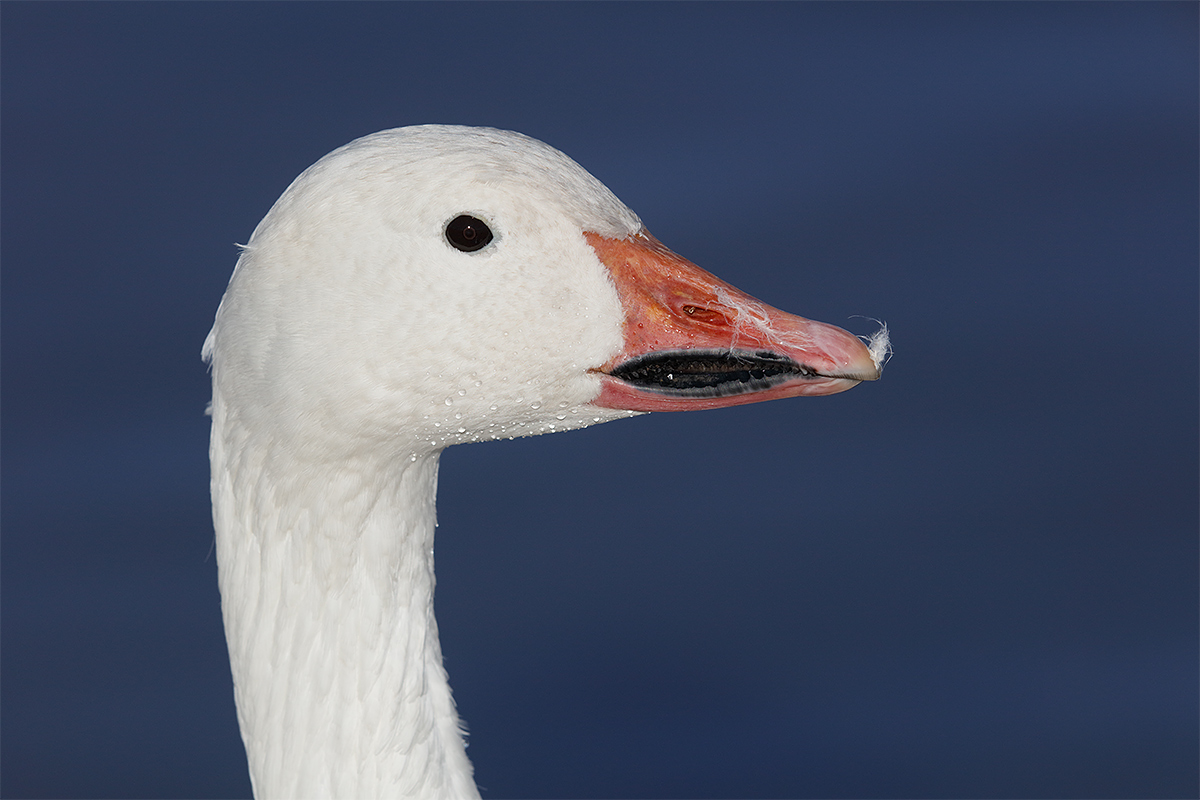
|
|
This image was created at Bosque del Apache on the 2nd afternoon of the first 2015 IPT with the Induro GIT 304L tripod/Mongoose M3.6-mounted BLUBB-supported Canon EF 600mm f/4L IS II USM lens, the Canon Extender EF 1.4X III,, and the incredible Canon EOS 5DS R. ISO 400. Evaluative metering -1/3 stop: 1/1600 sec. at f/9 in Manual mode. AWB.
Center AF point/AI Servo Expand/Rear Focus AF just behind and below the base of the bird’s lower mandible was active at the moment of exposure. As a result, the active AF point was precisely on the same plane as the bird’s eye. Click here to see the latest version of the Rear Focus Tutorial. Click on the image to see a larger version.
Snow Goose, tight head portrait of adult
|
The Back-story
While working on the 2015 Bosque Current Conditions Update late on Friday afternoon I was looking for some images to illustrate a portion of the text that lets folks know where they might get tight shots of the geese. I could not find what I knew what I had so I went to my “All Pix 6-30-2015” WD 2TB My Passport Ultra Portable Hard Drive (Black), found the 11/23/15 folder, and wound up keeping an additional six images that I had mistakenly overlooked on my first edit. With my new system, started almost six months ago, I keep every RAW file that I create by copying the complete download to the All Pix HD and to my laptop at the same time using Photo Mechanic’s Ingest feature. That way I can never lose a RAW file and I can go back to look for files that I overlooked or possibly some that I might need as source material.
Today’s featured image stood out like a sore thumb. “How in the world did I miss giving that one a check mark???”
Note that the exposure values, 1/1600 sec. at f/9 are just a third stop lighter than my recommended ISO 400 Bright White in the Sun exposure of 1/2500 sec. at f/8. Why 1/3 stop lighter? The sun was getting low. And I checked the histogram.
|
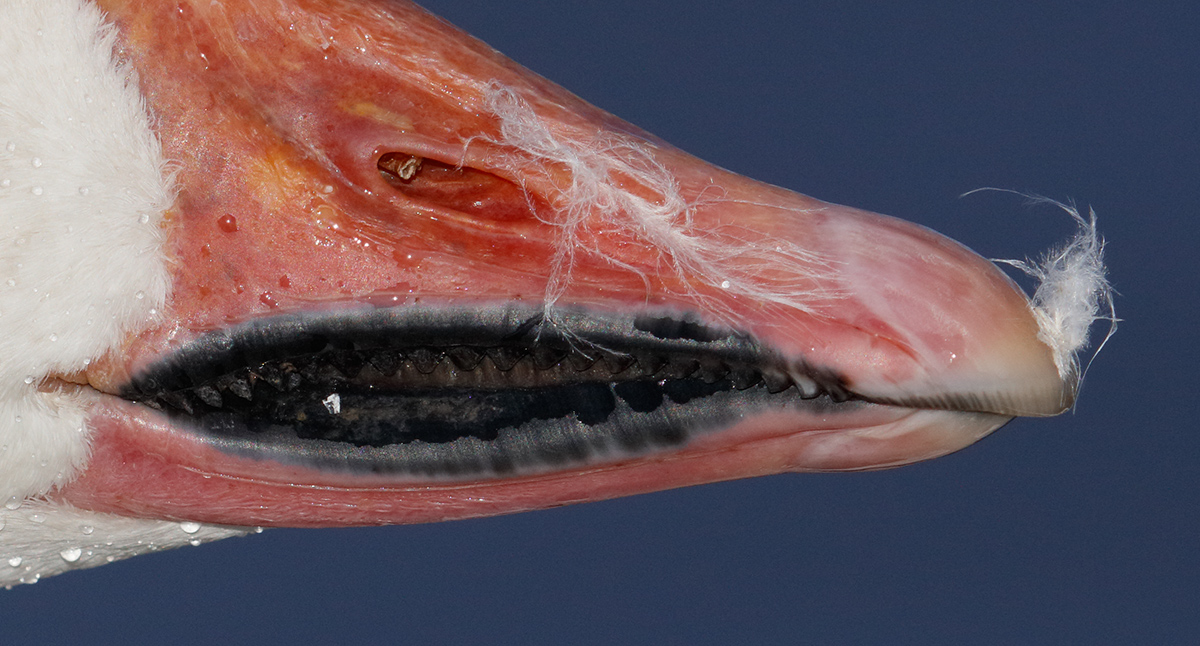
|
|
This is an unsharpened 100% crop of today’s featured image. It wound up being 1200 pixels wide and is displayed here at 800 pixels wide after being optimized to < 395 kb (from about 475 kb). Click on the image if you dare to see a larger version....
|
The Sickest-ever Canon EOS 5DS R 100% Crop…
If this one does not leave you slack-jawed….
Coming Soon
Quite soon I will attempt to present a cogent examination of both the facts and my gut feeling that you need to keep your rig steadier when using a 5DS R (or a 5DS and possibly a 7D Mark II) than when using the same lens any other Canon camera bodies. There are lots of complex issues and I am sure that there will be lots of civil disagreements. I do not permit any other type 🙂
My New 5DS R
On Tuesday past I purchased my affiliate loaner Canon EOS 5DS R camera body from B&H. On Wednesday I got an e-mail with a $325 B&H gift card as a result of my purchase. Wow! On Friday evening (Shabbos at B&H) the 10% Reward was still n effect. If you call on Sunday to check remember that you must hang up and place a web order (no matter what the salesman tells you). Many thanks for that. If what you have been learning here inspires you to purchase a 5DS R (or a 5DS), please remember to use the logo-link above; it will not cost you a penny and helps me out tremendously. Many thanks, artie
Facebook
Be sure to like and follow BAA on Facebook by clicking on the logo link upper right. Tanks a stack!
Typos
In all blog posts and Bulletins, feel free to e-mail or to leave a comment regarding any typos or errors. Just be right 🙂
December 18th, 2015 What’s Up?
I did lots of work yesterday on the San Diego Exhibit. Things are really coming to fruition. I will be sharing the formal announcement with y’all here soon. In the meantime you can mark the time of the “Choosing and Using Lenses for Bird and Nature Photography” slide program (8:30 to 10am) and the date of the exhibit opening, Saturday, January 16, 2016 on your calendars. The exhibit will open right after the slide program is concluded.
I went to Bartow early on Thursday morning to have blood spun for a sophisticated food allergy test ordered by Dr. Oliver. I really fell off the wagon with my diet both in the Southern Ocean and in New Mexico; the Cyrex test may give Cliff some insight into whether my congestion is a result of my gliadin allergies or possibly something else. Gliadin is a component of all grains especially wheat. Note: eating lasagna and raviolis as I did in NM was not a good plan :). But it sure tasted great. This weekend I will be gathering samples for a parasite test; we need to make sure that I did not pick up any bugs in South America. The last time I did this test it was discovered that I had three parasites, two of which could kill you.
In any case, I continue to feel pretty good, just congested.


Galapagos Photo Cruise of a Lifetime IPT/The Complete Galapagos Photographic Experience
If you would like to join me in the Galapagos in August, 2017, please scroll down and read carefully. Simply put, my Galapagos Photo-Cruises are the best ever for lots of reasons….
|
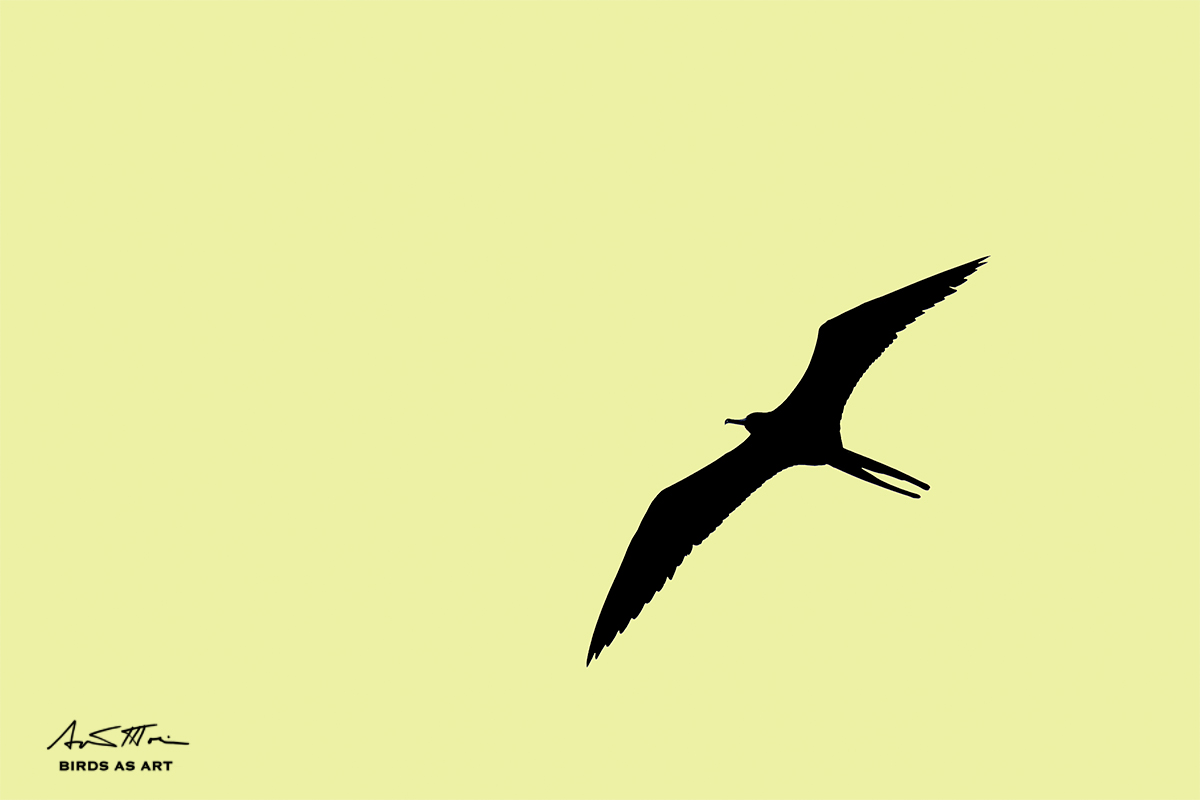
|
|
This image was created on the July 2015 Galapagos IPT with the hand held Canon EF 100-400mm f/4.5-5.6L IS II USM lens (at 400mm) and the amazing Canon EOS 7D Mark II. ISO 640. Evaluative metering +1/3 stop: 1/8000 sec. at f/5.6 in Av Mode. See more below on my exposure screw-up.
Center AF point/AI Servo Expand/Shutter Button AF as originally framed was active at the moment of exposure (as is always best when hand holding). Neither the selected AF point nor any of the assist points was on the subject…. Click here to see the latest version of the Rear Focus Tutorial. Click on the image to see a larger version.
Frigatebird silhouette
|
Shoot First/Ask Questions Later…
Here we were in the panga (zodiac) heading back to the ship after a fine first afternoon at Bachas Island. We had had some great chances with Black-necked Stilts, Striated Heron, Greater Flamingo, Lava Gulls, Sally Lightfoot Crabs, and baby Marine Iguanas. I properly had the 100-400 II in my hands with the camera turned on. It is almost always very calm in the Galapagos so there is rarely a need to keep your gear covered while cruising. In any case, I was not properly prepared. I have long advised folks to shoot first and ask questions later when it comes to action. In this case, I did as I say.
I saw the frigatebird flying by, raised the lens, acquired focus, and created two or three images, keeping one. When I looked at the EXIF and saw +1/3 stop, 1/8000 second, I knew that I had screwed up by severely under-exposing the image. I could have had plenty of shutter speed had I had the EC set properly to something like +2 stops (as framed).
What to do?
|
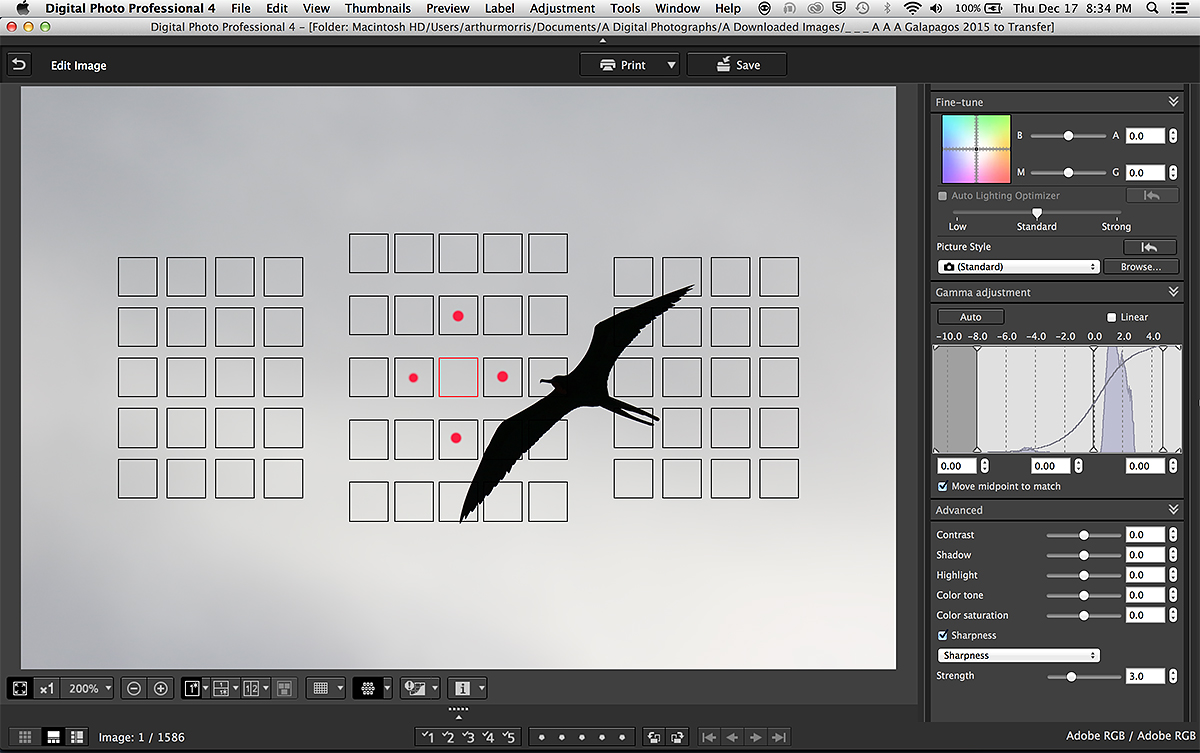
|
|
The DPP 4 Screen Capture for the RAW file right out of camera. Note that neither the active AF point nor the assist points (I added the red circles to show them) fell on the bird. Yet, the image was sharp. This was due in part to the fact that the system often will keep tracking for a moment or two with a sky background, and in part to my Custom Case settings as detailed in the User’s Guides for the new cameras, the 5D III, the 1D X, and the 7D II.
|
The RAW Conversion and the Image Optimization
With the image created at ISO 640 but well under-exposed, I used my saved recipe for the 7D Mark II at ISO 800 for the conversion. A little extra noise reduction would make the sky smoother. You can easily see the big under-exposure in the DPP 4 screen capture above by noting the tonality of the gray sky. Next I moved the Brightness slider to +1.5 stops. One of the things that I love about DPP 4 is that once you load your saved recipe for a given camera and ISO there is very little work left to be done, usually just a few tweaks on two of the Advanced sliders (lower right above).
The original plan after bringing the image into Photoshop was to create a stark Black and White silhouette with a Levels adjustment. But I decided to add some color to the sky so I selected the BKGR with the Magic Wand Tool (my custom keyboard shortcut M) and used the Paint Bucket to add yellow to the sky but the results were much too garish. To soften up the yellow, still with the sky on its own layer, I first went to Selective Color and took about 80 points of BLACK out of the YELLOWs. Then I messed around with the sliders for the WHITEs but there were no great changes It looked better but still needed some tweaking so I opened up Color Balance on that same layer and moved the sliders around going left and then right with each slider to see the effect. Moving the bottom slider well towards BLUE got me the nice soft yellow that you see in the optimized image that opened this blog post.
Digital Basics
Most everything that I did to optimize today’s image is covered in detail in my Digital Basics File–written in my easy-to-follow, easy-to-understand style. Are you tired of making your images look worse in Photoshop? Digital Basics File is an instructional PDF that is sent via e-mail. It includes my complete digital workflow, dozens of great Photoshop tips, details on using all of my image clean-up tools, the use of Contrast Masks, several different ways of expanding and filling in canvas, all of my time-saving Keyboard Shortcuts, Quick Masking, Layer Masking, and NIK Color Efex Pro basics, Contrast Masks, Digital Eye Doctor techniques, using Gaussian Blurs, Tim Grey Dodge and Burn, a variety of ways to make selections, how to create time-saving actions, the Surface Blur (background noise reduction) settings that I use to smooth background noise, and tons more.
APTATS I & II
Learn the details of advanced Quick Masking techniques in APTATS I. Learn Advanced Layer Masking Techniques in APTATS I. Mention this blog post and apply a $5 discount to either with phone orders only. Buy both APTATS I and APTATS II and we will be glad to apply at $15 discount with phone orders. Please call Jim or Jennifer weekdays at 863-221-2372 to take advantage of this special offer. You can find the same deal in the BAA Online Store here.
|

|
|
You can order your copy of “The Photographers’ Guide to Canon Digital Photo Professional 4.0” (aka the DPP 4 Raw Conversion eGuide) by Arash Hazeghi and Arthur Morris by clicking here.
|
The DPP 4 eGuide (PDF)
Learn how and why I and many other discerning photographers choose and use only DPP 4 to convert their Canon RAW files in the DPP 4 RAW Conversion Guide by Arash Hazeghi and yours truly. The latest version supports all of the newer Canon camera bodies and several older models including the EOS-7D and the EOS-1D Mark IV. The DPP IV Guide is the ideal companion to the 7D Mark II User’s Guide, a runaway best seller.
The DPP 4 eGuide (PDF) Updated for 1D Mark IV and the original 7D
The DPP 4 eGuide was recently updated to include the luminance and chrominance noise reduction values for both the 1D Mark IV and the original 7D. If you purchased your copy from BAA please e-mail Jim and request the DPP 4 1d IV/7D update. Please be sure to cut and paste page 1 into your e-mail as proof of purchase.
DPP 4 Kudos
From Richard Gollard via e-mail:
I have been doing tons of studying the books and PDFs that I have purchased from BIRDS AS ART. And I have to say that after reading the DPP 4 conversion guide that you did with Arash Hazeghi I tried DPP 4 and was blown away with the difference from the conversions that I made with Adobe Photoshop and Lightroom. Thanks for the consistently great information.
|
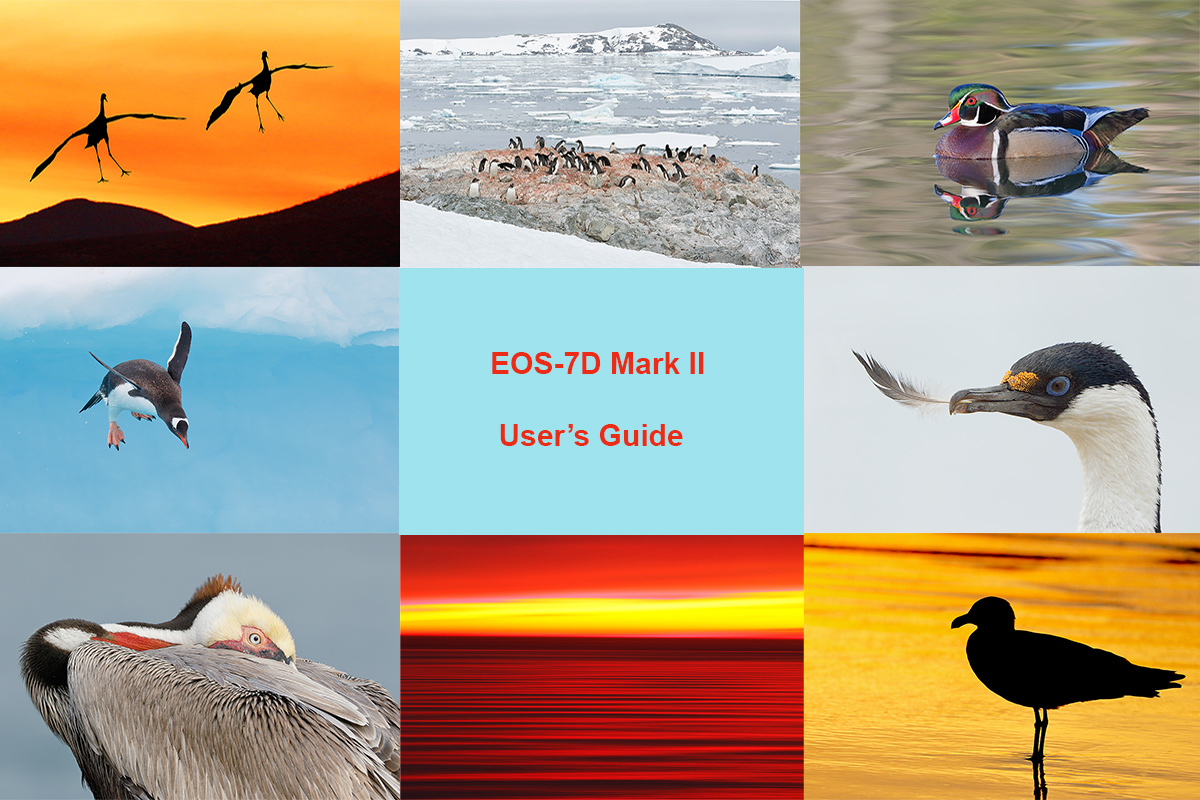
|
|
You can purchase your copy of the The 7D Mark II User’s Guide in the BAA Online Store here for $59.
|
7D Mark II User’s Guide
You can purchase your copy right now in the BAA Online Store here for $59. Or call Jim or Jennifer at 863-692-0906 and place a phone order. This is the highest priced user’s guide ever, surpassing the 5D II User’s Guide that is priced at $50. Why? I did twice as much work preparing the 7D II Guide. It required many days of writing, many dozens of hours of study and research, not to mention hundreds of hours in the field trying to figure out the best 7D II setting while doing what I love to do best, photographing birds and nature. The camera is quite complex. Many thanks to both Rudy Winston and Chuck Westfall of Canon USA for their help in getting me through the stickiest parts.
The guide contains 23,196 words in 516 paragraphs. There are 24 photos and screen captures interspersed in the main body of the text and a gallery of 23 additional 7D II images that show what the camera is capable of with a variety of lens and lens/TC combinations. We would love your feedback.
The Great Strength of the 7D Mark II User’s Guide
The very great strength of the 7D Mark II User’s Guide is the coverage of the autofocus system. I review in detail all of the items on the five pink AF Menus. Most important of these is the Custom Case setting (at AF 1) that I have developed over time and currently use for all of my bird photography. On the recently concluded Hooptie Deux Spoonbills and more IPT John Johnson of Naples, FL mentioned that he was having trouble producing sharp flight images. I set up my Custom Case on his camera, and within minutes he was amazed at the sharp results that he was getting…. While skill, strength, fine motor control, and superior hand eye coordination are all factors that will influence your success as a flight photographer, you can have all of the preceding in spades but if your camera is not set up properly much of your effort will be in vain….
What Else is in the Guide?
In the 7D Mark II User’s Guide you will learn everything that I know about the important topics listed below, and better yet, I explain the options for each along with my reasons for choosing a specific setting in a specific situation.
Handling the WHITEs
The top LCD and all camera control buttons
7D Mark II drive modes
How to manually select an AF sensor
Choosing an AF Area Selection Mode; how and why (includes extensive detail)
Moving the AF point or Zone
The creation of in-camera Multiple Exposures and in-camera HDR images (includes extensive detail)
Live View Shooting and AF choices (all new in the 7D II)
Menu Item Access
Coverage of almost all Menu Items and Custom Functions including the following: Image Quality, Auto Lighting Optimizer, Lens aberration corrections settings, Highlight Tone Priority, AF Configuration Tool (as above, this includes details on the custom setting that I use), Acceleration/deceleration tracking, Tracking sensitivity, Lens drive when AF impossible, Orientation linked AF point (I love this feature), Highlight alert, Histogram display–do you know how to access both histograms at once?, Auto rotate, Image Jump, LCD Brightness, Info button display options, Custom Shooting Modes set-up, ISO Safety shift, using the Q button, setting up rear focus, and setting up your My Menu feature (among others).
The guide is–of course–written in my informal, easy-to-follow style.
Please note: Some Menu items are not covered in this guide for one of several reasons:
- They deal only with the creation of movies (not covered)
- They are irrelevant to nature photography.
- After spending hours studying the 7D II Instruction Manual and consulting others I have no clue as to the purpose or the reason for the existence of a given feature.
Though I recommend that the irrelevant and confusing items be left at the default settings, I do, in most cases, I refer you to the relevant page in the 7D II Instruction Manual. If you follow up, it just might turn out that you are a lot smarter than me. In those cases I would love to hear from you via e-mail. So far none of the above have prevented me from creating many spectacular images with my 7D II.
Please note that this guide does not contain a table of contents or an index. To search the document for a given topic simply hit Control F to search. When the Find box pops up, simply type the term that you are looking for into the field and hit Next. This will allow you to find what you are looking for quickly and efficiently.
If you purchase the 7D II UG and it helps you to create better images, please feel free to send no more than two 1200 pixel wide or 900 pixel tall sharpened JPEGs to me via e-mail along with your comments. I will be glad to do a short critique if requested.
Click here and scroll down for a free 7D Mark II User’s Guide AF Point Auto Switching Excerpt.
|
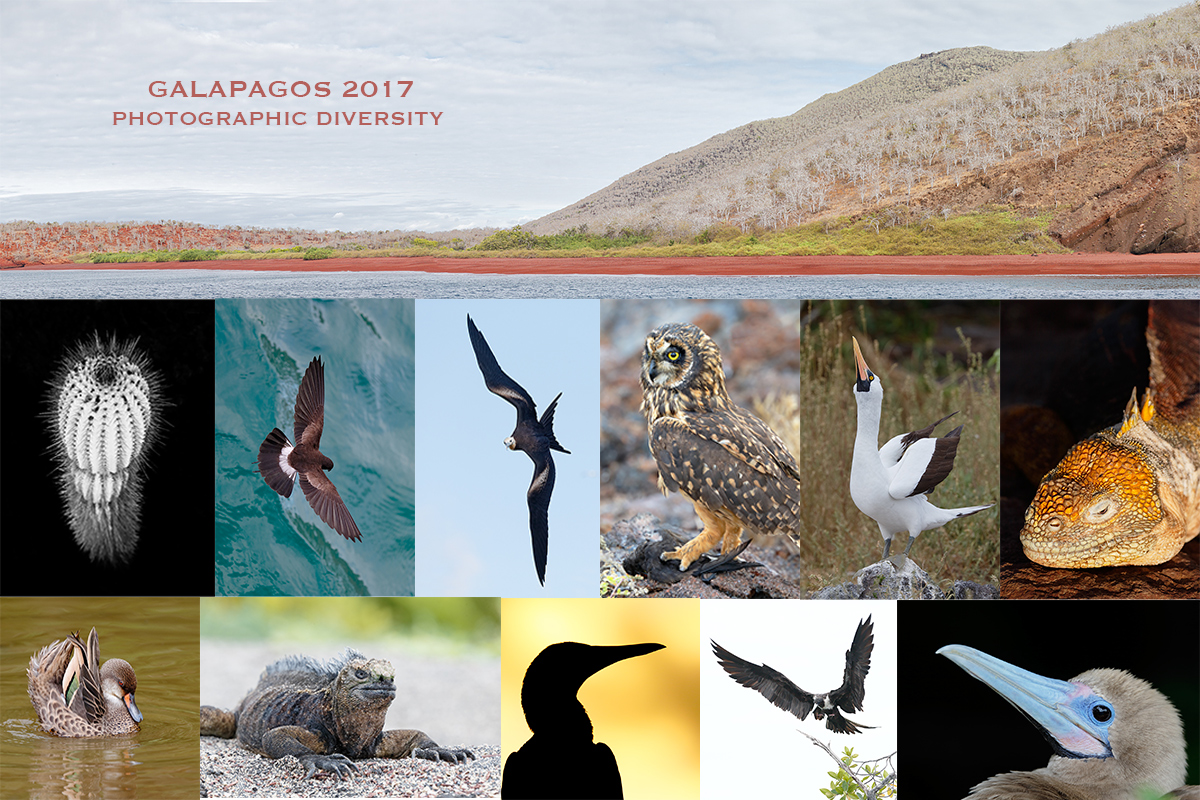
|
|
Tame birds and wildlife. Incredible diversity. You only live once….
|
Galapagos Photo Cruise of a Lifetime IPT/The Complete Galapagos Photographic Experience. August 8-22, 2017 on the boat. 13 FULL and two half-days of photography: $12,499. Limit: 13 photographers plus the leader: yours truly. Openings: 10.
Same great trip; no price increase! This trip needs nine to run; in the unlikely event that it does not, all payments to BAA will be refunded in full.
My two-week Galapagos Photo-Cruises are without equal. The world’s best guide, a killer itinerary, a great boat (the Samba), and two great leaders with ten Galapagos cruises under their belts. Pre-trip and pre-landing location-specific gear advice. In-the-field photo instruction and guidance. Jeez, I almost forgot: fine dining at sea!
The great spots that we will visit include Tower Island (including Prince Phillips Steps and Darwin Bay), Hood Island (including Punta Suarez, the world’s only nesting site of Waved Albatross, and Gardner Bay)—each of the preceding are world class wildlife photography designations that rank right up there with Antarctica, Africa, and Midway. We will also visit Fernandina, Puerto Ayora for the tortoises, Puerto Egas—James Bay, and North Seymour for nesting Blue-footed Boobies in most years, South Plaza for Land Iguanas, Floreana for Greater Flamingoes, and Urbina Bay, all spectacular in their own right. We visit every great spot on a single trip. Plus tons more. And there will be lots of opportunities to snorkel on sunny mid-days for those like me who wish to partake.
It is extremely likely that we will visit the incredible Darwin Bay and the equally incredible Hood Island, world home of Waved Albatross twice on our voyage. The National Park Service takes its sweet time in approving such schedule changes.
We will be the first boat on each island in the morning and the last boat to leave each island every afternoon. If we are blessed with overcast skies, we will often spend 5-6 hours at the best sites. And as noted above, mid-day snorkeling is an option on most sunny days depending on location and conditions. On the 2015 trip most snorkeled with a mega-pod of dolphins. I eased off the zodiac to find hundreds of dolphins swimming just below me. Note: some of the walks are a bit difficult but can be made by anyone if half way decent shape. Great images are possible on all landings with either a hand held 70-200mm lens and a 1.4X teleconverter or an 80- or 100-400. I sometimes bring a longer lens ashore depending on the landing. In 2017 I will be bring the Canon 400mm IS DO II lens. In the past I have brought either the 300mm f/2.8L IS II or the 200-400mm f/4 L IS with Internal Extender.
|
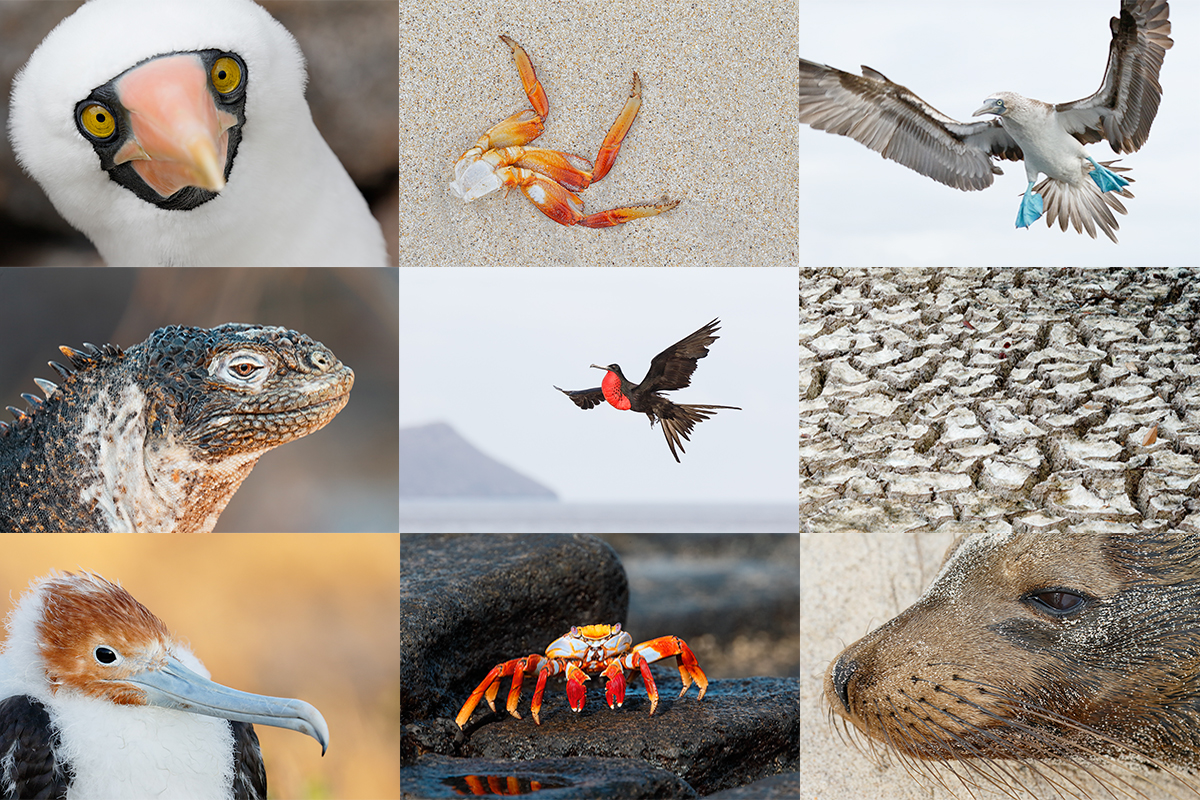
|
|
Do consider joining me for this once in a lifetime trip to the Galapagos archipelago. There simply is no finer Galapagos photography trip. Learn why above.
|
An Amazing Value…
Do know that there are one week Galapagos trips for $8500! Thus, our trip represents a tremendous value; why go all that way and miss half of the great photographic locations?
The Logistics
August 6, 2017: We arrive a day early to ensure that we do not miss the boat.
August 7, 2017: There will be an introductory Galapagos Photography session and a hands on exposure session at our hotel.
August 8, 2017: We fly to the archipelago and board the Samba. Heck, on the 2015 trip some people made great images at the dock in Baltra while our luggage was being loaded!
August 22, 2017: We disembark late morning and fly back to Guayaquil midday; most will overnight there.
Most will fly home on the early morning of July 23 unless they are staying on or going elsewhere (or catching a red-eye flight on the evening of the 22nd).
$12,499 includes just about everything: all transfers, guide and park fees, all food on the boat, transfers and ground transportation, your flights to the archipelago, and three nights (double occupancy) in a top notch hotel in Guayaquil. If you are good to go, a non-refundable deposit of $5,000 per person is due immediately. The second payment of $4,000 is not due until 11/1/16. The final payment of $3449 per person will be due on 2/1/17. A $200 discount will be applied to each of the balances for couples or friends who register at the same time.
Purchasing travel insurance within 2 weeks of our cashing your deposit check is strongly recommended. On two fairly recent cruises a total of 5 folks were forced to cancel less than one week prior to the trip. My family and I use Travel Insurance Services and strongly recommend that you do the same.
Not included: your round trip airfare from your home to and from Guayaquil, beverages on the boat, phone calls, your meals in Guayaquil, personal items, and a $600/person cash tip for the crew and the guide—this works out to roughly $40/day to be shared by the 7 folks who will be waiting on us hand and foot every day for two weeks. The service is so wonderful that many folks choose to tip extra.
Please e-mail for the tentative itinerary or with questions. Please cut and paste “Galapagos 2017 Tentative Itinerary Please” into the Subject line.
Facebook
Be sure to like and follow BAA on Facebook by clicking on the logo link upper right. Tanks a stack!
Typos
In all blog posts and Bulletins, feel free to e-mail or to leave a comment regarding any typos or errors. Just be right :).
December 17th, 2015
|

|
|
You can check these great holiday offers plus free next day shipping by clicking here.
|
B&H Free Next Day Holiday Shipping (on Selected Items)
Click here and then either click on a category or a brand of by clicking on the red See All Qualified Items box.
I did and quickly found a 7D Mark II for the insanely low price of $1399. That price already includes the $400 instant rebate. The icing on the cake includes the 2% reward and the free next day shipping. Just what the holidays ordered. From now till December 23rd.
5DS R
If you are thinking about this amazing camera scroll down to learn of the killer deal that I enjoyed recently. It included a 10% B&H Gift Card!
A Monday (and a Tuesday) to Remember…
9:40am:
I see a white envelope on the kitchen counter that says, “To be opened only by Arthur Morris.” So I opened it.
This office has been advised that you conducted a private commercial operation on Bosque del Apache NWR during the period November 28-December 2 without having obtained a Commercial Use Permit from the US F&W Service. It is alleged that you never applied for nor were granted a permit for you Instructional Photo-Tour. This offense carries a maximum fine of $10,000 USD or 1 year imprisonment or both.
Attached is a US District Court notice of violation for conducting a private commercial operation on a National Wildlife Refuge without a permit. If you wish to contest this issue, do nothing. In 90 days you will receive a summons to appear in Federal Court at the Peter V. Domenici US Court House located at 333 Lomas Blvd in Albuquerque, NM.
A very official looking US District Court Violation was indeed attached.
First reaction: heart rate increased a bit. Then I thought to ask, “Is it true?”
“Jen, please see if Bosque cancelled one check or two for the recently-concluded Bosque IPTs.” “Two Daddy,” she said after a short search. Next I checked my e-mail and found the one with both permits attached.
I called the refuge at 11am (9am Mountain time) and left a message for the Federal Wildlife Officer who had sent the letter. Later that afternoon I received an e-mail that said in effect, “Sorry. We were wrong. Never mind.”
10:00am:
I decided to upgrade the two long legs of my Namibia flights (JFK to JNB and back) to business class. “That should be a simple matter I thought.” I called South African Airlines (SAA) to do the upgrade. “Since you purchased the ticket from Expedia only they can make that change.” So I called Expedia. It took close to an hour to finally have the agent tell me that they could not do the upgrade and that I should call SAA. So I did. Again they told me that Expedia must be the ones to make that change. So back and forth I went, receiving a different fairy tale each time.
Each call to SAA lasted 10-15 minutes. Each call to Expedia last 40 minutes to an hour. I’d guess that on five of the calls to Expedia I got either a dial tone or a welcome recording after 40-50 minutes> After the first time that that happened I would ask the Expedia agent to take a callback number and call me when I got cut off. Nobody ever called me back.
On Monday night after more than an hour on the phone, most of that of course on hold, the Expedia agent said, “I’ve got it. I can do it. The cost of the upgrade is a bit more than $11,000. I had figured that it would be about $6,000 and SAA had quoted me $5814 several times. I was confident that the smaller amount was correct.
8:30am on Tuesday:
I called SAA first and was told to call Expedia and tell them that all they needed to do was to put the record in OSI. So I did, and after about 35 minutes I was told that that was not possible but that they would try to get help from “their team of associates.” So I called SAA–this time on a second line–while holding for the Expedia manager. Again SAA told me, “We cannot do that. Only Expedia can do it.” I said, “That may very well be true but Expedia is not capable of doing the upgrade. I was on the phone with them for more than 7hours yesterday. I called you guys 7 times and them 8 times. They are on the other line right now and I am on hold. Please, I need your help. I am in a Catch 22 situation. They can’t do it and SAA won’t do it. I want to give you or them close to $6,000 for a seat that is available and nobody an help me.”
“I’ve been sick for seven weeks. I have been on the phone for about nine hours. I am near tears. Please help.” Just then I got a busy signal on the Expedia line and let the SAA agent know what had just happened. She said, “Hold on a minute.” I held for about ten minutes. When the agent came back she said “Credit card please.” I said, “When can I kiss you?” “She said “Now.”
I got the e-mail confirming my upgrade within the hour. I am proud of the fact that I never once raised my voice or cursed anyone out (though I will admit to thinking about the latter). As I say often, I am one determined S.O.B.
Back to Monday after lunch at about 1pm:
My personal line rings and I pick up only to hear a recorded message. “This call is to let you know that the Internal Revenue Service has instituted a lawsuit against you in Federal Court because of criminal non-payment of taxes on your 2009 through 2013 Federal Tax Returns. Please call 1-210-807-8097 immediately.” I called and was cut off. I called back and nobody picked up. I called an hour later and had a really garbled conversation with an “IRS agent” who said that six letters had been sent to me by Certified Mail and that I had ignored all of them.”
First reaction: heart rate increased a bit. Then I thought to ask, “Is it true?”
Things seemed really strange. I e-mailed and called my accountant, Robert H. “Chip” Jackson, a retired IRS agent. He called me back at about 6pm and after I explained the whole thing to him he laughed and said, “It is a scam. The IRS never does anything by phone.”
All in all it has been a Monday (and Tuesday) to remember.
The Work
To learn to question your own story, visit www.TheWork.com. Byron Katie will teach you to do The Work her way and find peace. Remember, happiness is a choice. And so is aggravation.
Care to Share?
If you have had a memorable experience recently, please feel free to share it with us by leaving a comment.
On Tuesday I purchased my affiliate loaner Canon EOS 5DS R camera body from B&H. On Wednesday I got an e-mail with a $325 B&H gift card as a result of my purchase. Wow! I am not sure how long this offer lasts. If you call to find out please remember that you must hang up and place a web order (no matter what the salesman tells you). Many thanks for that. If what you have been learning here inspires you to purchase a 5DS R (or a 5DS) please remember to use the logo-link above; it will not cost you a penny and helps me out tremendously. Many thanks, artie
ps: as of this minute, 10:57am eastern time on 12/17/15, the “Receive 10% Reward line was still showing up right under the price. Hurry! And please remember, web orders only.
Facebook
Be sure to like and follow BAA on Facebook by clicking on the logo link upper right. Tanks a stack!
Typos
In all blog posts and Bulletins, feel free to e-mail or to leave a comment regarding any typos or errors. Just be right 🙂
December 16th, 2015 What’s Up?
I lay awake on Monday night for more than an hour having a tickle-cough fit. Then I finally figured out that breathing some steam would help. It did. Then I slept till 7:45. Finally went to my doctor in Lake Wales today. He thinks that I have had at least two respiratory bugs over the past 7 weeks. But my lungs are clear. As are my lung sounds. He started me on an albuterol nebulizer. Albuterol is a bronchodilator that relaxes muscles in the airways and increases air flow to the lungs. He also wants me breathing steam and drinking lots of decaffeinated tea. He thinks that I will be all better quite soon. I think that that is a good plan.


My Very Own 5DS R
Today I purchased my affiliate loaner Canon EOS 5DS R camera body from B&H. If what you have been learning here inspires you to purchase one please remember to use the logo-link above; it will not cost you a penny and helps me out tremendously. Many thanks, artie
|
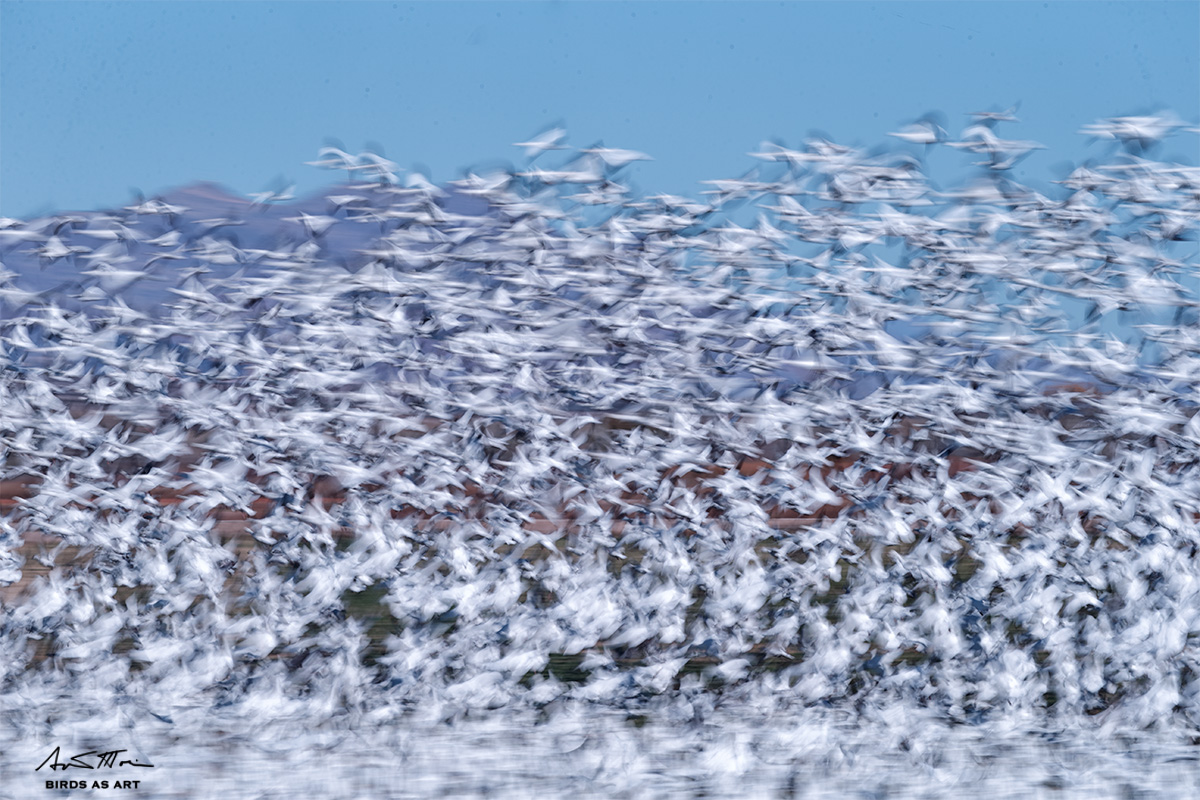
|
|
This image was created at Bosque del Apache NWR with the hand held Canon EF 100-400mm f/4.5-5.6L IS II USM lens (at 330mm) and the rugged Canon EOS-1D X. . ISO 50. Evaluative metering +1 stop: 1/13 sec. at f/6.3. Cloudy WB. Singh-Ray 3-stop Resin Mor-Slo Neutral Density Filter.
Center AF point/AI Servo Expand/Rear Focus AF as framed was active at the moment of exposure (as is always best when hand holding). Click here to see the latest version of the Rear Focus Tutorial. Click on the image to see a larger version.
Image #1: Snow Geese snowing…
|
The Basic Premise
Using either the Singh-Ray 3-stop Resin Mor-Slo Neutral Density Filter or their 5-stop Glass ND allows me to get down to extremely slow shutter speeds even in bright sun without having to stop down to f/too many dust spots. I own both of these ND filters in the 77mm size that fits both my 100-400II (used to create all four of today’s images) or my old favorite blast off lens, the 70-200m f/2.8L IS (with either the 1.4X III or the 2X III TC). I use the 3-stop ND in cloudy bright conditions and the 5-stop in bright sun.
All four images here today were made in relatively bright sun yet they look as if they were created in a huge soft box. What gives? The blend blur effect: When you are working at extremely slow shutter speeds such as those between 1/8 and ½ or even one full second and panning as you shoot, the whites of the geese effectively blend with the middle tones of the background thus softening the otherwise harsh whites as you pan. And the background is softened as well. Bright sun is magically transformed into cloudy bright.
As we learned here the other day, you can prove to yourself that the blend blur effect exists as follows: With an ND filter in place and a very slow shutter speed set—hint: you need to be in Manual mode–play with your exposure settings and make a few test exposures until you have at least some blinkies on the white geese. Now take a second test exposure while panning: no more blinkies. You have just proven to yourself that the blend blur effect does indeed exist. In addition to creating wonderful pan-blurs you can tame the harsh light at any time of day, even high noon.
|
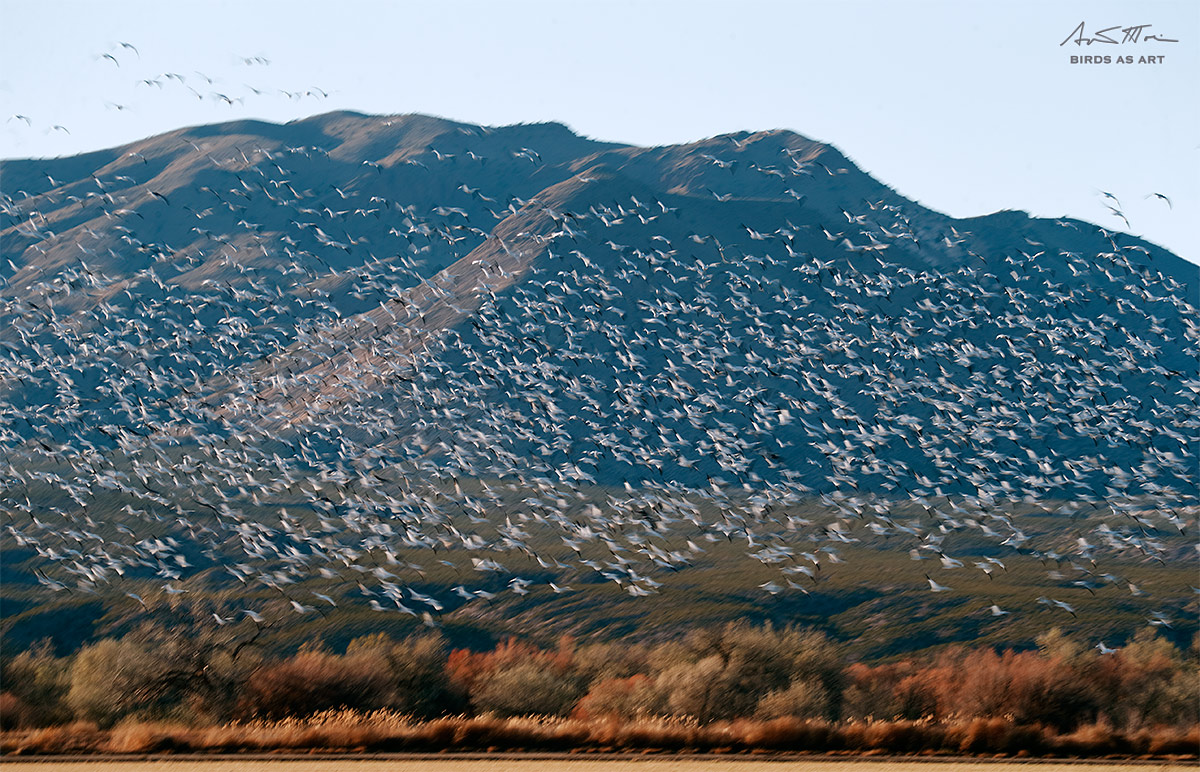
|
|
This image was created at Bosque del Apache NWR with the hand held Canon EF 100-400mm f/4.5-5.6L IS II USM lens (at 271mm) and the rugged Canon EOS-1D X. . ISO 50. Evaluative metering at zero; 1/15 sec. at f/9. Cloudy WB. Singh-Ray 3-stop Resin Mor-Slo Neutral Density Filter.
Two AF points up from the center AF point/AI Servo Surround/Rear Focus AF as framed was active at the moment of exposure (as is always best when hand holding). Click here to see the latest version of the Rear Focus Tutorial. Click on the image to see a larger version.
Image #2: Snow Geese against the Chupadera Mountains
|

Singh-Ray Filters
Singh-Ray filters have been used by the world’s top photographers for many decades. As always, I will have my 77mm Singh-Ray Warming Polarizer in my vest in case of rainbows. And I now travel (as above) with various Singh-Ray ND filters so that I can create pleasing blurs even with clear skies and bright sun. See here for a great example.
No other filter manufacturer comes close to matching the quality of Singh-Ray’s optical glass that is comparable to that used by NASA. And they continue to pioneer the most innovative products on the market like their ColorCombo polarizer, Vari-ND variable and Mor-Slo 15-stop neutral density filters. When you use their filters, you’ll create better, more dramatic images and, unlike other filters, with absolutely no sacrifice in image quality. All Singh-Ray filters are handcrafted in the USA.
Best News: 10% Discount/Code at checkout: artie10
To shop for a Singh-Ray’s most popular solid ND filter, the 10-Stop Mor-Slo Glass Filter liter (for example), click on the logo link above, click on “Neutral and color Solid Neutral Density Filters (glass), then click on “Mor-Slo™ 5, 10, 15 and 20-Stop Solid Neutral Density Filters (glass),” choose the size and model, add to cart, and then checkout. At checkout, type artie10 into the “Have a coupon? Click here to enter your code” box, and a healthy 10% discount will be applied to your total. In addition to enjoying the world’s best filter at 10% off you will be supporting my efforts here on the blog.
The 10- and 15-stop Mor Slo filters are great for landscapes with water and moving clouds. With the 10-stop, 1/125th becomes 8 seconds and with the 15-stop, 4 minutes. I now own the 10-stop ND and will look for opportunities to use it. I am also testing their new Hi-Lux filters. More on that at some point.
|
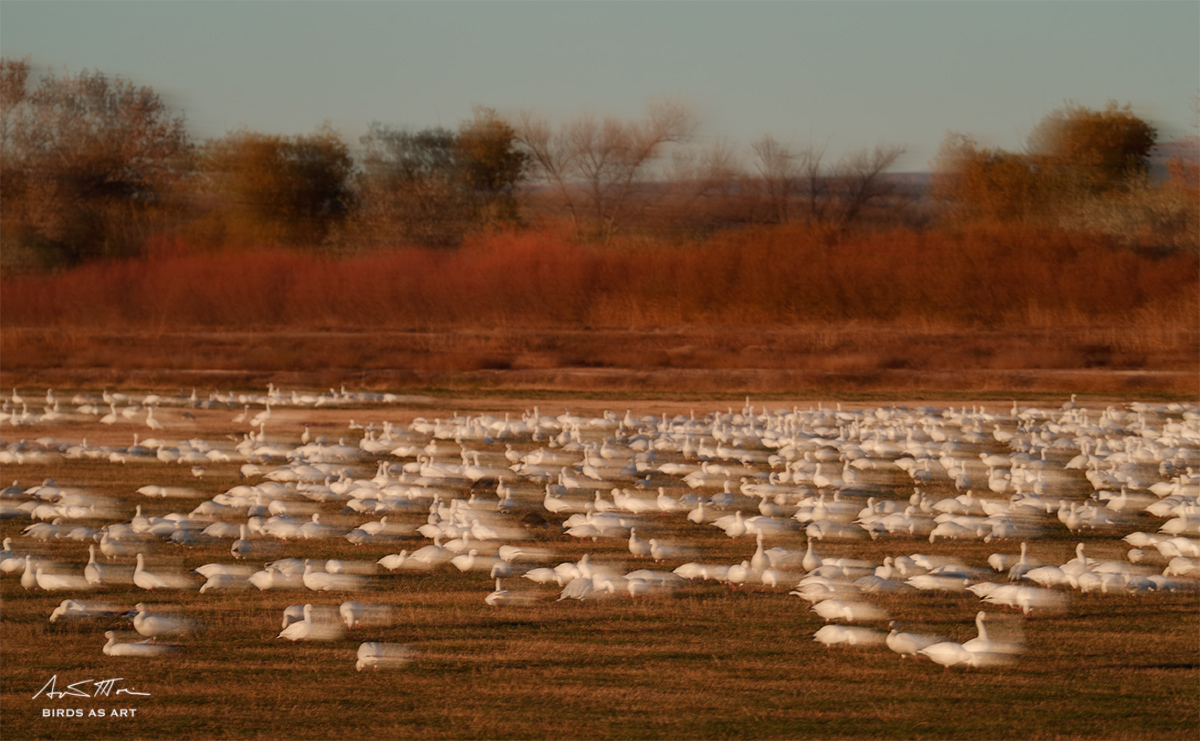
|
|
This image was created at Bosque del Apache NWR with the hand held Canon EF 100-400mm f/4.5-5.6L IS II USM lens (at 340mm) and the rugged Canon EOS-1D X. . ISO 50. Evaluative metering -1/3 stop: 1/15 sec. at f/6.3. Cloudy WB. Singh-Ray 3-stop Resin Mor-Slo Neutral Density Filter.
Two AF points below the center AF point/AI Servo Expand/Rear Focus AF as framed was active at the moment of exposure (as is always best when hand holding). Click here to see the latest version of the Rear Focus Tutorial. Click on the image to see a larger version.
Image #3: Snow Geese jiggle blur with a slight pan at the end
|
The Technique
The jiggle blur was taught to me by Denise Ippolito. Simply jiggle the lens while making a relatively long exposure. She loves 1/6 second for her jiggle blurs. Here, working at 1/15 second, I had to jiggle a bit faster. Then toward the end I added a bit of pan to the right. I was working with one of Lou Newman’s daughter when there was not too much going on. We did pan blurs, vertical pan blurs, squiggle blurs, and even a few zoom blurs. She had fun and so did I. One of the amazing things about playing with blurs as we did is that while some of the images turn out to be extremely pleasing others made seemingly with the very same technique are insta-deletes. Go figure. As we stress in “A Guide to Pleasing Blurs” the number one rule of creating pleasing blurs to to make lots of images.
Summing Up
#1: Sharp images of goose blast-offs made in bright sun, on sun angle or not, simply do not work. All are invited to send me their very favorite bright sun/high shutter speed white geese blast-off via e-mail: a sharpened 1000 pixel wide JPEG is best.
#2: Having a 3-stop or 5-stop drop-in ND in place lets you get down to really slow shutter speeds in bright sun while avoiding the tiny apertures like f/22 and f/32 that maximize the effects of sensor dust. Remember: do not use even the 3-stop ND if doing so makes you use a higher ISO.
#3: Well done pleasing blurs win contests.
#4: I am always amazed by the variety of looks that you can come up with when working at very slow shutter speeds. To me it feels a lot like playing. You can vary your panning speed or even hold the lens still. Tip: if the latter you need to go to faster shutter speeds like 1/30 or 1/60 second lest the birds be rendered as long, unrecognizable streaks…. All are invited to join the fun.
#5: While the techniques above are great at Bosque, they can rock as well at any location where there are large groups of birds in the air at any one time.
|
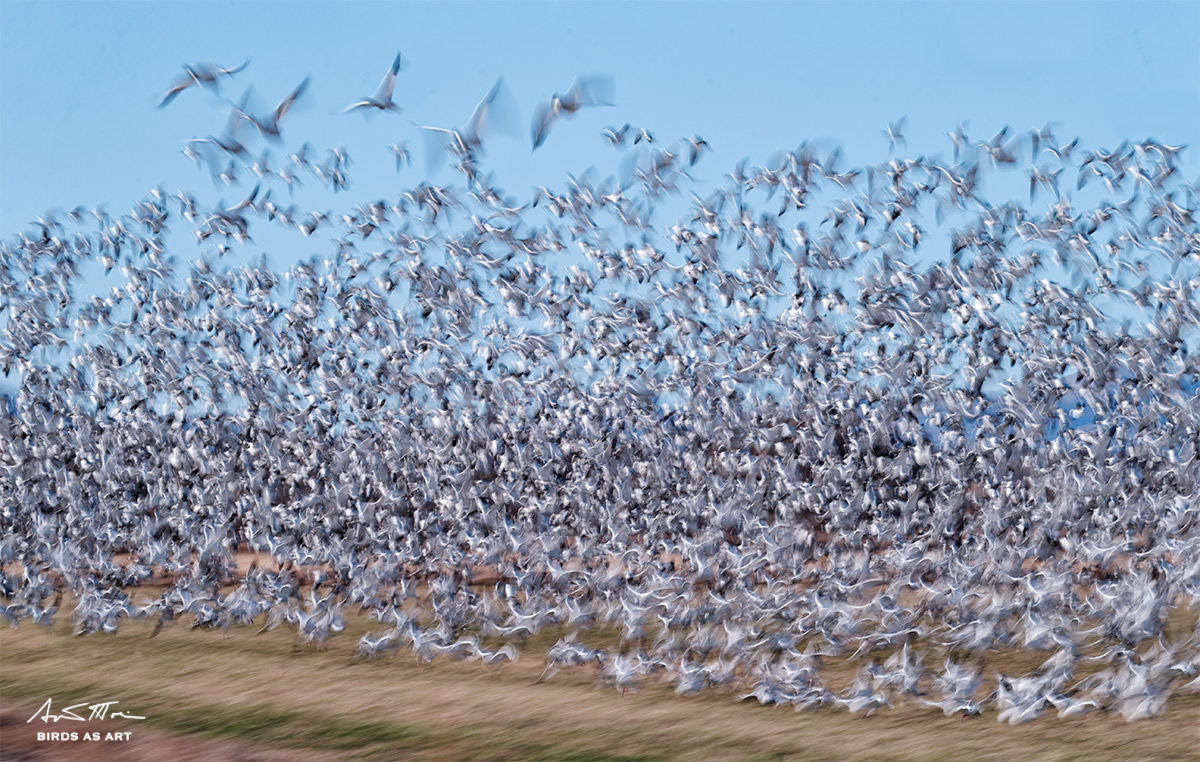
|
|
This image was created at Bosque del Apache NWR with the hand held Canon EF 100-400mm f/4.5-5.6L IS II USM lens (at 200mm) and the rugged Canon EOS-1D X. . ISO 50. Evaluative metering +2/3 stop: 1/15 sec. at f/9. Cloudy WB. Singh-Ray 3-stop Resin Mor-Slo Neutral Density Filter.
Two AF points up from the center AF point/AI Servo Surround/Rear Focus AF as framed was active at the moment of exposure (as is always best when hand holding). Click here to see the latest version of the Rear Focus Tutorial. Click on the image to see a larger version.
Image #4: Snow Geese flock blast off coming at you
|
Your Fave?
Which of today’s four features images do you like best? Do let us know why.
Xume Stuff!
I think that it was blog regular Mike Cristina who first mentioned the magnetic Xume filter holder system to me. IAC, I tried it and loved it. But I do not recommend the system for all lenses; see below on that….
First I screw one XUME 77mm Lens Adapter onto the front of my 100-400 II and another onto the front of my 70-200 f/2.8 L IS II.
Next I screw my Singh-Ray 77mm 3-Stop Resin Mor-Slo Neutral Density Filter, my Singh-Ray 77mm 5-Stop Glass Mor-Slo Neutral Density Filter, and my Singh-Ray 77mm LB Warming Circular Polarizer into their own individual XUME 77mm Filter Holders.
The lens adapters stay on the lenses. The ND filters and the polarizer stay screwed into their own filter holder. The filter/filter holder combos are stored in the lovely labeled leather pouches that come with each Singh-Ray filter purchase. They three of them fit perfectly into the small upper left zippered pocket of my Xtrahand vest. When I wish to mount a filter onto the front of one of my intermediate telephoto lenses I simply remove the lens hood, grab the filter that I need, and pop it securely into place in less than an instant. Ah, it’s the magnetic thing!
Be sure to replace the lens hood so that you do not accidentally dislodge the filter by whacking it against some shrubbery. To remove the filter simply remove the lens hood, pop the filter off instantly, place it back in its leather case, and stow it. With the Xume system there are no more tears. You do not have to screw and unscrew the filters onto the front of the lens. There are no more jammed threads. The Xume lens adapters and the filter holders are precision-machined to guarantee fast and secure filter attachment every time.
It is an elegant system but I can recommend it only for intermediate telephoto lenses: when used with short lenses and short zoom lenses it some serious vignetting will occur at the wide(r) focal lengths.
If you own only one lens and two filters I would recommend the XUME 77mm Lens Adapter and Filter Holder Starter Kit. It contains one lens adapter and two filter holders.
The next step up is the XUME 77mm Lens Adapter and Filter Holder Pro Kit. It offers two lens adapters and four filter holders. That one was perfect for me.
If you need Xume stuff for front element sizes other than 77mm please use this link; you will find two pages of good stuff!
Namibia
Photos of Namibian dunes, dead trees, birds, and wildlife often grace prestigious natural history calendars and are honored annually in pretty much all of the top flight nature photography contests including and especially the BBC Wildlife Photographer of the Year Competition and the Nature’s Best Windland Smith Rice International Awards Contest. Both denise and I have long dreamed of visiting. Our dream is coming true. With four folks signed up before the tour was even announced, this trip is a go. Most traveling from the US will likely want to be on one of the direct flights to Johannesburg, South Africa from New York’s JFK (on April 13, 2015 so as to arrive in Windhoek on the 14th). In addition, we would both be thrilled to meet some of our overseas followers on this trip.
In addition to enjoying several world class nature photography locations, you will learn more than you ever thought possible via in-the-field instruction from two of the best and informal image sharing and Photoshop sessions at the lodge. We hope that you can join us.
The 2016 Namibia BIRDS AS ART/A Creative Adventure Instructional Photo-Safari: April 14-28, 2016 on the ground: $8999. Limit: 10 photographers/openings: 4.
Our truly great itinerary is below. This workshop was planned with the help of two BBC-honored local photographers with an intimate knowledge of the area who will act as our guides for the entire trip. This IPT will be co-led by Denise Ippolito and yours truly. The dates and the price are set in stone: April 14-28, 2016. 15/days/14 nights: $8999 from Windhoek, Namibia (Hosea Kutako International Airport, airport code WDH). Please contact me via e-mail if you would like to register. Then please fill out, print, and sign the Registration and Release forms that are linked to here. Then mail it to us here: PO Box 7245, Indian Lake Estates FL 33855 along with your $3,000 non-refundable deposit check made out to “Arthur Morris.”
The second payment of $3,000 is due on November 15, 2015 and the final payment of $2,999 is due on February 1, 2015. As with the deposit, checks only.
Single supplements may be available for parts (or all) of the trip. They will be quite expensive. Best not to ask 🙂 Please inquire as to availability. If you or we are unable to line up a same sex roommate for you, you will be charged the single supplement on a pro-rated basis.
Travel Insurance
Please understand that we need the deposits for international trips as arrangements must be paid in full far in advance. If everybody decides to cancel then we are sort left holding a very short straw 🙂 Seriously interested folks are urged to consider getting trip insurance within two weeks of sending their deposit checks. There are lots of options for US residnets with Travel Services Insurance (TSI). You can explore them here.
The Namibia IPT Itinerary
Day 1: April 14, 2016. Fly into Windhoek (Hosea Kutako International Airport, airport code WDH. Spend the night at River Crossing Lodge. Note: folks traveling from the US and many other destinations will need to depart on redeye flights on April 13th. You need to be sure that you will be in Windhoek on April 14, 2015!
Day 2: Early departure to QuiverTree Forest Lodge on the outskirts of Keetmanshoop. Here we will be able to capture the beauty of the magnificent QuiverTree forest as well as have access to the Giant Playground area for some spectacular landscape photography. The sessions will include afternoon and evening shoots, the latter with stars, milky way, and star trails photography. Night photography instruction will be provided. In addition, we will let you know in advance what lenses and accessories you will need for the night photography.
Day 3: After breakfast we depart for the luxurious Sossusvlei Dune Lodge for 3 nights inside Namib Naukluft National Park. The distance to Sossusvlei is about 550km and the trip should take about 7 hours. Thanks to our experienced guides we will enjoy unparalleled after hours access to dead tree scenics at Dead Vlei. Arrangements have been made to to leave the lodge in the mornings an hour before sunrise to capture the best possible lighting conditions. We will be visiting Dead Vlei and Dune 45. There is a fairly strenuous up-and-down hike to some of the best photo locations that should take really fit folks about 15-20 minutes and as much as 45 minutes for the older fit folks or those with a bad knee. Denise is in the former category, Artie fits in both of the latter categories :). At Sossusvlei two desert systems come together: the beautiful red dunes of the Kalahari desert and the breathtakingly stark Namib desert. The desert experience is a surreal and life-changing one and even the best images do not reflect the amazing beauty of these unique deserts. Deadvlei, with its ancient trees in the now dried up lake, is a feast for photographers who are looking for something stark, different, and dramatic. Along with the spectacular landscapes we should get to photograph some wildlife as well with chances for oryx and springbok among others.
Day 6: From Sossusvlei we head off to Swakopmund to spend some three nights at the Swakopmund Beach Hotel. One morning will head into the dunes to target species such as the Desert Chameleon, Horned Adder, Sand-Diving Lizards, and Palmato Gecko—the world’s cutest gecko. We will spend time photographing the amazing bird life in and around the Walvisbay area. The Salt Mine and bay area is especially productive with a huge selection of waders and other waterfowl along with large numbers of flamingoes. We will enjoy one chartered boat trip to target pelicans in flight. Those and a selections of skua’s and cormorants will keep the most discerning bird photographers happy. Afternoons in the area will be spent driving along the beach to the huge seal colonies and photographing their playful interactions and antics. A tentative schedule is below:
Day 7: Morning (private tour) Desert Experience photographing Palmato Gecko / Sidewinders / Desert Chameleon etc, etc. Afternoon we either shoot Pelican point for seals or Walvisbay for flamingos and more.
Day 8: Morning bay cruise with chartered boat shooting pelicans flying in . We will likely spend the afternoon with the seals at Pelican point.
Day 9: After breakfast we depart for Etosha; arrive that afternoon at Halali and spend 3 nights there. Just when you thought it could not get any better we head further north to the wide-open plains of Etosha. Here the wildlife spectacle is arguably one of the best in Africa. Etosha is home to not only the Big Five, but also a variety of other species such as Cheetah, Honey Badger, Oryx, Springbok, Dik-Dik, Black-Faced Impala, Eland, Ostrich and more. Depending on our route this could take as long as four hours to get to the park entrance and another 2 hours drive to Halali. We will travel about 400km
Day 12:. We wrap-up at Halali and move down to Okaukuejo where we will spend three nights. Okaukuejo Camp is famous for its large floodlit waterhole, the hub of animal activity especially in the early morning and early evening hours. We will see and photograph many species including and especially the endangered Black Rhino. There will be game drives during the say. For the night water hole photography flash is optional but recommended.
Day 15: April 28, 2016. We make the 4-5 hour drive back to Windhoek in time for your international flights.
This price of this tour includes:
All Accommodations.
All breakfasts and dinners.
Logistics make formal lunches impossible. There will, however, be a variety of snacks including nuts and cheeses along with sodas and bottled drinking water in each vehicle.
Bottled water at the lodges and in the vehicles. Also included at the lodges are soft drinks and sodas and local wines and liquors (excluding premium and imported hard drinks).
All transportation from the time you arrive in Windhoek to the time you leave again.
All park entrance fees
One extra-late night in Deadvlei where we will use NWR vehicles for transport.
The chartered boat activities in Walvisbay.
The Private Desert Experience tour in Swakopmund.
The price of this tour does not include:
Your flights to and from Windhoek.
Visa costs: no visa is needed for folks from the US and most other countries.
Gratuities and items of a personal nature.
The Bosque Site Guide
If you can’t make or afford a Bosque IPT, or if the holidays preclude your joining one, be sure to get yourself a copy of my Bosque Site Guide. All BAA Site Guides are designed so that with a bit of study you can show up at a great place and know exactly where to be at what time on what wind and in what lighting conditions. And on what wind. With a Site Guide on your laptop you will feel like a 22-year veteran on your first visit. Site Guides are the next best thing to being on an IPT. If you plan on visiting Bosque it would be foolish to make the trip without having this guide in hand. Why spend money on gear and travel and then spend days stumbling around in the wrong spot? If you have visited previously, and are still unsure of where you should be at this time of day with that wind, this guide will prove invaluable to you as well. Even folks visiting Bosque for the tenth time will learn a ton as I share my secrets and hold nothing back….
In the next week or so, I will be working on a very short but valuable information-packed 2015 Bosque Current Conditions Guide; it will be send free to all who have previously purchased the Bosque Site Guide and will also be available as an inexpensive, separate, stand-alone purchase.


Please Remember to use our Affiliate Links 🙂
To show your appreciation for my continuing efforts here, we ask, as always, that you use our the B&H and Amazon affiliate links on the right side of the blog for all of your purchases. B&H is recommended for you major photography gear purchases, Amazon for your household, entertainment, and general purpose stuff. Please check the availability of all photographic accessories in the BIRDS AS ART Online Store, especially the Mongoose M3.6 tripod heads, Gitzo tripods, Wimberley heads and plates, LensCoats and accessories, and the like. We sell only what I have used, have tested, and can depend on. We will not sell you junk. We know what you need to make creating great images easy and fun. And we are always glad to answer your gear questions via e-mail. I just learned that my account was suspended during my absence; it should be up and running by Monday at the latest.
I would of course appreciate your using our B&H affiliate links for all of your major gear, video, and electronic purchases. For the photographic stuff mentioned in the paragraph above we, meaning BAA, would of course greatly appreciate your business. Here is a huge thank you to the many who have been using our links on a regular basis and visiting the BAA Online store as well.
Facebook
Be sure to like and follow BAA on Facebook by clicking on the logo link upper right. Tanks a stack!
Typos
In all blog posts and Bulletins, feel free to e-mail or to leave a comment regarding any typos or errors. Just be right 🙂
December 15th, 2015
|
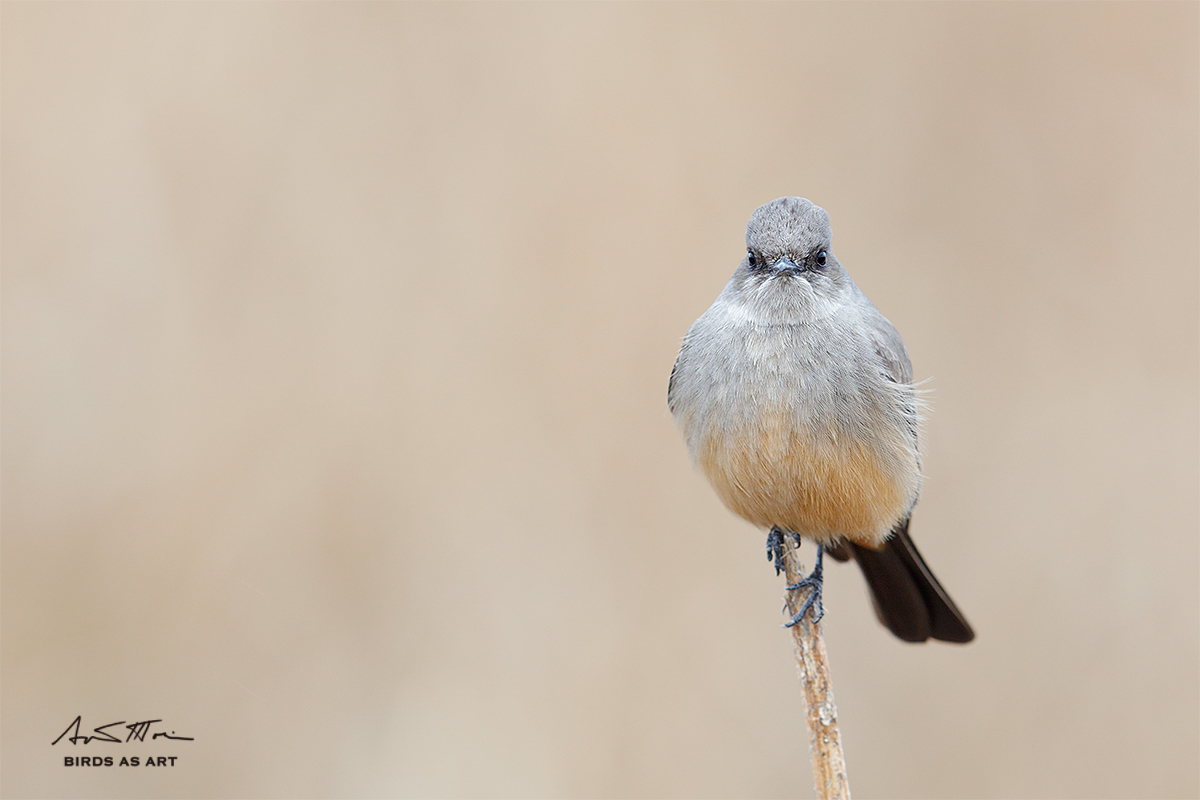
|
|
This image was created at Bosque del Apache on a rare morning off between IPTs with the Induro GIT 304L tripod/Mongoose M3.6-mounted BLUBB-supported Canon EF 600mm f/4L IS II USM lens, the Canon Extender EF 1.4X III,, and the incredible Canon EOS 5DS R. ISO 800. Evaluative metering +2/3 stop: 1/200 at f/6.3 in Av mode. AWB.
Center AF point (Manual selection)/AI Servo Expand/Rear Focus AF on the bird’s neck and re-compose. Click here to see the latest version of the Rear Focus Tutorial. Click on the image to see a larger version.
Say’s Phoebe, car as blind
|
Image Question
Why is the bird’s left eye (the one on our right) ever-so-slightly sharper than the bird’s right eye?
The 5DS R Image
With my 5DS R I have pretty much avoided photographing tiny-in-the frame birds and then executing huge crops as many have done. Today’s featured image was, however, a healthy crop from the original. The optimized TIFF is 84mb out of the original 144mb. If my math is correct, I have cropped away 42% of the original while keeping 58%. I’d call that a 42% crop. In any case, the image is quite sharp.
5DS R Info Updates
The Advanced Mirror control mechanism and shutter release time lag feature that I was rightfully confused about (in the blog post here) deals only with Mirror Lockup situations. Therefore, it has zero to do with bird photography and is of no interest to me.
Folks can download the EOS 5DS, EOS 5DS R Instruction Manual (PDF) by clicking here and then scrolling down a bit and clicking on Brochures. The Instruction Manual comes up as item one.
I asked Canon USA’s top tech rep, Chuck Westfall, if he knew of a link to a list of Canon-recommended lenses that are compatible with the 5DS R.
He replied, “There is intentionally no such list. The 5DS R is officially compatible with all Canon EF (but not EF-S) lenses. Generally speaking, best results will be obtained with L-series professional lenses as well as with select non-L EF prime lenses such as EF Macro, TS-E, etc.”
|
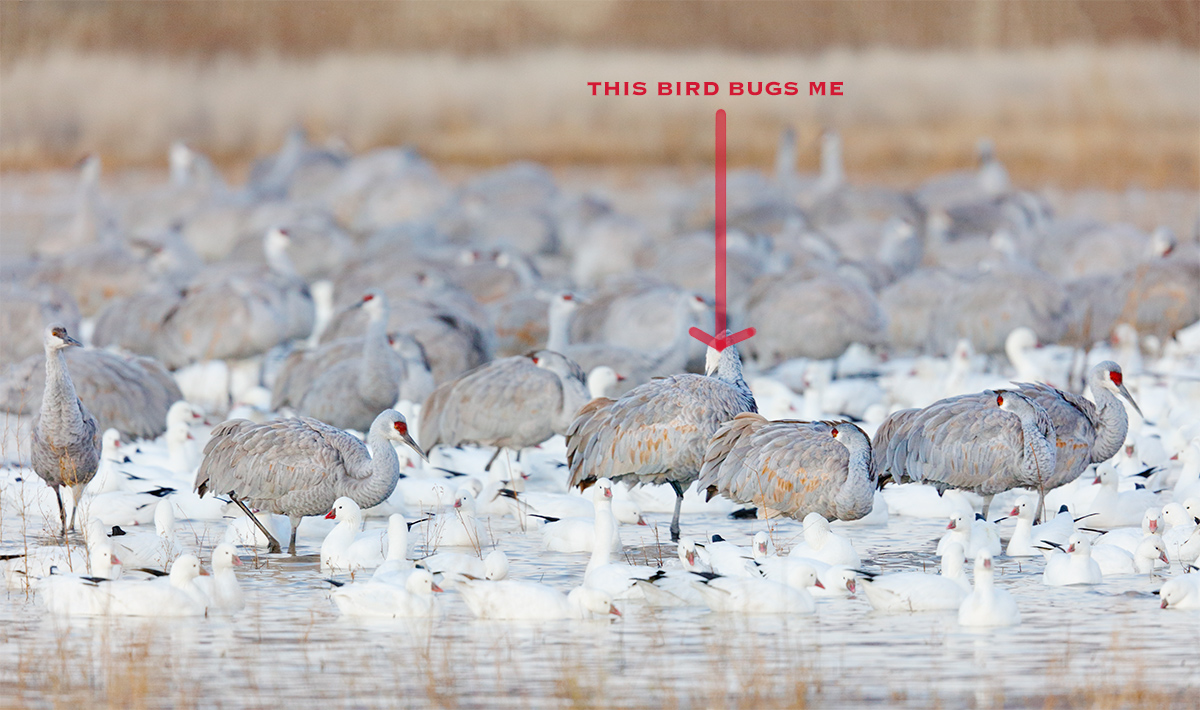
|
|
The Offending Crane…
|
The Offending Crane
In the extremely popular “On Photographing Piles of Cranes and Geese at Bosque del Apache NWR” blog post here, I asked, “Which crane bugs me?” Thanks to the many who left comments. Lots of different birds bothered lots of different folks but a few went directly to the bird singled out by the red arrow in the image above. Especially me.
Why?
#1: The offending crane was the only one in the row of cranes that was in relatively sharp focus that did not have a pleasing head position. I was fine with the sleeping birds and fine with the bird on the left frame edge that was looking straight ahead. I thought that that bird made for a perfect left side frame. And I was fine with the bird on the right that was looking out of the frame.
#2: The offending bird’s head was turned away from the viewer. We could not see any of its face. And, as one commenter noted, the small dark area just above the offending bird’s head was distracting. It was actually a shadow.
#3: Had the offending bird been sleeping it would have completed a perfect crescent of four sleeping cranes that would have been perfectly complimented by the aforementioned crane near the right frame edge.
BTW
Even though that single bird bugs me I love the image for its pleasing design and for the narrow depth of field encourages the viewer’s eye to move around the image from focused birds to de-focused birds both in the foreground and background and then back again. And I love the soft light.
Namibia
Photos of Namibian dunes, dead trees, birds, and wildlife often grace prestigious natural history calendars and are honored annually in pretty much all of the top flight nature photography contests including and especially the BBC Wildlife Photographer of the Year Competition and the Nature’s Best Windland Smith Rice International Awards Contest. Both denise and I have long dreamed of visiting. Our dream is coming true. With four folks signed up before the tour was even announced, this trip is a go. Most traveling from the US will likely want to be on one of the direct flights to Johannesburg, South Africa from New York’s JFK (on April 13, 2015 so as to arrive in Windhoek on the 14th). In addition, we would both be thrilled to meet some of our overseas followers on this trip.
In addition to enjoying several world class nature photography locations, you will learn more than you ever thought possible via in-the-field instruction from two of the best and informal image sharing and Photoshop sessions at the lodge. We hope that you can join us.
The 2016 Namibia BIRDS AS ART/A Creative Adventure Instructional Photo-Safari: April 14-28, 2016 on the ground: $8999. Limit: 10 photographers/openings: 4.
Our truly great itinerary is below. This workshop was planned with the help of two BBC-honored local photographers with an intimate knowledge of the area who will act as our guides for the entire trip. This IPT will be co-led by Denise Ippolito and yours truly. The dates and the price are set in stone: April 14-28, 2016. 15/days/14 nights: $8999 from Windhoek, Namibia (Hosea Kutako International Airport, airport code WDH). Please contact me via e-mail if you would like to register. Then please fill out, print, and sign the Registration and Release forms that are linked to here. Then mail it to us here: PO Box 7245, Indian Lake Estates FL 33855 along with your $3,000 non-refundable deposit check made out to “Arthur Morris.”
The second payment of $3,000 is due on November 15, 2015 and the final payment of $2,999 is due on February 1, 2015. As with the deposit, checks only.
Single supplements may be available for parts (or all) of the trip. They will be quite expensive. Best not to ask 🙂 Please inquire as to availability. If you or we are unable to line up a same sex roommate for you, you will be charged the single supplement on a pro-rated basis.
Travel Insurance
Please understand that we need the deposits for international trips as arrangements must be paid in full far in advance. If everybody decides to cancel then we are sort left holding a very short straw 🙂 Seriously interested folks are urged to consider getting trip insurance within two weeks of sending their deposit checks. There are lots of options for US residnets with Travel Services Insurance (TSI). You can explore them here.
The Namibia IPT Itinerary
Day 1: April 14, 2016. Fly into Windhoek (Hosea Kutako International Airport, airport code WDH. Spend the night at River Crossing Lodge. Note: folks traveling from the US and many other destinations will need to depart on redeye flights on April 13th. You need to be sure that you will be in Windhoek on April 14, 2015!
Day 2: Early departure to QuiverTree Forest Lodge on the outskirts of Keetmanshoop. Here we will be able to capture the beauty of the magnificent QuiverTree forest as well as have access to the Giant Playground area for some spectacular landscape photography. The sessions will include afternoon and evening shoots, the latter with stars, milky way, and star trails photography. Night photography instruction will be provided. In addition, we will let you know in advance what lenses and accessories you will need for the night photography.
Day 3: After breakfast we depart for the luxurious Sossusvlei Dune Lodge for 3 nights inside Namib Naukluft National Park. The distance to Sossusvlei is about 550km and the trip should take about 7 hours. Thanks to our experienced guides we will enjoy unparalleled after hours access to dead tree scenics at Dead Vlei. Arrangements have been made to to leave the lodge in the mornings an hour before sunrise to capture the best possible lighting conditions. We will be visiting Dead Vlei and Dune 45. There is a fairly strenuous up-and-down hike to some of the best photo locations that should take really fit folks about 15-20 minutes and as much as 45 minutes for the older fit folks or those with a bad knee. Denise is in the former category, Artie fits in both of the latter categories :). At Sossusvlei two desert systems come together: the beautiful red dunes of the Kalahari desert and the breathtakingly stark Namib desert. The desert experience is a surreal and life-changing one and even the best images do not reflect the amazing beauty of these unique deserts. Deadvlei, with its ancient trees in the now dried up lake, is a feast for photographers who are looking for something stark, different, and dramatic. Along with the spectacular landscapes we should get to photograph some wildlife as well with chances for oryx and springbok among others.
Day 6: From Sossusvlei we head off to Swakopmund to spend some three nights at the Swakopmund Beach Hotel. One morning will head into the dunes to target species such as the Desert Chameleon, Horned Adder, Sand-Diving Lizards, and Palmato Gecko—the world’s cutest gecko. We will spend time photographing the amazing bird life in and around the Walvisbay area. The Salt Mine and bay area is especially productive with a huge selection of waders and other waterfowl along with large numbers of flamingoes. We will enjoy one chartered boat trip to target pelicans in flight. Those and a selections of skua’s and cormorants will keep the most discerning bird photographers happy. Afternoons in the area will be spent driving along the beach to the huge seal colonies and photographing their playful interactions and antics. A tentative schedule is below:
Day 7: Morning (private tour) Desert Experience photographing Palmato Gecko / Sidewinders / Desert Chameleon etc, etc. Afternoon we either shoot Pelican point for seals or Walvisbay for flamingos and more.
Day 8: Morning bay cruise with chartered boat shooting pelicans flying in . We will likely spend the afternoon with the seals at Pelican point.
Day 9: After breakfast we depart for Etosha; arrive that afternoon at Halali and spend 3 nights there. Just when you thought it could not get any better we head further north to the wide-open plains of Etosha. Here the wildlife spectacle is arguably one of the best in Africa. Etosha is home to not only the Big Five, but also a variety of other species such as Cheetah, Honey Badger, Oryx, Springbok, Dik-Dik, Black-Faced Impala, Eland, Ostrich and more. Depending on our route this could take as long as four hours to get to the park entrance and another 2 hours drive to Halali. We will travel about 400km
Day 12:. We wrap-up at Halali and move down to Okaukuejo where we will spend three nights. Okaukuejo Camp is famous for its large floodlit waterhole, the hub of animal activity especially in the early morning and early evening hours. We will see and photograph many species including and especially the endangered Black Rhino. There will be game drives during the say. For the night water hole photography flash is optional but recommended.
Day 15: April 28, 2016. We make the 4-5 hour drive back to Windhoek in time for your international flights.
This price of this tour includes:
All Accommodations.
All breakfasts and dinners.
Logistics make formal lunches impossible. There will, however, be a variety of snacks including nuts and cheeses along with sodas and bottled drinking water in each vehicle.
Bottled water at the lodges and in the vehicles. Also included at the lodges are soft drinks and sodas and local wines and liquors (excluding premium and imported hard drinks).
All transportation from the time you arrive in Windhoek to the time you leave again.
All park entrance fees
One extra-late night in Deadvlei where we will use NWR vehicles for transport.
The chartered boat activities in Walvisbay.
The Private Desert Experience tour in Swakopmund.
The price of this tour does not include:
Your flights to and from Windhoek.
Visa costs: no visa is needed for folks from the US and most other countries.
Gratuities and items of a personal nature.
The Bosque Site Guide
If you can’t make or afford a Bosque IPT, or if the holidays preclude your joining one, be sure to get yourself a copy of my Bosque Site Guide. All BAA Site Guides are designed so that with a bit of study you can show up at a great place and know exactly where to be at what time on what wind and in what lighting conditions. And on what wind. With a Site Guide on your laptop you will feel like a 22-year veteran on your first visit. Site Guides are the next best thing to being on an IPT. If you plan on visiting Bosque it would be foolish to make the trip without having this guide in hand. Why spend money on gear and travel and then spend days stumbling around in the wrong spot? If you have visited previously, and are still unsure of where you should be at this time of day with that wind, this guide will prove invaluable to you as well. Even folks visiting Bosque for the tenth time will learn a ton as I share my secrets and hold nothing back….
In the next week or so, I will be working on a very short but valuable information-packed 2015 Bosque Current Conditions Guide; it will be send free to all who have previously purchased the Bosque Site Guide and will also be available as an inexpensive, separate, stand-alone purchase.


Please Remember to use our Affiliate Links 🙂
To show your appreciation for my continuing efforts here, we ask, as always, that you use our the B&H and Amazon affiliate links on the right side of the blog for all of your purchases. B&H is recommended for you major photography gear purchases, Amazon for your household, entertainment, and general purpose stuff. Please check the availability of all photographic accessories in the BIRDS AS ART Online Store, especially the Mongoose M3.6 tripod heads, Gitzo tripods, Wimberley heads and plates, LensCoats and accessories, and the like. We sell only what I have used, have tested, and can depend on. We will not sell you junk. We know what you need to make creating great images easy and fun. And we are always glad to answer your gear questions via e-mail. I just learned that my account was suspended during my absence; it should be up and running by Monday at the latest.
I would of course appreciate your using our B&H affiliate links for all of your major gear, video, and electronic purchases. For the photographic stuff mentioned in the paragraph above we, meaning BAA, would of course greatly appreciate your business. Here is a huge thank you to the many who have been using our links on a regular basis and visiting the BAA Online store as well.
Facebook
Be sure to like and follow BAA on Facebook by clicking on the logo link upper right. Tanks a stack!
Typos
In all blog posts and Bulletins, feel free to e-mail or to leave a comment regarding any typos or errors. Just be right 🙂
December 14th, 2015 What’s Up?
I worked hard on the 2015 Bosque Current Conditions Guide and watched a few pretty boring NFL games. I continue to feel better each day.
The Big UFC Fights on Pay per View
So I plunked down $60 to watch two big UFC fights. How’d that go you ask? Pretty good at first. Luke Rockhold brutally beat down the much-too-confident previously undefeated middleweight champion Chris Weidman. Rockhold was so thrilled with his success that he collapsed onto the mat once the fight was stopped, pretty close to sobbing with joy.
In the main event I was hoping that the featherweight champion, Jose Aldo, undefeated in ten years, “the best pound for pound fighter on the planet,” would shut the mouth of intentional wise guy, the notorious Irishman, Conor McGregor. How’d that work out? McGregor knocked Aldo out cold in 13 seconds with a single left hook followed by two unnecessary hammer fists to the head.
From LA Times Sports:
Conor McGregor is one of the remarkable stories in sports. The man came in talking about how great he was from day one, talking himself up like few others ever have. He then proceeded to defeat every opponent and knocked out a dominant champion who hadn’t lost in ten years in a matter of seconds. It was as if he willed it into being.
The Offender…
The offending crane in the very popular “On Photographing Piles of Cranes and Geese at Bosque del Apache NWR” blog post here, will be identified in tomorrow’s blog post.
Selling Your Used Gear Through BIRDS AS ART
Selling your used (or like-new) photo gear through the BAA Blog or via a BAA Online Bulletin is a great idea. We charge only a 5% commission. One of the more popular used gear for sale sites charges a minimum of 20%. Plus assorted fees! Yikes. The minimum item price here is $500 (or less for a $25 fee). If you are interested please e-mail with the words Items for Sale Info Request cut and pasted into the Subject line :). Stuff that is priced fairly–I offer free pricing advice, usually sells in no time flat. In the past few months, we have sold just about everything in sight. Do know that prices on some items like the EOS-1D Mark IV, the old Canon 500mm, the EOS-7D, and the original 400mm IS DO lens have been dropping steadily. You can see all current listings by clicking here or by clicking on the Used Photo Gear tab on the yellow-orange tab on the right side of the menu bar above.
Stuff has literally been flying off the shelves recently. Monte Brown’s 300 II sold in one day and the sale of Troy Duong’s 500 II is pending two days after it was listed.
Used Gear Sales Trust???
An e-mail conversation with Asta Tobiassen
Part I:
AM: Hi Asta, re:
AT: I have contacted Troy Duong, who has posted his 500 mm mark II lens for sale on Birds as Art.
AM: Mazel tov.
AT: Neither one of us has privately bought or sold anything of this value before. He lives in California and I live in Washington, so meeting is not an option. How do people do this?
AM: The buyer sends the check. The seller cashes it. When it clears, the seller ships the lens insured.
AT: Do I send him the money and then he sends the lens?
AM: Yes, as above.
AT: That seems reasonable on the sellers end, but makes me a little nervous.
AM: Some folks have been nervous. The only one who ever got really screwed was me but I learned a big lesson. The guy handed a COD teller’s check for $3K to the Fed Ex driver. The “teller’s check” was 100% phony 🙂 Twice there have been minor disagreements as to the condition of the lens. One I mediated, the other guy simply returned the lens.
AT: Are there any protections for me?
AM: If you are really nervous you might ask to call his boss at work….. That has never been done before yet everyone who has purchased a lens has gotten what they bought. That includes probably more than two hundred folks…
AT: Having talked to him on the phone, and communicated several times via email, I do feel he is trustworthy, but this is a huge chunk of change!
AM: Understood.
AT: Thank you for any advice.
AM: Good luck. I say this often—I am from New York, and I am the most trusting person you will ever meet. Go figure.
later and love, artie
Asta’s reply:
Dear Artie, Thanks again. I truly appreciate your thorough and incredibly quick response! Thank you for offering this service. I have wanted to purchase the Series II 500mm lens for quite some time, but have not been able to justify the expense. Well, life is short and the thought of saving $1500 off the new lens price made me realize the time is now. Were it not for the reputation you have built I would not have considered making such a big purchase online like this. You have also been incredibly generous in sharing your knowledge and expertise, for which I cannot thank you enough. All my best, Asta
|
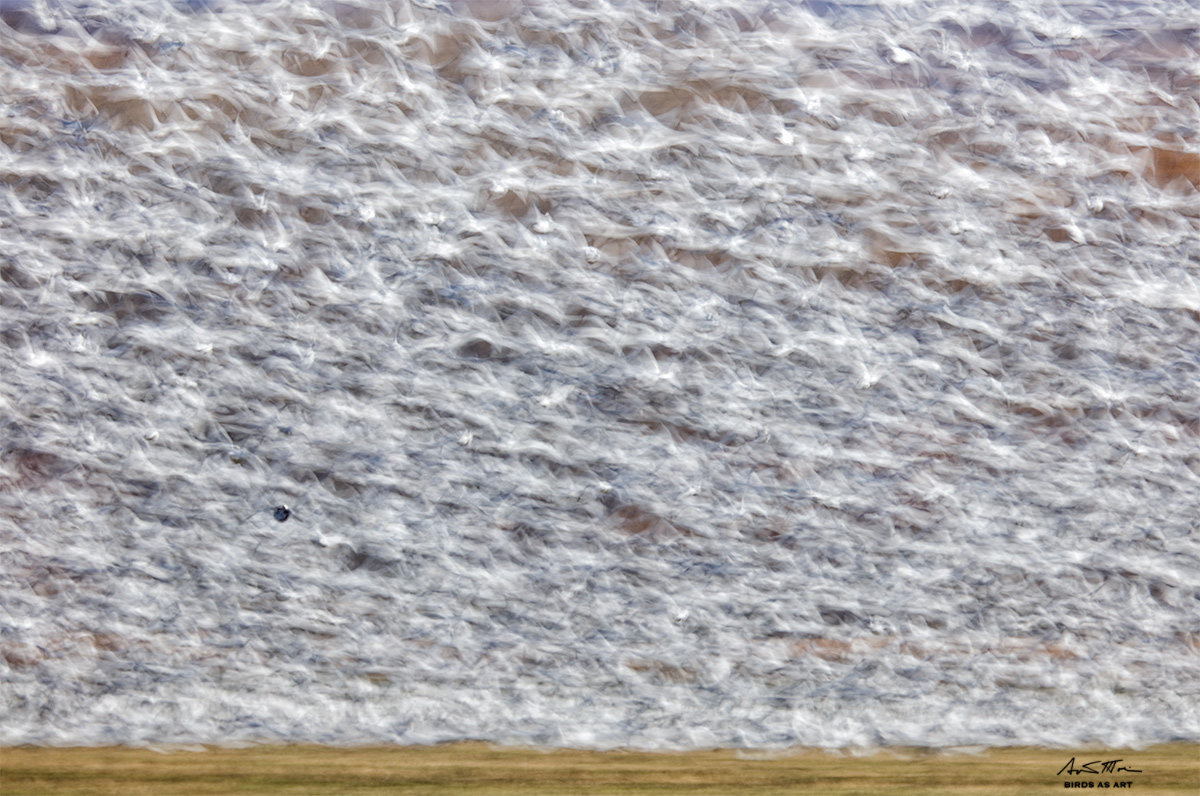
|
|
This image was created at Bosque del Apache NWR on November 30, 2015, the 2nd morning of the second IPT. I used the Induro tripod/Mongoose M3.6-mounted Canon EF 600mm f/4L IS II USM lens, the Canon Extender EF 2X III, and the Canon EOS 5DS R DSLR. ISO 50: 1/4 sec. at f/8 in Manual mode. AWB.
Center AF point (by necessity)/AI Servo Expand/Rear Focus AF as framed was active at the moment of exposure. Click here to see the latest version of the Rear Focus Tutorial. Click on the image to see a larger version.
Image #1: Snow Geese Blizzard
|
Bright Sun?
“There is no way that these images were made in bright sun” you say. Well, not only were they made in bright sun, but the flock in image above was about 75 degrees off sun angle. Read on to learn the magical solution to taming bright sun at Bosque del Apache NWR.
Exposure Question
How do the exposure settings in the two images compare?
Image #1 Question
Which is my favorite goose?
Your Fave?
Which of today’s featured images do you like best? Be sure to let us know why.
Amazingly
Amazingly, the image featured in the “Messing Around” blog post here was from the very same mega-blast. (I had forgotten that I described the mega-blast off in that post. But it was worth writing about twice!)
|
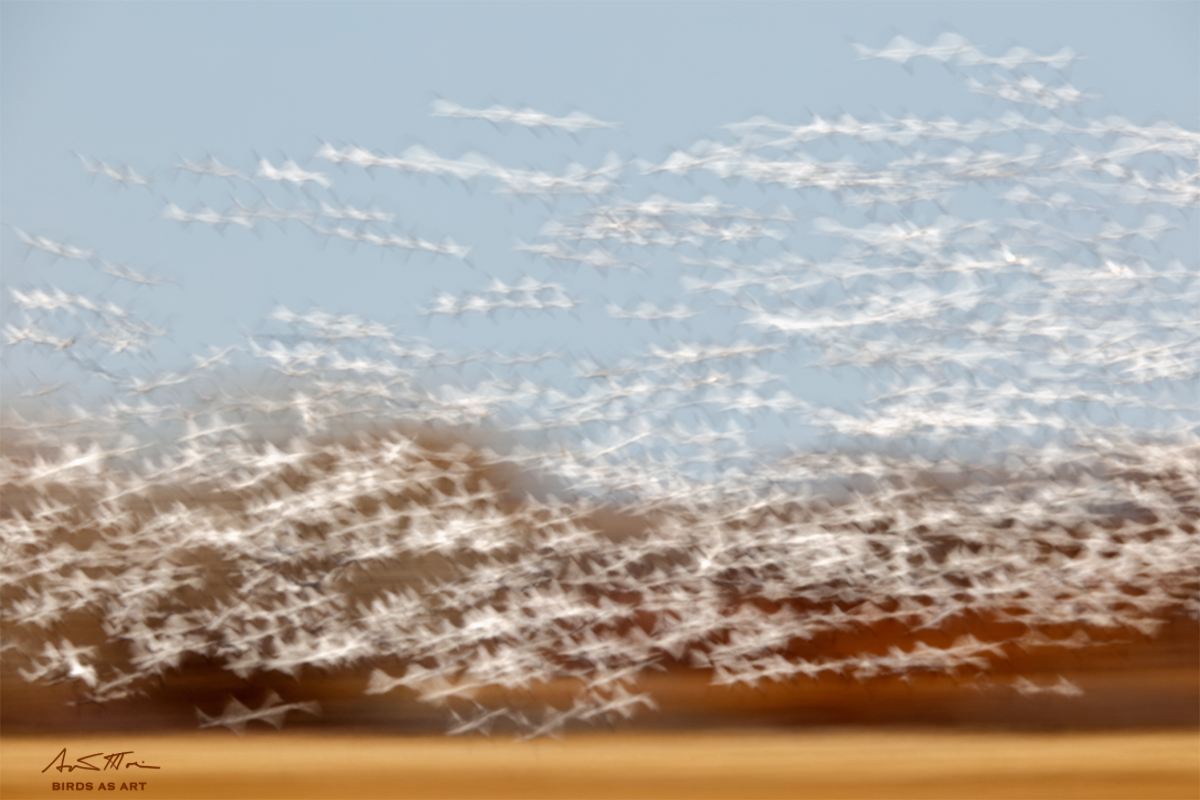
|
|
This image was also created at Bosque del Apache NWR on November 30, 2015, the 2nd morning of the second IPT. I used Induro tripod/Mongoose M3.6-mounted Canon EF 600mm f/4L IS II USM lens, the Canon Extender EF 2X III, and the Canon EOS 5DS R DSLR. ISO 50: 1/2 sec. at f/11 in Manual mode. AWB.
Center AF point (by necessity)/AI Servo Expand/Rear Focus AF as framed was active at the moment of exposure. Click here to see the latest version of the Rear Focus Tutorial. Click on the image to see a larger version.
Image #2: Fusili Snow Geese
|
Fusili Snow Geese
Adapted from Dictionary.com
fusilli [fyoo-see-lee,or fyoo-sil-ee] Noun: a type of pasta twisted into corkscrew or spiral shapes
The Story
An Excerpt from the 2015 Bosque Current Conditions Guide (coming soon)
On the morning November 30 with the IPT group, we set a time limit of 10:15am. At that time we would have to head back to town for lunch followed by our daily slide program. Thousands of geese were pouring into the back right corner of the first field after you make the left turn to the farm fields. More and more geese followed. Then about five thousand previously unseen geese blasted off from the big cornfield to our left and joined the milling masses. And the clock ticked. There were two false alarm blasts where the birds started to go and then fizzled. By 10:13am, the birds were a seething mass. They were ready to go.
I breathed deeply in and out while raising my arms to the heavens in an attempt to send some energy to the flock. “F.B.C.” I shouted out to the group, “Faith, belief, and confidence!” At 10:14 it happened. A mega blast-off that lasted probably close to three full minutes, an eternity for a blast off and left everyone in the group first gasping with amazement and then giggling uncontrollably with joy.
Taming Bright, Off-Angled Sun Blast-offs with Long Lenses at Bosque
Taming the bright off-angled sun is easy if you have a Singh-Ray 3-stop Resin Mor-Slo or 5-stop Glass Mor-Slo Neutral Density filter in one of the upper pockets of your Xtrahand vest. Or both. Each needs to be mounted in it’s own drop-in filter holder. The whole kit and kaboodle is kept in the elegant leather case that your Singh-Ray filter comes in. When you want and need to get to a really, really slow shutter speed without having to shoot at f/too-many dust bunnies simply remove the clear drop-in filter from your lens and replace it with one of your drop-in NDs. I always use the 5-stop in bright sun and the 3-stop on cloudy-bright or cloudy days. You should not have either in place in extreme low light situations such as in the pre-dawn or at dusk.
Note: keep an old cotton t-shirt and a small bottle of LensClens in a 1-gallon zip-lock bag either in your vest or in your Think Tank roller so that you can regularly clean your drop-ins in the field. You should also include a small, soft paint brush in your clean-up kit so that you can brush off any dust before wet-cleaning your drop-ins. I also include a few q-tips for cleaning the camera’s viewfinder.
With the 5-stop Mor-Slo it will take your eye a few moments to get used to the relatively dark view but your lens will focus just fine. Now you can easily get down to 1/8, 1/4, or 1/2 second even in bright sun.
Why Blurs?
On the first 2015 Bosque IPT, multiple IPT veteran and good friend Lou Newman said, “I actually saw one blast-off blur that I liked.” I said, “Lou, I’ve got you beat; I have never seen even one sharp Snow Goose blast-off image made on a sunny day that I liked.” On sunny days sharp goose blast-off images made at shutter speeds of from 1/1000 to 1/4000 sec. suffer from super-high contrast that includes harsh whites and deep black shadows that completely ruin the images for me. So how in the world did the two images featured in today’s blog post, images that were created in bright, sunny conditions, wind up looking as if they were made on a cloudy day? It was easy, due to the blend/blur effect.
Getting to the Point: The Blend Blur Effect
When you are working at extremely slow shutter speeds such as those between 1/8 and ½ or even one full second and panning as you shoot, the whites of the geese effectively blend with the middle tones of the background thus softening the otherwise harsh whites as you pan. And the background is softened as well. Bright sun is magically transformed into cloudy bright.
You can prove to yourself that the blend blur effect exists as follows: With an ND filter in place and a very slow shutter speed set—hint: you need to be in Manual mode–play with your settings and make a few test exposures until you have at least some blinkies on the white geese. Now take a second test exposure while panning: no more blinkies. You have just proven to yourself that the blend blur effect does indeed exist. In addition to creating wonderful pan-blurs you can tame the harsh light at any time of day, even high noon.

Singh-Ray Filters
Singh-Ray filters have been used by the world’s top photographers for many decades. As always, I will have my 77mm Singh-Ray Warming Polarizer in my vest in case of rainbows. And I now travel (as above) with various Singh-Ray ND filters so that I can create pleasing blurs even with clear skies and bright sun. See here for a great example.
No other filter manufacturer comes close to matching the quality of Singh-Ray’s optical glass that is comparable to that used by NASA. And they continue to pioneer the most innovative products on the market like their ColorCombo polarizer, Vari-ND variable and Mor-Slo 15-stop neutral density filters. When you use their filters, you’ll create better, more dramatic images and, unlike other filters, with absolutely no sacrifice in image quality. All Singh-Ray filters are handcrafted in the USA.
Best News: 10% Discount/Code at checkout: artie10
To shop for a Singh-Ray’s most popular solid ND filter, the 10-Stop Mor-Slo Glass Filter liter (for example), click on the logo link above, click on “Neutral and color Solid Neutral Density Filters (glass), then click on “Mor-Slo™ 5, 10, 15 and 20-Stop Solid Neutral Density Filters (glass),” choose the size and model, add to cart, and then checkout. At checkout, type artie10 into the “Have a coupon? Click here to enter your code” box, and a healthy 10% discount will be applied to your total. In addition to enjoying the world’s best filter at 10% off you will be supporting my efforts here on the blog.
The 10- and 15-stop Mor Slo filters are great for landscapes with water and moving clouds. With the 10-stop, 1/125th becomes 8 seconds and with the 15-stop, 4 minutes. I now own the 10-stop ND and will look for opportunities to use it. I am also testing their new Hi-Lux filters. More on that at some point.
Important Ordering Info for Singh-Ray 52mm Drop-In ND Filters
Singh-Ray offers both a 3-stop Resin Neutral Density filter ($124) and a 5-stop Glass ND filter ($275) to fit the filter drawers of Canon Super-telephoto lenses. If you will be heading to Bosque or to any location where you might be photographing large flocks of birds in flight with long glass, you will want at least one of the 52mm ND filters in your Xtrahand vest (in its own filter holder). To order one of the 52mm Mor-Slo filters for Canon, you will need to call Singh-Ray at 1-800-486-5501 (toll free) or 1-863-993-4100 (eastern time zone). Tell them that you want either the 52mm 3-stop Resin Mor-Slo ND or the 52mm 5-stop Glass ND (or both) and give them code artie10. Remember, you will absolutely need an extra filter holder or two:) See below for info on those.
Folks who use other brand lenses such as Nikon will need to follow the procedure above, specify their lens brand and drop-in filter size, and mention the artie10 code. But first they need to make sure that they can purchase an empty filter holder or two.
After I mount the two 52mm drop-in NDs in the filter holders, I store each, kit and kaboodle, in the leather case that each filter came in. Each then goes into the small zippered pocket on the upper right of my Xtrahand Vest.
Please remember that you will not get your 10% discount without mentioning the artie10 code. And I would not receive my affiliate commission. We can’t have that 🙂 Thanks as always for remembering to use our discount/affiliate code with your Singh-Ray phone and web orders.
52mm Filter Holder Insanity
It would be insanity to have to screw out the glass filter and then screw in a 52mm ND filter each time that you need it. The only option is to purchase a spare Canon 52mm Drop-in filter holder or two, screw the filter in, and keep that setup intact and ready to use. Singh-Ray includes a really neat soft leather filter holder with each purchase. I store all of the filters that I travel with in one of the small upper zippered pockets of my Xtrahand vest. I now have three extra filter holders and have the 3-Stop 52mm Resin ND, the 5-Stop 52mm Glass ND, and the new Hi-Lux filter to Bosque.
Summing Up
#1: Sharp images of goose blast-offs made in bright sun, on sun angle or not, simply do not work. All are invited to send me their very favorite bright sun/high shutter speed white geese blast-off via e-mail: a sharpened 1000 pixel wide JPEG is best.
#2: Having a 3-stop or 5-stop drop-in ND in place lets you get down to really slow shutter speeds in bright sun while avoiding the tiny apertures like f/22 and f/32 that maximize the effects of sensor dust. Remember: do not use even the 3-stop ND if doing so makes you use a higher ISO.
#3: Well done pleasing blurs win contests.
#4: I am always amazed by the variety of looks that you can come up with when working at very slow shutter speeds. To me it feels a lot like playing. You can vary your panning speed or even hold the lens still. Tip: if the latter you need to go to faster shutter speeds like 1/30 or 1/60 second lest the birds be rendered as long, unrecognizable streaks…. All are invited to join the fun.
#5: While the techniques above are great at Bosque, they can rock as well at any location where there are large groups of birds in the air at any one time.
Coming Soon
Coming soon to the blog: a similar feature on using the 77mm Singh-Ray Mor-Slo Neutral Density Filters with your intermediate telephoto lenses. And info on the great Xume filter holder system.
|
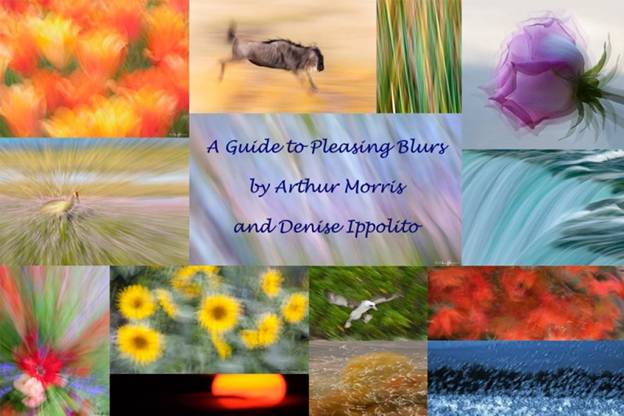
|
|
Learn the secrets of creating contest-winning images in our “A Guide to Pleasing Blurs.”
|
A Guide to Pleasing Blurs
In our A Guide to Pleasing Blurs by Denise Ippolito and yours truly, we discuss just about every technique ever used to create pleasingly blurred image. Ninety-nine point nine percent of pleasing blurs are not happy accidents. You can learn pretty much everything that there is to know about creating them in this instructive, well written, easy to follow guide.
The Bosque Site Guide
If you can’t make or afford a Bosque IPT, or if the holidays preclude your joining one, be sure to get yourself a copy of my Bosque Site Guide. All BAA Site Guides are designed so that with a bit of study you can show up at a great place and know exactly where to be at what time on what wind and in what lighting conditions. And on what wind. With a Site Guide on your laptop you will feel like a 22-year veteran on your first visit. Site Guides are the next best thing to being on an IPT. If you plan on visiting Bosque it would be foolish to make the trip without having this guide in hand. Why spend money on gear and travel and then spend days stumbling around in the wrong spot? If you have visited previously, and are still unsure of where you should be at this time of day with that wind, this guide will prove invaluable to you as well. Even folks visiting Bosque for the tenth time will learn a ton as I share my secrets and hold nothing back….
In the next week or so, I will be working on a very short but valuable information-packed 2015 Bosque Current Conditions Guide; it will be send free to all who have previously purchased the Bosque Site Guide and will also be available as an inexpensive, separate, stand-alone purchase.


Please Remember to use our Affiliate Links 🙂
To show your appreciation for my continuing efforts here, we ask, as always, that you use our the B&H and Amazon affiliate links on the right side of the blog for all of your purchases. B&H is recommended for you major photography gear purchases, Amazon for your household, entertainment, and general purpose stuff. Please check the availability of all photographic accessories in the BIRDS AS ART Online Store, especially the Mongoose M3.6 tripod heads, Gitzo tripods, Wimberley heads and plates, LensCoats and accessories, and the like. We sell only what I have used, have tested, and can depend on. We will not sell you junk. We know what you need to make creating great images easy and fun. And we are always glad to answer your gear questions via e-mail. I just learned that my account was suspended during my absence; it should be up and running by Monday at the latest.
I would of course appreciate your using our B&H affiliate links for all of your major gear, video, and electronic purchases. For the photographic stuff mentioned in the paragraph above we, meaning BAA, would of course greatly appreciate your business. Here is a huge thank you to the many who have been using our links on a regular basis and visiting the BAA Online store as well.
Facebook
Be sure to like and follow BAA on Facebook by clicking on the logo link upper right. Tanks a stack!
Typos
In all blog posts and Bulletins, feel free to e-mail or to leave a comment regarding any typos or errors. Just be right 🙂
December 13th, 2015 What’s Up?
I spent most of the day working on the 2015 Bosque Current Conditions Update. That included working on more than a few new images to illustrate key points in the text.
The Week’s Sign That The Apocalypse is Upon Us
For the first time in my life, I forked over $60 to Pay per View, for the right to watch UFC 194: Weidman versus Rockhold and Aldo versus McGregor. I taped it and will be watching the bouts on Sunday morning….


BAA Bulletin 478
BAA Bulletin 478 is online and can be accessed here.
- Lessons on Photographing Piles of Penguins…
- The 2016 OCT/NOV Cheesemans’ South Georgia/Falklands Expedition: Their and my last one!
- Jim Neiger Flight School Photography: Osprey Heaven Workshops
- Your Help Needed and Appreciated/Affiliate Stuff
|
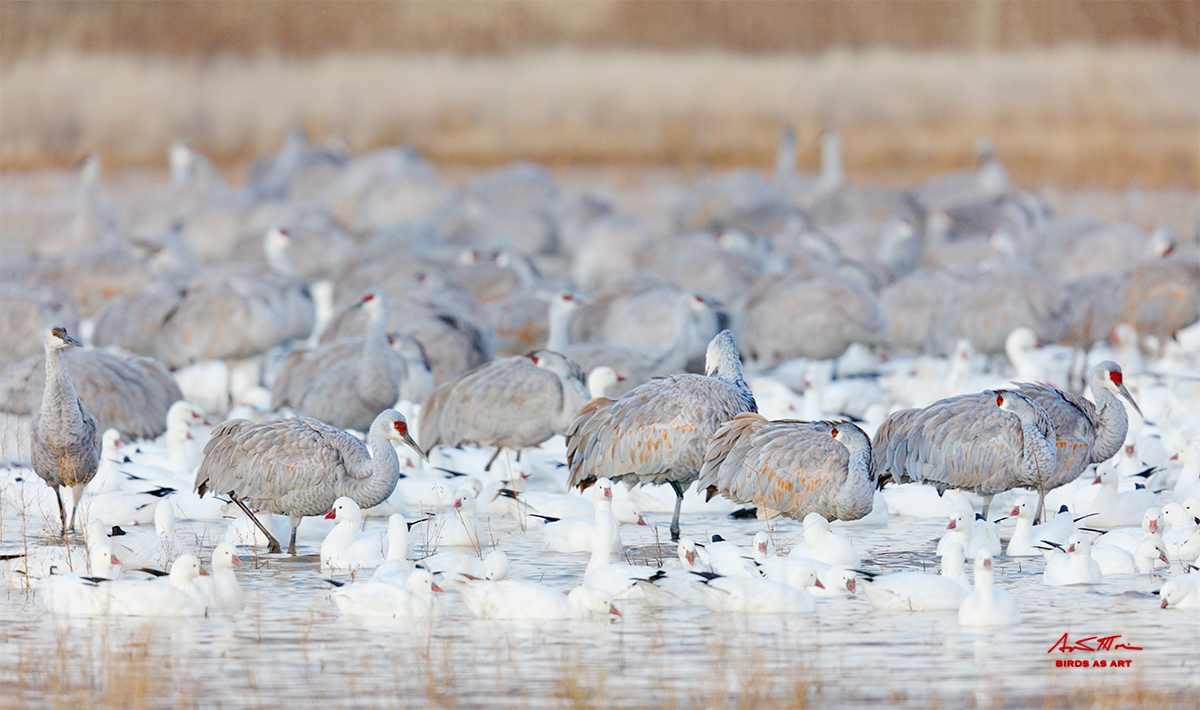
|
|
This image was created at Bosque on the next-to-last morning of the second IPT with the Induro tripod/Mongoose M3.6-mounted
Canon EF 600mm f/4L IS II USM lens, the Canon Extender EF 1.4X III,, and the incredible Canon EOS 5DS R. ISO 2000. Evaluative metering +1 stop: 1/160 at f/6.3 in Tv mode. AWB.
One row down and four AF points to the left of the center AF point (Manual selection)/AI Servo Expand/Rear Focus AF as originally framed was active at the moment of exposure. The chosen AF point fell on the back of the crane leaning forward with one leg raised, center left. Click here to see the latest version of the Rear Focus Tutorial. Click on the image to see a larger version.
Sandhill Cranes and Ross’s Geese in the predawn light
|
Lesson on Photographing Piles of Cranes and Geese…
This feature lesson was adapted from “Lessons on Photographing Piles of Penguins…” in BAA Bulletin 278 (as above).
Photographing large groups of cranes and geese at Bosque and other locations is not as easy an endeavor as it might seem. There are so many birds that you need to pay attention to lots of small but important details. Keep reading to learn a ton.
- In general, try to get as high a vantage point as possible. At Bosque, most of the photography is done from the tour loop roads or dikes that are somewhat elevated. Raise your tripod to full height to maximize the height advantage; every bit of elevation helps. A higher perspective gives depth to the flocks.
- Unless you are doing a frame filling pure pattern shot, strive for a clean lower edge as above.
- Zoom lenses are really helpful when it comes to framing. Take extreme care when it comes to checking the left and right frame-edges… Small crops and a bit of Photoshop edge cleanup can work wonders as they did with the image above.
- Working on a tripod can really help with careful framing.
- Try to find a close bird that is distinctive either by position or pose so that it can serve as a compositional anchor: in today’s featured image I chose to focus on the crane with its leg raised, lower left to set off the rest of the birds in the image.
- Consider the options and choose your perspective carefully.
- As far as the upper frame edge, at times it is possible to have a clean upper edge as here. At times, the birds at the top will simply disappear out of the frame especially if you are working at a wide aperture.
- Speaking of f/stops, your best option when hand holding is to work wide open or close to it to ensure a fast shutter speed. If you are on a tripod and the birds are resting or sleeping, you have the option of going to a tiny aperture and trying to get lots of depth of field with the range of sharpness extending either well back in the frame or actually covering all of the birds; this is in part a function of your focal length and how far away from the birds you are. For today’s image I chose a wide aperture as that best fits my style. Just the one row of cranes and some of the Ross’s Geese in the front are in relatively sharp focus.
- As far as the overall image design is concerned, in situations like this it is often best to compose through the viewfinder as I did with this image. Focus on a possible subject/anchor and then slowly move the lens from side to side and/or a bit higher or lower. Note the clean look to the left and right frame edges that I came up here using that technique.
Which Bird Bugs Me?
One crane bugs me in today’s featured image. If you think that you know which one it is, please leave a comment.
Selling Your Used Gear Through BIRDS AS ART
Selling your used (or like-new) photo gear through the BAA Blog or via a BAA Online Bulletin is a great idea. We charge only a 5% commission. One of the more popular used gear for sale sites charges a minimum of 20%. Plus assorted fees! Yikes. The minimum item price here is $500 (or less for a $25 fee). If you are interested please e-mail with the words Items for Sale Info Request cut and pasted into the Subject line :). Stuff that is priced fairly–I offer free pricing advice, usually sells in no time flat. In the past few months, we have sold just about everything in sight. Do know that prices on some items like the EOS-1D Mark IV, the old Canon 500mm, the EOS-7D, and the original 400mm IS DO lens have been dropping steadily. You can see all current listings by clicking here or by clicking on the Used Photo Gear tab on the yellow-orange tab on the right side of the menu bar above.
|
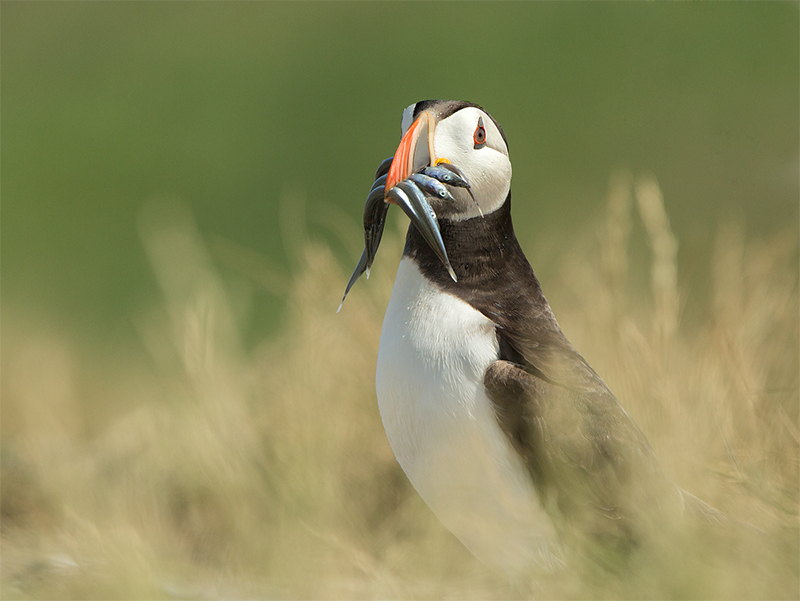
|
|
Donna Bourdon used her old 400 DO exclusively as her long lens on the first-ever BIRDS AS ART UK Puffin and Gannets IPT in 2014. Her Atlantic Puffin with snack image won first place in the Photographic Society of Chattanooga 2014 Annual Photo Contest.
|
Canon 400mm f/4 IS DO Lens
A New Record-Low BAA Price
Good friend and multiple IPT veteran Donna Bourdon is offering a well-used copy of the Canon 400mm f/4 IS DO lens (the old 400 DO) in very good plus condition for a new record-low BAA price, an insanely low of $2599.00. The paint on the lens show signs of wear, but nothing major. The glass is pristine. The included LensCoat is well-worn but functional. The sale includes the lens trunk, the front and rear lens caps, the leather front lens cover, the aforementioned LensCoat, and insured ground shipping via UPS ground. Your item will not ship until your check clears unless other arrangements are made.
Please contact Donna by e-mail or by phone at 1-423 280-6019 (Eastern time).
I used this lens for several years with great success, especially for birds in flight and while working from various type of water craft. In addition, it would make a great prime super-telephoto lens for folks with a 7D II. Gannets in Love was created with the 400 DO. You can see that one and 13 other killer images that I made with my old 400 DO here. The title of that blog post is “The Canon 400mm f/4 IS DO Lens: Fourteen Images that Prove that the Internet Experts are Idiots.” Donna’s lens is priced to sell. artie


Please Remember to use our Affiliate Links 🙂
To show your appreciation for my continuing efforts here, we ask, as always, that you use our the B&H and Amazon affiliate links on the right side of the blog for all of your purchases. B&H is recommended for you major photography gear purchases, Amazon for your household, entertainment, and general purpose stuff. Please check the availability of all photographic accessories in the BIRDS AS ART Online Store, especially the Mongoose M3.6 tripod heads, Gitzo tripods, Wimberley heads and plates, LensCoats and accessories, and the like. We sell only what I have used, have tested, and can depend on. We will not sell you junk. We know what you need to make creating great images easy and fun. And we are always glad to answer your gear questions via e-mail. I just learned that my account was suspended during my absence; it should be up and running by Monday at the latest.
I would of course appreciate your using our B&H affiliate links for all of your major gear, video, and electronic purchases. For the photographic stuff mentioned in the paragraph above we, meaning BAA, would of course greatly appreciate your business. Here is a huge thank you to the many who have been using our links on a regular basis and visiting the BAA Online store as well.
Facebook
Be sure to like and follow BAA on Facebook by clicking on the logo link upper right. Tanks a stack!
Typos
In all blog posts and Bulletins, feel free to e-mail or to leave a comment regarding any typos or errors. Just be right 🙂
December 12th, 2015 What’s Up?
All of the image captions for the San Diego exhibit have been finished, and the Western Digital 2TB My Passport Ultra Portable Hard Drive (Black) with the properly size TIFFs arrived at Fine Print Imaging in Fort Collins, CO on Friday afternoon; two big projects completed. All that while working hard with the folks who will be joining me on the OCT/NOV 2015 Cheesemans’ South Georgia/Falklands Expedition; click here for the whole story. If you would like to join me on what will be an amazing trip to a wondrous place, please shoot me an e-mail with the words “Cheesemans’ Last South Georgia Expedition” cut and pasted into the Subject Line.
I worked as hard every day this week from the early pre-dawn until I hit the sack as I can ever remember. It feels great to have accomplished so much. In the coming days I have to mop up a few things with regards to the exhibit and will continue to work on both the 2015 Bosque Current Conditions Update and the new Southern Ocean Photography Guide. I hope to have the former finished by Monday. I felt pretty good again on Friday. I hope to get back in the pool soon….


Selling Your Used Gear Through BIRDS AS ART
Selling your used (or like-new) photo gear through the BAA Blog or via a BAA Online Bulletin is a great idea. We charge only a 5% commission. One of the more popular used gear for sale sites charges a minimum of 20%. Plus assorted fees! Yikes. The minimum item price here is $500 (or less for a $25 fee). If you are interested please e-mail with the words Items for Sale Info Request cut and pasted into the Subject line :). Stuff that is priced fairly–I offer free pricing advice, usually sells in no time flat. In the past few months, we have sold just about everything in sight. Do know that prices on some items like the EOS-1D Mark IV, the old Canon 500mm, the EOS-7D, and the original 400mm IS DO lens have been dropping steadily. You can see all current listings by clicking here or by clicking on the Used Photo Gear tab on the yellow-orange tab on the right side of the menu bar above.
After somewhat of a summer lull, things have really been heating up on the Used Gear page recently.
- The sale of Melissa Hahn’s Canon 400mm f/2.8L IS II lens is pending….
- Stephen Zarate sold his used Canon 100-400mm L IS zoom lens yesterday for $650 one day after it was listed.
- Kenton Rowe sold his Canon 200-400mm f/4L IS lens with Internal 1.4X Extender in early December for $9799.
- Brent Bridges sold his Canon 600 II for the full asking price, $9799,in early December 2015.
- David Bell sold his Canon 400mm f/5.6L lens yesterday for the full asking price, $699, on the day it was listed!
- Alan and Sara Levine sold their old 300 f/2.8L IS lens in early December for $3175.
- Two Canon 500mm f/4L IS lenses (two) were sold by Pat & Stokes Fishburne for $3799 each in late November, 2015.
- A Canon EOS-1D Mark IV Camera Body was sold by Alice Garland for $1350 in mid-November, 2015.
- Mike Ederegger sold his AF-S Nikkor 200-400mm F/4 G ED VR II in excellent condition for $ 5199 right after it was listed.
- Alan and Sara Levine sold their old five, the Canon 500mm f/4 L IS for $4200 in late August, 2015.
New Listing
Used Canon EF 300mm f/2.8L IS II USM Lens
Good friend and multiple IPT veteran Monte Brown is offering a used Canon EF 300mm f/2.8L IS II USM lens in near-mint condition for the new record low BAA price of $4499. The sale includes the lens trunk, a LensCoat, the tough fabric front cover, the rear lens cap, the original boxes, and insured ground shipping. Your item will not ship until your check clears unless other arrangements are made.
Please contact Monte by e-mail or by phone at 765-744-1421 (Eastern time).
The 300 II is a superbly sharp and versatile lens that kills with both TCs. In addition, it is a great flight lens. Monte’s price is the lowest-ever for this item at BAA. Monte has always taken great care of his gear. artie
|
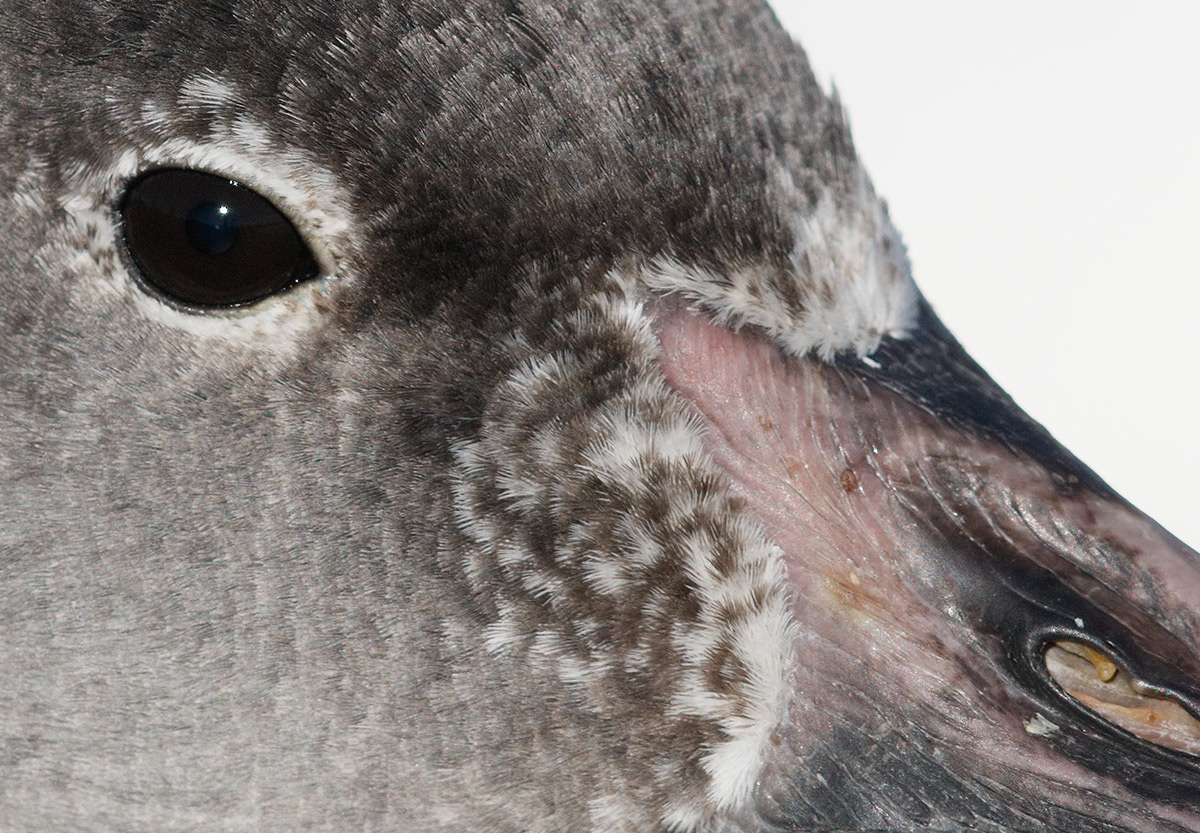
|
|
This 100% crop of today’s featured image below was then cropped to 1200 pixels wide and is displayed here at 800 pixels wide. The view here is un-sharpened and un-processed in any way (other than the re-sizing). What does that all mean? I have no clue as I am not too good at pixel math.
|
The 100% Crop
My thoughts are that the tight crop above is pretty darned impressive as far as sharpness and fine feather detail, the latter being far better than with any previous Canon camera body, at least as far as I can tell…. What do you think?
As Warren Hatch mentioned on the Bosque IPT, seeing the images on my Apple 15.4″ MacBook Pro Notebook Computer with Retina Display & Force Touch Trackpad (Mid 2015) was a simply stunning experience….
|
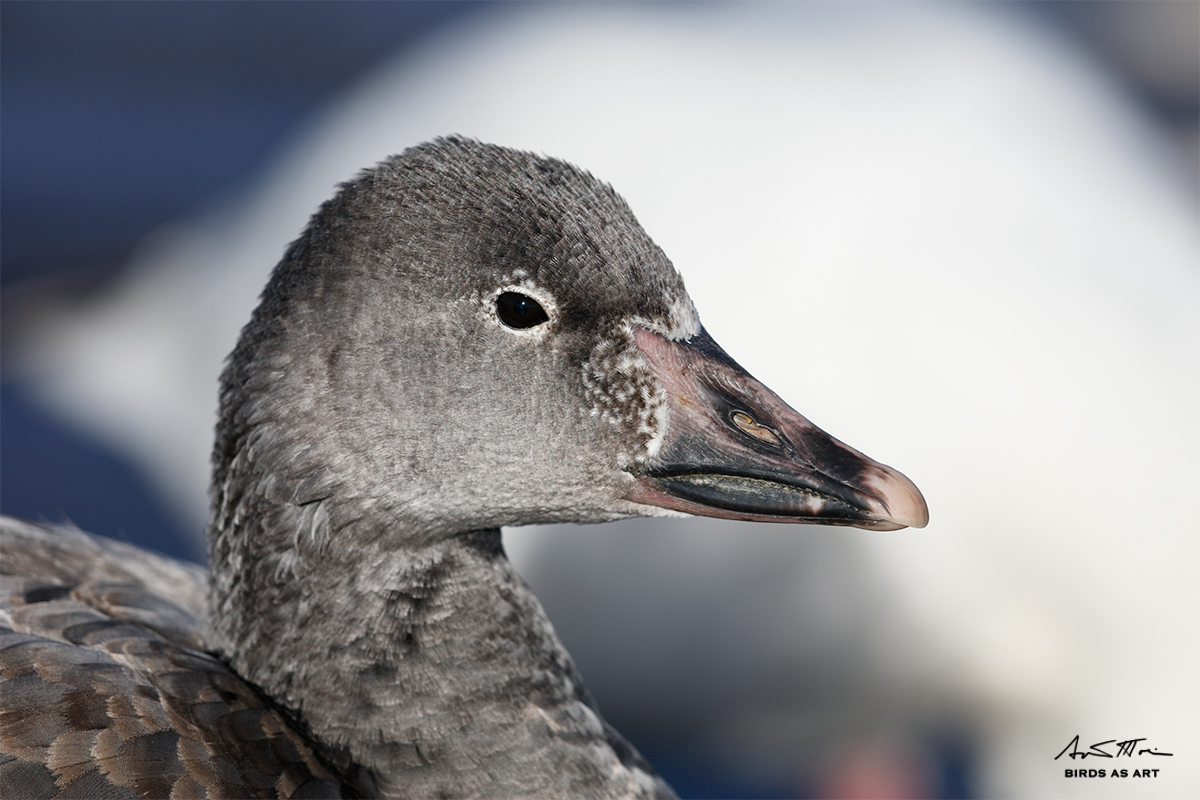
|
|
This image was created at Bosque on the first afternoon of the first 2015 Bosque IPT with the Induro tripod/Mongoose M3.6-mounted
Canon EF 600mm f/4L IS II USM lens, the Canon Extender EF 1.4X III,, and the incredible Canon EOS 5DS R. ISO 400: 1/1600 at f/8. AWB.
Center AF point/AI Servo Expand/Rear Focus AF as framed was active at the moment of exposure. The chosen AF point was just forward and below the goose’s eye. Click here to see the latest version of the Rear Focus Tutorial. Click on the image to see a larger version.
Tight head portrait of juvenile blue morph Snow Goose
|
Creating the Image
The geese were in the best possible afternoon location. We had the whole group on them. I invited all to join me in getting really close but only Dan Turk did so. The rest stayed back and tried for flight images. There were lots of Ross’s Geese close to the shoreline (or on it!) See the vertical head and neck portrait of this uncommon species in the “Canon EOS-5DS R for Birds: An Overview. I’ve never seen image files like these…” blog post here.
Details on this location will be revealed in the 2015 Bosque Current Conditions Update; it will be send free to all who have previously purchased the Bosque Site Guide and will also be available as an inexpensive, separate, stand-alone purchase. It will be available on Monday or Tuesday.
More EOS-5DS R Thoughts
Though I do not search out the internet experts (i.e., internet idiots), I have–in several e-mails–heard some scuttlebutt that indicates that it is difficult to create consistently sharp images with this mega-pixel monster camera body. My impression, going back to the EOS-7D Mark II bodies, is that the more pixels the more care that you have to take as far as keeping the lens still and steady. Pretty much everyone told me that I was wrong and at one point I admitted that I was. But the technically proficient Alan Lillich and several others explained that I was right: on a pixel level, the effects of lens shake or mirror slap are effectively magnified. I never said anything publicly on that. Till now.
I have heard that Canon recommends using the EOS-5DS and the EOS-5DS R only with the latest greatest lenses as only they are able to deal well with the super-high resolution files. I could find no evidence of that either on the internet including the Canon USA site. I will be writing Chuck Westfall, Canon’s top tech rep and share what I learn with you here. If you know of such a list, please do leave a comment with the link.
What I did find on the Canon website was, however, quite interesting:
Advanced Mirror control mechanism and shutter release time lag
The camera shake that occurs from the impact of an SLR’s mirror can leave blurred details in the recorded image. This effect is magnified when working with a super high-resolution sensor like the one found in the EOS 5DS R. To counter the effects of conventional, spring-driven SLR mirrors, the EOS 5DS R features a newly developed Mirror Vibration Control system. The camera’s mirror is not controlled by springs but instead is driven by a small motor and cams. This system suppresses the impact typical of the camera’s mirror, significantly reducing impact and its effects on the image. A new Time Release Lag setting, easily accessed on the EOS 5DS R’s menu system, offers an added protection against camera-shake blur by setting the shutter release time intentionally longer so the camera does not begin the next exposure until after the impact of the camera’s mirror has diffused.
Bold italics mine 🙂
5DS R Help Needed…
#1: I searched the menu carefully six times looking for the Time Release Lag item. Any clues?
#2: I went back to the 5DS R box in search of the camera body instructional booklet so that I could find the Time Release Shutter Lag menu item. All that was in the box was the basic instruction manual. Any clues?
#3: I went online to try and download the full 5DS R Instruction Manual from a Canon website and struck out on that too. Any clues? (I did find alleged 5DS R camera body Manual downloads at sites that I did not trust; all required that you download a “needed program” first and I was reluctant to do that.)
#4: As above, if you have a link to a list of Canon-recommended lenses compatible with the 5DS R please share the link with us by leaving a comment.


Please Remember to use our Affiliate Links 🙂
To show your appreciation for my continuing efforts here, we ask, as always, that you use our the B&H and Amazon affiliate links on the right side of the blog for all of your purchases. B&H is recommended for you major photography gear purchases, Amazon for your household, entertainment, and general purpose stuff. Please check the availability of all photographic accessories in the BIRDS AS ART Online Store, especially the Mongoose M3.6 tripod heads, Gitzo tripods, Wimberley heads and plates, LensCoats and accessories, and the like. We sell only what I have used, have tested, and can depend on. We will not sell you junk. We know what you need to make creating great images easy and fun. And we are always glad to answer your gear questions via e-mail. I just learned that my account was suspended during my absence; it should be up and running by Monday at the latest.
I would of course appreciate your using our B&H affiliate links for all of your major gear, video, and electronic purchases. For the photographic stuff mentioned in the paragraph above we, meaning BAA, would of course greatly appreciate your business. Here is a huge thank you to the many who have been using our links on a regular basis and visiting the BAA Online store as well.
Facebook
Be sure to like and follow BAA on Facebook by clicking on the logo link upper right. Tanks a stack!
Typos
In all blog posts and Bulletins, feel free to e-mail or to leave a comment regarding any typos or errors. Just be right 🙂
December 11th, 2015 What’s Up?
I sent a Western Digital 2TB My Passport Ultra Portable Hard Drive (Black) with the 67 exhibit images on it to Mark Lukes at Fine Print Imaging in Fort Collins, CO. The prints will be ready to go to San Diego to be matted and framed by the middle of next week. Hooray.
I began work on the 2015 Bosque Current Conditions Update. Though I still have lots to do I hope to be finished by Monday. I felt pretty good all day, the best that I have felt in weeks.


Selling Your Used Gear Through BIRDS AS ART
Selling your used (or like-new) photo gear through the BAA Blog or via a BAA Online Bulletin is a great idea. We charge only a 5% commission. One of the more popular used gear for sale sites charges a minimum of 20%. Plus assorted fees! Yikes. The minimum item price here is $500 (or less for a $25 fee). If you are interested please e-mail with the words Items for Sale Info Request cut and pasted into the Subject line :). Stuff that is priced fairly–I offer free pricing advice, usually sells in no time flat. In the past few months, we have sold just about everything in sight. Do know that prices on some items like the EOS-1D Mark IV, the old Canon 500mm, the EOS-7D, and the original 400mm IS DO lens have been dropping steadily. You can see all current listings by clicking here or by clicking on the Used Photo Gear tab on the yellow-orange tab on the right side of the menu bar above.
After somewhat of a summer lull, things have really been heating up on the Used Gear page recently.
- Stephen Zarate sold his used Canon 100-400mm L IS zoom lens yesterday for $650 one day after it was listed.
- Kenton Rowe sold his Canon 200-400mm f/4L IS lens with Internal 1.4X Extender in early December for $9799.
- Brent Bridges sold his Canon 600 II for the full asking price, $9799,in early December 2015.
- David Bell sold his Canon 400mm f/5.6L lens yesterday for the full asking price, $699, on the day it was listed!
- Alan and Sara Levine sold their old 300 f/2.8L IS lens in early December for $3175.
- Two Canon 500mm f/4L IS lenses (two) were sold by Pat & Stokes Fishburne for $3799 each in late November, 2015.
- A Canon EOS-1D Mark IV Camera Body was sold by Alice Garland for $1350 in mid-November, 2015.
- Mike Ederegger sold his AF-S Nikkor 200-400mm F/4 G ED VR II in excellent condition for $ 5199 right after it was listed.
- Alan and Sara Levine sold their old five, the Canon 500mm f/4 L IS for $4200 in late August, 2015.
New Listings
Canon 400mm f/5.6L Lens
Sorry: sold in 15 minutes!
Elizabeth “Annie” Fluke is offering a used Canon 400mm f/5.6L lens in excellent condition for only $698, yet another record-low BAA price (for this item). The sale includes both caps, the tough fabric case (LZ1132), the tripod collar, the original box, and insured ground shipping via UPS or Fed-Ex ground. Your item will not ship until your check clears.
Please contact Annie by e-mail or by phone at 1-(509) 366-9408 (Mountain time zone.)
I put my then-beloved “toy lens” on the map more than 20 years ago by pioneering its use for photographing birds in flight. Wow, did I love that lens along with the Canon A2 camera body and Fuji Velvia pushed one stop to ISO 100! Though I sold mine a few years back it is still a great lens for flight for those who do not depend on IS and it makes a great starter lens as well. Put it on a tripod with the 1.4X III TC, a 7D II, and the Mongoose M3.6 and you will enjoy 896mm of effective reach. This lens is priced to sell quickly. artie
Used Canon EF 300mm f/2.8L IS Lens
Diane Miller is offering a used Canon EF 300mm f/2.8L IS lens in excellent condition for $2899, a BAA record-low price for this item. The sale includes the front and rear lens caps, the lens trunk, an Arca Swiss compatible Really Right Stuff tripod adapter plate (the RRS B61D), the lens strap, and insured shipping via UPS Ground. Your item will not ship until your check clears unless other arrangements are made. Please contact Diane via e-mail or by phone at 1-707-544-2416 (Pacific time zone). Note: Diane will provide photos of the lens upon request.
The 300mm f/2.8 lenses are the #1 choice of the world’s best hawks in flight photographers. And they make a great hand holdable rig when coupled with either TC. If you own a 7D Mark II or work around tame birds, this can be your workhorse super-telephoto lens. artie
Used Canon Series II Teleconverter Set
Sorry, sold in 10 minutes!
Diane Miller is also offering a Series II TC (Extender) set, a 1.4X II and a 2X II teleconverter, for the “giving them away” price of $169 for the pair. Both are in excellent condition. Each TC has both the front and rear caps. Insured shipping via UPS Ground is included. Your items will not ship until your check clears unless other arrangements are made. Please contact Diane via e-mail or by phone at 1-707-544-2416 (Pacific time zone).
The 1.4X II TC is as sharp as the 1.4X III while the 2x II is not quite as sharp to the edges as the 2X III. IAC, this is a steal for anyone just entering the world of teleconverters. artie
Canon 400mm f/4 IS DO Lens
The Already Record Low BAA Price Reduced $200 on DEC 10, 2015.
Stephen Zarate is offering a used Canon 400mm f/4 IS DO lens (the old 400 DO) in very good plus condition for a new record-low BAA price, an insanely low of $2699.00. The lens is covered by a well-worn “digital camo” LensCoat and the tripod ring shows minor signs of wear. The sale includes the lens trunk, the front and rear lens caps, the leather front lens cover, the aforementioned LensCoat, and insured ground shipping via UPS ground. Your item will not ship until your check clears unless other arrangements are made.
Please contact Stephen by e-mail or by phone at 949-697-8194 (Pacific time).
I used this lens for several years with great success, especially for birds in flight and while working from various type of water craft. In addition, it would make a great prime super-telephoto lens for folks with a 7D II. Gannets in Love was created with the 400 DO. You can see that one and 13 other killer images that I made with my old 400 DO here. The title of that blog post is “The Canon 400mm f/4 IS DO Lens: Fourteen Images that Prove that the Internet Experts are Idiots.” Stephen’s lens is priced to sell. artie
|
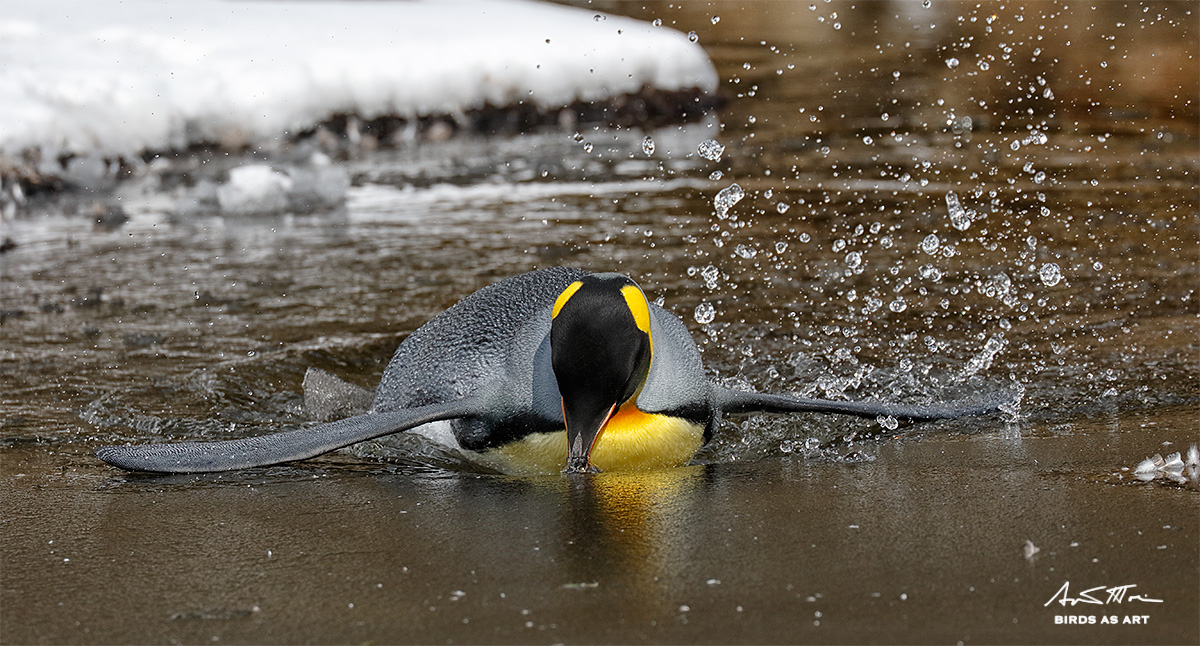
|
|
This image was created at Fortuna Bay, South Georgia, with the hand held Canon EF 100-400mm f/4.5-5.6L IS II USM lens (at 349mm) and the amazing Canon EOS 7D Mark II. ISO 200. (Don’t ask me why.) Evaluative metering -1 stop: 1/2000 sec. at f/7.1 was about 1/2 stop too dark. The image was lightened during the RAW conversion in DPP 4. AWB.
One AG point to the right of the center AF point/AI Servo Expand/Rear Focus AF as originally framed was active at the moment of exposure (as is always best when hand holding). The active sensor fell on the left side of the penguin’s head. Click here to see the latest version of the Rear Focus Tutorial. Click on the image to see a larger version.
King Penguin icebreaking
|
Icebreaker
This penguin considered his options for about five minutes before diving into the shallow river. There was some clear water but most of the surface was covered by a sheet of ice about 1/8 inch thick. Though the bird could have easily gotten to the opposite bank it decided to go icebreaking, swimming down the river while whacking and cracking the ice with its bill as it pushed forward with spray flying everywhere. Why? I have no idea but it seemed as if it was having fun.
My NIK Color EFEX Pro 50-50 recipe did wonders for this originally much-too-high-contrast image. Details are in my Digital Basics File along with my complete Digital Workflow and dozens of great Photoshop tips.
|

|
|
All images on the card were created on the 2015 Cheesemans’ South Georgia Expedition. From top left clockwise to center: King Penguin resting on Snow, Fortuna Bay; Macaroni Penguin in snow, Cooper Island; Grey-headed Albatross, Elsehul; King Penguin neck abstract, Godthul; Northern Giant Petrel, Undine Harbor; adult Wandering Albatross, Prion Island; Elephant Seal, Undine Harbor; South Georgia Pipit fledgling/thanks Joe Kaplan! Fortuna Bay; high key King Penguins in snow, Fortuna Bay.
Card design and all images copyright 2015: Arthur Morris/BIRDS AS ART
|
The Cheesemans’ 2016 OCT/NOV South Georgia/Falklands Expedition
If reading last Saturday’s blog post here put a thought in your mind about joining the BIRDS AS ART group on the Cheesemans’ 2016 OCT/NOV South Georgia/Falklands Expedition, please shoot me an e-mail with the words “Cheesemans’ Last South Georgia Expedition” cut and pasted into the Subject Line with any questions or if you wish to receive additional inspiration. This will surely be my last ship-based trip to the Southern Ocean as well.
|

|
|
All of the images on this card were created in the Falklands on the 2014 Cheesemans’ Southern Oceans Expedition. From top left clockwise to center: Black-browed Albatross tending chick, Steeple Jason Island; Black-browed Albatross courting pair, New Island; the Black-browed Albatross colony at Steeple Jason Island; Black-browed Albatross landing, New Island; King Cormorant head portrait, New Island; hull detail/derelict minesweeper, New Island; Rockhopper Penguin head portrait in bright sun, New Island; Striated Caracara, Steeple Jason Island; Magellanic Snipe chick, Sea Lion Island.
|
An Expedition Overview
Experience the vibrant spring of South Georgia, a true Antarctic wildlife paradise. Observe and photograph wildlife behaviors seldom seen beneath the towering, snow-blanketed mountains that dominate the island’s landscape. Southern Elephant Seal bulls fight for breeding rights while females nurse young, overlook vast colonies of loafing King Penguins, watch Macaroni Penguins cavort in the snow, photograph handsome Gray-headed Albatrosses in flight or attending to their cliffside nests and awkward Wandering Albatrosses attempting first flight. The itinerary includes six landing days on South Georgia and three landing days in the Falklands to observe too cute Rockhopper Penguins, Magellanic Penguins standing watch at their nesting burrows, and more Black-browed Albatrosses than you could ever imagine. To commemorate Shackleton’s famous self-rescue crossing South Georgia, CES also offers an optional trek retracing his steps. With Cheesemans’ twenty years of experience in the Antarctic region, they commit to an in-depth exploration of one of the densest wildlife spectacles found anywhere in the world, and with only 100 passengers, they routinely give you the opportunity to completely immerse yourself on each landing.
Two of the scheduled Falklands’ landings, New Island and especially Steeple Jason Island, rival the best locations on South Georgia. Those will likely include Salisbury Plain, St. Andrews Bay, Elsehul, Fortuna Bay, and either Cooper Island or Hercules Bay (for Macaroni Penguins).
Why Sign Up Through BIRDS AS ART?
If you have been thinking and dreaming of finally visiting South Georgia, this is the trip for you. There will likely never be another trip like this as the best outfit in the Southern Oceans business will not be returning after 2016…. Quit dreaming and act now. Though I will not be an expedition staff member on this trip, those who have traveled with me know that I cannot help but teach. And I will be doing a introductory photography program for the entire ship on our crossing to South Georgia. All who sign up via BAA will receive a free copy the new Southern Ocean Photography Guide (a $100 value) that I am currently working on. It will include pre-trip gear and clothing recommendations and a ton of info that you will find to be invaluable.
I will hold informal pre-landing briefings aboard ship so that when you land you know exactly what to expect and where to go. I will be available on the ship to review your images, answer your questions, and conduct informal over-the shoulder Photoshop sessions. And best of all, everyone who signs up under the auspices of BAA are invited to tag along with me on the landings where I will be glad to offer invaluable in-the-field advice. And the same goes for the shipboard birds in flight and marine mammal photographic sessions.
Again, if you would like to join me on what will truly be a once in a lifetime opportunity to a wondrous place, please shoot me an e-mail with the words “Cheesemans’ Last South Georgia Expedition” cut and pasted into the Subject Line.
You can learn more about the trip here. If you sign up on your own be sure to mention that you would like to be part of the BAA Group. I’d be glad to answer any and all question via e-mail or by phone at 863-692-0906.
Important Notes
#1: If you fail to e-mail me as noted directly above, and register directly with CES you MUST let them know that you would like to be part of the BIRDS AS ART group.
#2: Joining the BIRDS AS ART group as above will not cost you one penny.
For additional details on the trip and the ship, see Saturday’s blog post here.


Please Remember to use our Affiliate Links 🙂
To show your appreciation for my continuing efforts here, we ask, as always, that you use our the B&H and Amazon affiliate links on the right side of the blog for all of your purchases. B&H is recommended for you major photography gear purchases, Amazon for your household, entertainment, and general purpose stuff. Please check the availability of all photographic accessories in the BIRDS AS ART Online Store, especially the Mongoose M3.6 tripod heads, Gitzo tripods, Wimberley heads and plates, LensCoats and accessories, and the like. We sell only what I have used, have tested, and can depend on. We will not sell you junk. We know what you need to make creating great images easy and fun. And we are always glad to answer your gear questions via e-mail. I just learned that my account was suspended during my absence; it should be up and running by Monday at the latest.
I would of course appreciate your using our B&H affiliate links for all of your major gear, video, and electronic purchases. For the photographic stuff mentioned in the paragraph above we, meaning BAA, would of course greatly appreciate your business. Here is a huge thank you to the many who have been using our links on a regular basis and visiting the BAA Online store as well.
Facebook
Be sure to like and follow BAA on Facebook by clicking on the logo link upper right. Tanks a stack!
Typos
In all blog posts and Bulletins, feel free to e-mail or to leave a comment regarding any typos or errors. Just be right 🙂
December 10th, 2015 What’s Up?
Yesterday was one of those rare days where lots of wonderful things happened and weeks of hard work paid off in spades. The latter several times over.
In the morning I tried to call Shawn Marie Greene, the 1979 sixth grade student of mine at PS 106 in the Bushwick section of Brooklyn who had commented on my Facebook page on Tuesday. She did not pick up so I called her friend Dr. Joylene John and by luck she picked up the phone in her office. She was thrilled to learn that Shawn wanted to touch base with her. Joylene mentioned that she had been telling a friend a few weeks back that in sixth grade her class did a great performance of The Wiz and that she sang “Don’t Nobody Bring Me No Bad News!” Her friend said, “I thought that you went to the worst elementary school in New York City. How is it possible that you did a Broadway show with your class?” She responded, “I did. But I had the best teacher ever.”
Right after I hung up Shawn called me and we had a long, wonderful chat reminiscing on the good old days. “Mr. Morris, I can honestly say that sixth grade was the best year of my life.”
Now on to the hard work. My efforts to gain sponsorship for the San Diego exhibit finally paid off. Yesterday I learned that Wimberley, 4th Generation Design, and Cheeseman’s Ecology Safaris would join Delkin Devices as exhibit sponsors. And B&H generously committed to becoming the exhibit’s major sponsor. Last but not leastly, old friend Mark Lukes of Fine Print Imaging in Fort Collins, CO will be printing the 67 exhibit images on Fuji Crystal Archive Matte finish paper. FPI does all the printing for iLCP, the International League of Conservation Photographers.
Wow and thanks to all who will be involved in the exhibit.
Paraphrasing Frankie Valli, the Four Seasons, and Jersey Boys “Oh What a Day!” (December 1963: Oh What a Night.)
More Bosque IPT Kudos
“It’s not bragging if you can do it”
From good friend, multiple IPT veteran, and Bosque #2 participant Greg Ferguson of Atlanta via e-mail:
Artie, I’m writing to thank you for everything you did to make the recent Bosque IPT a photographic success. As Dizzy Dean said about his pitching performance “It’s not bragging if you can do it.” You can say the same thing about your Bosque IPTs. On your recent IPT you certainly demonstrated you can put your students in the right place at the right time for outstanding shooting opportunities. We were in perfect position to catch a snow geese blast-off silhouetted against the pre-dawn glow in the sky. After only about two minutes of continuous shooting you yelled “We have one minute before we leave for our next location.” Warren Hatch and I started laughing because we thought you were kidding. Why leave when we were getting good shots? Well, much to our surprise, we left and found out why. At the next location we were much closer to the geese and got them blasting off directly toward us and over our heads.
So you aren’t bragging about getting people in the right position at the right time because you can do it. Thanks for the wonderful shooting opportunities and the personal care and attention from both you and from Denise Ippolito. And take some personal time to recover from your health issues! Greg.
From first-timer, Bosque #2 participant Barrett Pierce via e-mail:
Hello Artie, Denise and all the Bosque #2 IPT group, I really enjoyed the Bosque del Apache IPT. The reserve is an enchanting place to be at any hour of the day and it was terrific to be there with the IPT group. Your instruction and comments were very valuable and I appreciate everyone’s help. During the trip I identified 48 different bird species at Bosque del Apache NWR and photographed 18 of them. On this trip I took my first photograph using a tripod and for the first time attempted to create an intentionally blurred image that was pleasing. And I did! I also downloaded my first digital images to my laptop during this IPT. Over 98% of my processing is to hit the delete key and the other 2% is cropping; so I am just getting started in that regard. I selected five handheld images for critique and I would appreciate comments on the photos such as they are, and also on the improvement possibilities from using a good tripod, longer lens, improving my image optimization skills, etc. Best regards and best wishes to all. Barrett Pierce


Selling Your Used Gear Through BIRDS AS ART
Selling your used (or like-new) photo gear through the BAA Blog or via a BAA Online Bulletin is a great idea. We charge only a 5% commission. One of the more popular used gear for sale sites charges a minimum of 20%. Plus assorted fees! Yikes. The minimum item price here is $500 (or less for a $25 fee). If you are interested please e-mail with the words Items for Sale Info Request cut and pasted into the Subject line :). Stuff that is priced fairly–I offer free pricing advice, usually sells in no time flat. In the past few months, we have sold just about everything in sight. Do know that prices on some items like the EOS-1D Mark IV, the old Canon 500mm, the EOS-7D, and the original 400mm IS DO lens have been dropping steadily. You can see all current listings by clicking here or by clicking on the Used Photo Gear tab on the yellow-orange tab on the right side of the menu bar above.
After somewhat of a summer lull, things have really been heating up on the Used Gear page recently.
- Kenton Rowe sold his Canon 200-400mm f/4L IS lens with Internal 1.4X Extender in early December for $9799.
- Brent Bridges sold his Canon 600 II for the full asking price, $9799,in early December 2015.
- David Bell sold his Canon 400mm f/5.6L lens yesterday for the full asking price, $699, on the day it was listed!
- Alan and Sara Levine sold their old 300 f/2.8L IS lens in early December for $3175.
- Two Canon 500mm f/4L IS lenses (two) were sold by Pat & Stokes Fishburne for $3799 each in late November, 2015.
- A Canon EOS-1D Mark IV Camera Body was sold by Alice Garland for $1350 in mid-November, 2015.
- Mike Ederegger sold his AF-S Nikkor 200-400mm F/4 G ED VR II in excellent condition for $ 5199 right after it was listed.
- Alan and Sara Levine sold their old five, the Canon 500mm f/4 L IS for $4200 in late August, 2015.
New Listing
Canon 500mm f/4L IS II Lens
Troy Duong is offering a Canon 500mm f/4L IS II lens in excellent condition for the new BAA record-low price of $7500.00. The sale includes a LensCoat, the lens trunk, the leather front hood, the rear lens cap and strap, all original manuals and straps, and insured shipping via UPS Ground. Your item will not ship until your check clears unless other arrangements are made.
Please contact Troy by e-mail or by phone at 1-714-321-3022 (Pacific time).
I have used various versions of the 500mm f/4 lenses for more than two decades. They are the world’s most popular super-telephoto lenses. I owned the Series II 500 and regret selling it as the 600 II is so much heavier and bulkier…. With good sharpness techniques most folks should be able to learn to make razor sharp images with this lens and the 2X III TC. It is light enough so that many folks can hand hold it easily both for flight and general bird photography. The short story: this lens is sharp, relatively light, and much easier to travel than the 600 II. artie
|
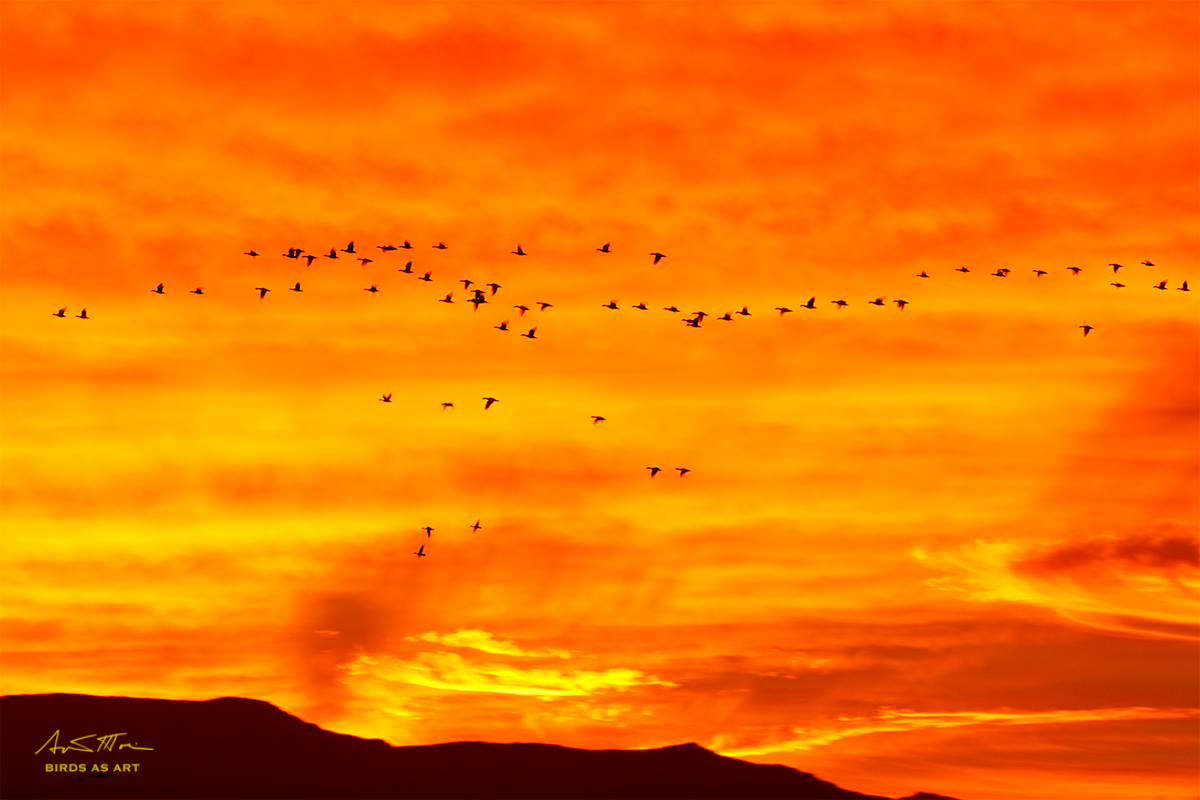
|
|
This image was created at Bosque on November 23, Day 2 of the first Bosque IPT, with the Induro tripod/Mongoose M3.6-mounted Canon EF 200-400mm f/4L IS USM Lens with Internal 1.4x Extender (at 400mm) and the Canon EOS 5DS R. ISO 200. Evaluative metering +2 stops: 1/30 sec. at f/6.3. Color temperature: K7800.
Center AF point/AI Servo Expand/Rear Focus AF as originally framed was active at the moment of exposure. Click here to see the latest version of the Rear Focus Tutorial. Click on the image to see a larger version.
Small flock of geese/mega-sunrise
|
The Continuation of Yesterday’s Lesson…
In yesterday’s blog post here we saw two images made at relatively slow shutter speeds, 1/10 and 1/4 sec. Such shutter speeds can be used to create high degrees of blurring. For many, including and especially me, the results–which imply motion–can be quite pleasing. I wrote, Note that when photographing distant flocks images made at 1/60 and even 1/30 sec. will render most of the individual birds relatively sharp. Today’s featured image, created at 1/30 sec., shows that individual birds in a distant flock, will be rendered pretty darned sharp as long as you concentrate on panning at the same speed as the birds are flying.
And again, by working in Tv Mode with the correct exposure compensation (EC) dialed in, you can quickly and easily vary your shutter speeds several times during an individual blast-off.
EC Question
What was the danger of being at +2 exposure compensation? You need to be specific to get it right….
|
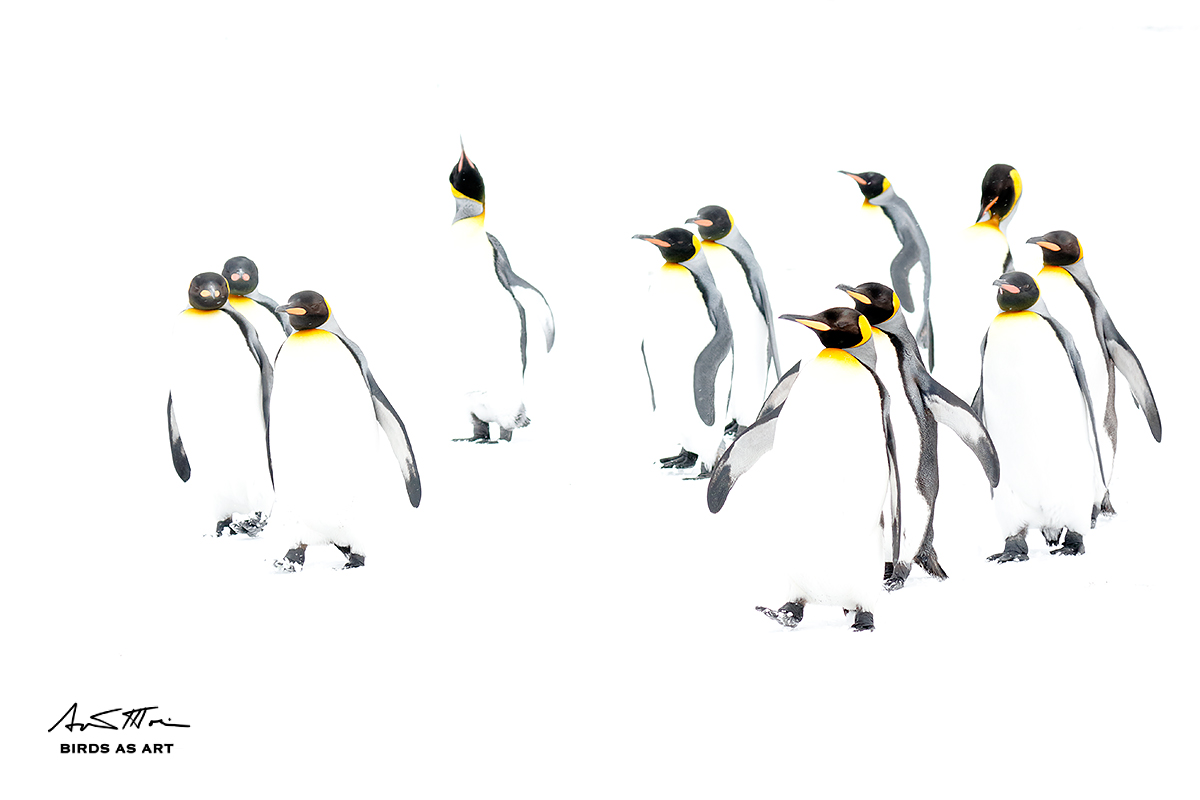
|
|
This image was created on the 2015 Cheesemans’ Southern Ocean Expedition with the hand held Canon EF 100-400mm f/4.5-5.6L IS II USM lens and the amazing Canon EOS 7D Mark II. ISO 400. Evaluative metering +3 stops (was really pushing it…): 1/640 sec. at f/6.3.
The fourth AF point to the right of the center AF point (Manual selection)/AI Servo/Rear Focus AF as originally framed was active at the moment of exposure (as is always best when hand holding). The selected AF point fell on the breast of the closest penguin (on our right). Click here to see the latest version of the Rear Focus Tutorial. Click on the image to see a larger version.
Image #2: only 12 King Penguins walking across a snowfield
|
My Favorites
In yesterday’s blog post my favorite of the two images was the more extreme blur, “Image #2: Snow Goose clear morning flock blur 1/4 second shutter speed.
In the “Fortunate in the Snow at Fortuna Bay” post here I far, far preferred the super-high key rendition above (Image #2: only 12 King Penguins walking across a snowfield) to the more standard capture (Image #1: 14 King Penguins walking across a snowfield). I did like the elimination of the two merged penguins in #2 but it was the mega-high key look that really captivated me with its creativity. Most folks who commented did not agree with me 🙂
|

|
|
All images on the card were created on the 2015 Cheesemans’ South Georgia Expedition. From top left clockwise to center: King Penguin resting on Snow, Fortuna Bay; Macaroni Penguin in snow, Cooper Island; Grey-headed Albatross, Elsehul; King Penguin neck abstract, Godthul; Northern Giant Petrel, Undine Harbor; adult Wandering Albatross, Prion Island; Elephant Seal, Undine Harbor; South Georgia Pipit fledgling/thanks Joe Kaplan! Fortuna Bay; high key King Penguins in snow, Fortuna Bay.
Card design and all images copyright 2015: Arthur Morris/BIRDS AS ART
|
The Cheesemans’ 2016 OCT/NOV South Georgia/Falklands Expedition
If reading last Saturday’s blog post here put a thought in your mind about joining the BIRDS AS ART group on the Cheesemans’ 2016 OCT/NOV South Georgia/Falklands Expedition, please shoot me an e-mail with the words “Cheesemans’ Last South Georgia Expedition” cut and pasted into the Subject Line with any questions or if you wish to receive additional inspiration. This will surely be my last ship-based trip to the Southern Ocean as well.
|

|
|
All of the images on this card were created in the Falklands on the 2014 Cheesemans’ Southern Oceans Expedition. From top left clockwise to center: Black-browed Albatross tending chick, Steeple Jason Island; Black-browed Albatross courting pair, New Island; the Black-browed Albatross colony at Steeple Jason Island; Black-browed Albatross landing, New Island; King Cormorant head portrait, New Island; hull detail/derelict minesweeper, New Island; Rockhopper Penguin head portrait in bright sun, New Island; Striated Caracara, Steeple Jason Island; Magellanic Snipe chick, Sea Lion Island.
|
An Expedition Overview
Experience the vibrant spring of South Georgia, a true Antarctic wildlife paradise. Observe and photograph wildlife behaviors seldom seen beneath the towering, snow-blanketed mountains that dominate the island’s landscape. Southern Elephant Seal bulls fight for breeding rights while females nurse young, overlook vast colonies of loafing King Penguins, watch Macaroni Penguins cavort in the snow, photograph handsome Gray-headed Albatrosses in flight or attending to their cliffside nests and awkward Wandering Albatrosses attempting first flight. The itinerary includes six landing days on South Georgia and three landing days in the Falklands to observe too cute Rockhopper Penguins, Magellanic Penguins standing watch at their nesting burrows, and more Black-browed Albatrosses than you could ever imagine. To commemorate Shackleton’s famous self-rescue crossing South Georgia, CES also offers an optional trek retracing his steps. With Cheesemans’ twenty years of experience in the Antarctic region, they commit to an in-depth exploration of one of the densest wildlife spectacles found anywhere in the world, and with only 100 passengers, they routinely give you the opportunity to completely immerse yourself on each landing.
Two of the scheduled Falklands’ landings, New Island and especially Steeple Jason Island, rival the best locations on South Georgia. Those will likely include Salisbury Plain, St. Andrews Bay, Elsehul, Fortuna Bay, and either Cooper Island or Hercules Bay (for Macaroni Penguins).
Why Sign Up Through BIRDS AS ART?
If you have been thinking and dreaming of finally visiting South Georgia, this is the trip for you. There will likely never be another trip like this as the best outfit in the Southern Oceans business will not be returning after 2016…. Quit dreaming and act now. Though I will not be an expedition staff member on this trip, those who have traveled with me know that I cannot help but teach. And I will be doing a introductory photography program for the entire ship on our crossing to South Georgia. All who sign up via BAA will receive a free copy the new Southern Ocean Photography Guide (a $100 value) that I am currently working on. It will include pre-trip gear and clothing recommendations and a ton of info that you will find to be invaluable.
I will hold informal pre-landing briefings aboard ship so that when you land you know exactly what to expect and where to go. I will be available on the ship to review your images, answer your questions, and conduct informal over-the shoulder Photoshop sessions. And best of all, everyone who signs up under the auspices of BAA are invited to tag along with me on the landings where I will be glad to offer invaluable in-the-field advice. And the same goes for the shipboard birds in flight and marine mammal photographic sessions.
Again, if you would like to join me on what will truly be a once in a lifetime opportunity to a wondrous place, please shoot me an e-mail with the words “Cheesemans’ Last South Georgia Expedition” cut and pasted into the Subject Line.
You can learn more about the trip here. If you sign up on your own be sure to mention that you would like to be part of the BAA Group. I’d be glad to answer any and all question via e-mail or by phone at 863-692-0906.
Important Notes
#1: If you fail to e-mail me as noted directly above, and register directly with CES you MUST let them know that you would like to be part of the BIRDS AS ART group.
#2: Joining the BIRDS AS ART group as above will not cost you one penny.
For additional details on the trip and the ship, see Saturday’s blog post here.


Please Remember to use our Affiliate Links 🙂
To show your appreciation for my continuing efforts here, we ask, as always, that you use our the B&H and Amazon affiliate links on the right side of the blog for all of your purchases. B&H is recommended for you major photography gear purchases, Amazon for your household, entertainment, and general purpose stuff. Please check the availability of all photographic accessories in the BIRDS AS ART Online Store, especially the Mongoose M3.6 tripod heads, Gitzo tripods, Wimberley heads and plates, LensCoats and accessories, and the like. We sell only what I have used, have tested, and can depend on. We will not sell you junk. We know what you need to make creating great images easy and fun. And we are always glad to answer your gear questions via e-mail. I just learned that my account was suspended during my absence; it should be up and running by Monday at the latest.
I would of course appreciate your using our B&H affiliate links for all of your major gear, video, and electronic purchases. For the photographic stuff mentioned in the paragraph above we, meaning BAA, would of course greatly appreciate your business. Here is a huge thank you to the many who have been using our links on a regular basis and visiting the BAA Online store as well.
Facebook
Be sure to like and follow BAA on Facebook by clicking on the logo link upper right. Tanks a stack!
Typos
In all blog posts and Bulletins, feel free to e-mail or to leave a comment regarding any typos or errors. Just be right 🙂
December 9th, 2015 What’s Up?
Did lots more work on the San Diego exhibit and helped a lot of folks interested in joining me on the last-ever Cheesemans’ South Georgia Expedition. Click here to learn the whole story and for all the details on this great trip that will also be my last ship-based trip to the Falklands and South Georgia. My to-do list is getting shorter….
Right before I hit the sack last night I noticed a comment on my Facebook page from a sixth grade student of mine in 1979, a lovely, smart, sweet girl, then Shawn Lewis. She has lived life and grown up and is now Shawn Marie Greene. We are both thrilled at re-connecting after so many years. I hope to be able to put her in touch with one of her classmates, Dr. Joylene John, who practices somewhere near D.C. if I remember correctly; we spoke about six months ago. The are so many wonderful memories….
Shawn posted this on her page: So so happy to hear from u as well n I too will always luv my dear, sweet, kind, generous 6th grade teacher Mr. Morris. Don’t let this b the last time we talk to each other. Ttyl How’s that for warming the heart?


Bosque IPT Kudos
From Bosque #2 participant Usha Peddamatham via e-mail:
Thank you so much Artie for the post-IPT critique of my images. Your cropped version of my Sandhill Crane blur looks so much better. I know you have heard this before: you and Denise (Ippolito) are the most dedicated and committed teachers I have ever come across. I have never been on a photo tour where there was so much of involvement by the leaders. Thank you for motivating and inspiring us. Best wishes for the holidays. BTW, what are the dates for South Georgia trip? Usha
From Bosque #2 participant Richard Goldin via e-mail:
We drove home in two days. On the way we photographed the Very Large Array (VLA) and a herd of pronghorns (using the Pleasing Blur techniques that you taught us to simulate motion). Thanks to you and to Denise (Ippolito) for your expertise and dedication. I never learned so much about taking pictures in four days, heck, I never learned so much in four weeks or four months. The entire group was a pleasure and I don’t like groups as a rule…. I know how hard you and Denise worked but please have a little sympathy for me as I face going through Alice’s and my 5324 images. And Alice doesn’t do computers or Photoshop! It’s all good fun and we had a great time. Thanks, Richard and Alice
From Bosque #2 participant Roger Friend via e-mail:
Denise and Art,
I enjoyed a wonderful learning experience with two great teachers. Art, I will look into a better head tripod head… My left hand got more exercise than I cared for in squeezing the grip handle for extended periods of time. Denise thanks again for keeping me focused. I look forward to future workshops. Five pix to follow in a day or two. Roger
My response:
Hi Roger, Many thanks for your kind words. You are quoted in my blog today. The very best tripod head for the 100-400 II is the Mongoose M3.6 here. It is light, elegant, and efficient and best of all, the lens is rendered weightless. If I had known that you were open to change on the IPT I would have given you a tryout. later an love, artie
From Bosque #2 participant Ron May via e-mail:
Art and Denise, thanks for sharing the Bosque experience; it was a blast 🙂 It was great to see you both again. As usual, the IPT was a real learning experience; I came away with a new appreciation for birds in flight photography. I will be sending you my five favourites as soon as I can get unpacked and organized. I had a four-hour delay on flight from Houston to Calgary so didn’t get in until very late. I needed sleep! To all my new friends, thanks for the memories; hopefully our paths will cross again. Kindest regards, Ron
From Bosque #1 participant Frank T. Sheets via e-mail:
Hi everyone. Laurie and I had a ball on the trip. Thanks a bunch to both of you. Appreciate and thank you for your comments on my images Artie. I will take your suggestions and make the adjustments. What was so special about this trip was not only the company and great instructors, but the the opportunity to photograph these great birds.
Thanks again. Frank
More Wonderful News–can you stand it?
Franks Sheets and Natasha Tofield, both on the second Bosque IPT had so much fun and learned so much that they each signed up for the now-sold-out with a waiting list San Diego IPT.
Selling Your Used Gear Through BIRDS AS ART
Selling your used (or like-new) photo gear through the BAA Blog or via a BAA Online Bulletin is a great idea. We charge only a 5% commission. One of the more popular used gear for sale sites charges a minimum of 20%. Plus assorted fees! Yikes. The minimum item price here is $500 (or less for a $25 fee). If you are interested please e-mail with the words Items for Sale Info Request cut and pasted into the Subject line :). Stuff that is priced fairly–I offer free pricing advice, usually sells in no time flat. In the past few months, we have sold just about everything in sight. Do know that prices on some items like the EOS-1D Mark IV, the old Canon 500mm, the EOS-7D, and the original 400mm IS DO lens have been dropping steadily. You can see all current listings by clicking here or by clicking on the Used Photo Gear tab on the yellow-orange tab on the right side of the menu bar above.
After somewhat of a summer lull, things have been heating up on the Used Gear page recently.
- Kenton Rowe sold his Canon 200-400mm f/4L IS lens with Internal 1.4X Extender in early December for $9799.
- Brent Bridges sold his Canon 600 II for the full asking price, $9799,in early December 2015.
- David Bell sold his Canon 400mm f/5.6L lens yesterday for the full asking price, $699, on the day it was listed!
- Alan and Sara Levine sold their old 300 f/2.8L IS lens in early December for $3175.
- Two Canon 500mm f/4L IS lenses (two) were sold by Pat & Stokes Fishburne for $3799 each in late November, 2015.
- A Canon EOS-1D Mark IV Camera Body was sold by Alice Garland for $1350 in mid-November, 2015.
- Mike Ederegger sold his AF-S Nikkor 200-400mm F/4 G ED VR II in excellent condition for $ 5199 right after it was listed.
- Alan and Sara Levine sold their old five, the Canon 500mm f/4 L IS for $4200 in late August, 2015.
New Listings
Canon 100–400mm f/4.5–5.6L IS Zoom Lens
William B Ellison, Jr. is offering a used Canon 100–400mm f/4.5–5.6L IS zoom lens (the old 1-4) in excellent condition for $675. The sale includes front and rear lens caps, the ET-83C hood, the tripod ring, the tough fabric LZ1324 lens carrying case, and insured shipping via FED-Ex Ground. Your item will not ship until your check clears unless other arrangements are made.
Please contact William via e-mail or by phone at 1-843-884-9595 (Eastern time zone).
The old 100-400 was and is superb. I made hundreds of sale-able images with mine including the image used on the front cover of Scott Weidensaul’s “Return to Wild America”. Contrary to reports by the internet idiots the lens is–in competent hands–sharp at all focal lengths. It is extremely versatile and would make a great starter lens for those interested in bird, wildlife, and general nature photography. artie
Canon EOS-1D Mark IV professional digital camera body
Bill Fraser is offering a Canon EOS-1D Mark IV professional digital camera body in excellent condition for $1299. The sale includes the original box in perfect condition, three (3) LP-E4 Battery packs (the original and two spares), the battery charger LC-E4, Wide Strap L6, the Stereo AV Cable-DC400ST, the Cable Protector with attaching screw, the EOS Digital Solution disc Ver. 21.2, the Software Instruction Manual, printed Instruction Manuals in English and Spanish, the Pocket Guide (abbreviated instruction manual), and insured shipping by UPS Ground to US addresses only. Your camera will be shipped only after your check clears.
Interested folks may contact Bill via e-mail or by phone at 1-336-288-9025 (Eastern time zone). Bill traveled with me on the 2012 South Georgia Cheesemans’ Expedition and will be joining us on the San Diego IPT.
Two rugged 1D Mark IVs served as my workhorse professional bodies for several years. artie
|
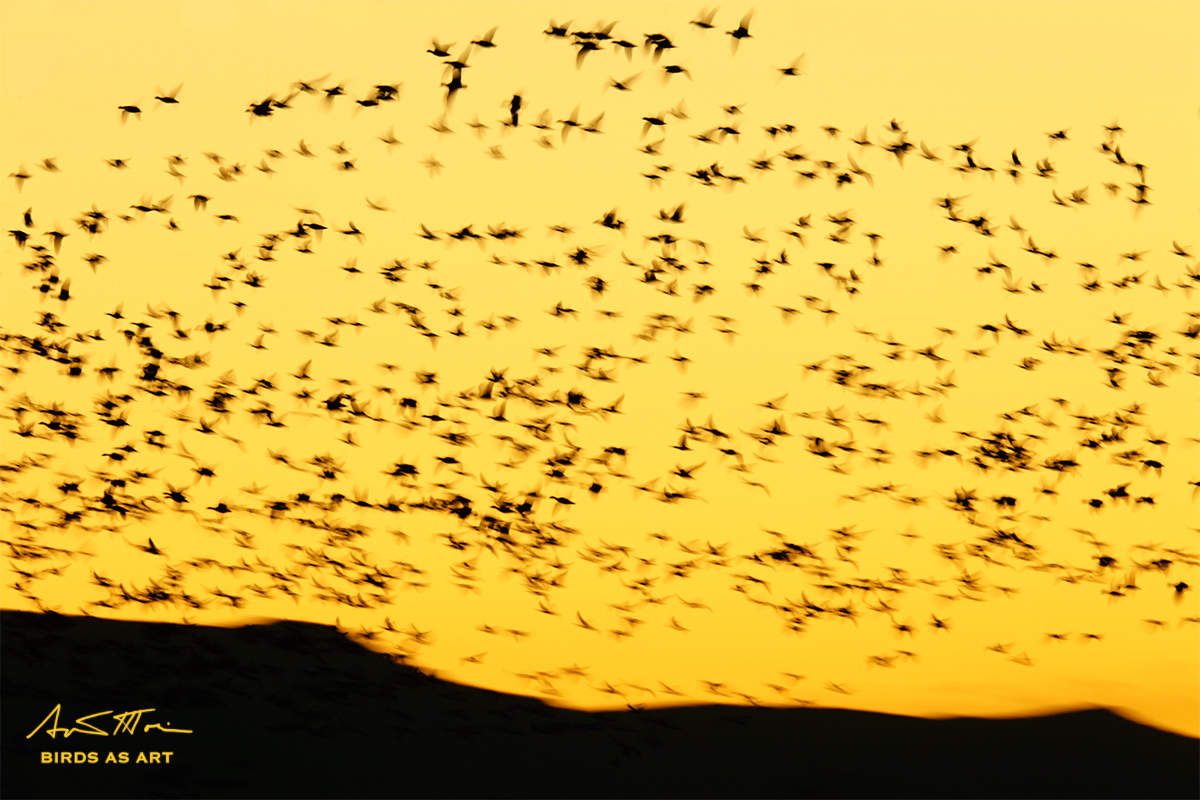
|
|
This image was created at 6:26.05am on the last morning of the second 2015 Bosque IPT with the Induro tripod/Mongoose M3.6-mounted Canon EF 600mm f/4L IS II USM lens, the Canon Extender EF 1.4X III, and the Canon EOS 5DS R. ISO 200 (via ISO Safety Shift). Evaluative metering +1 stop: 1/10 sec. at f/10 in Tv mode. Color temperature: K8000.
Center AF point/AI Servo Expand/Rear Focus Button AF as framed was active at the moment of exposure. Click here to see the latest version of the Rear Focus Tutorial. Click on the image to see a larger version.
Image #1: Snow Goose clear morning flock blur over ridge 1/10 second shutter speed
|
Simple Bosque Sunrise Tip
In the pre-dawn, work in Tv mode (S, shutter priority with Nikon cameras) with Auto ISO set. Canon folks can get the same results by enabling ISO Safety Shift as recommended and detailed in all of my camera User’s Guides. With the latter be sure to set a low ISO such as 200, 100, or 50 so that you will not wind up with a small aperture as the eastern sky gets brighter. This will cut down on sensor dust on your images.
Next, simply add (or very rarely, subtract) the right amount of light to come up with a good exposure and fire away when the geese come over the ridge. Be sure to take a test image every few minutes and check your histograms. Note in the EXIF for today’s two images that I was able to quickly change my shutter speed as the action occurred simply by rolling the index finger wheel…. With this method there is no need to change the ISO every few minutes and no need to have to change the aperture every time you change the shutter speed. It is all done automatically by rolling (only) the index finger wheel to change the shutter speed.
|
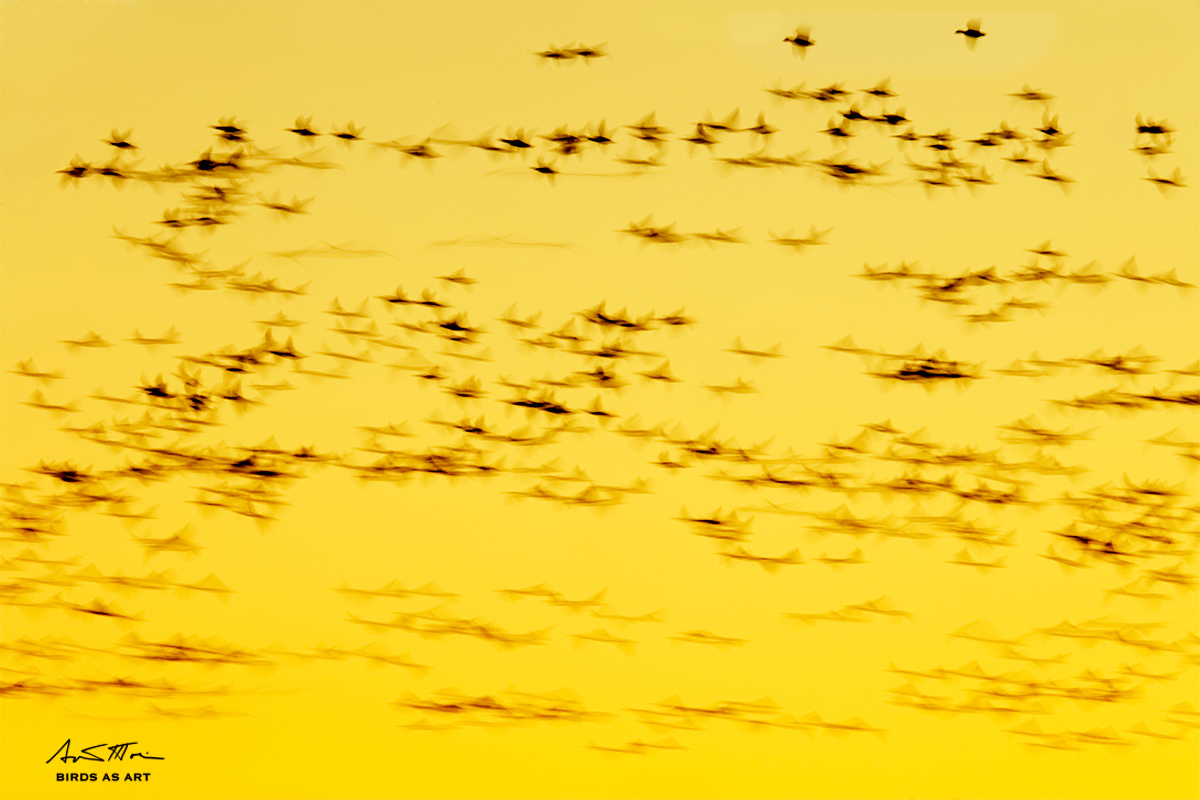
|
|
This image was created at 6:26:31am on the last morning of the second 2015 Bosque IPT with the Induro tripod/Mongoose M3.6-mounted Canon EF 600mm f/4L IS II USM lens, the Canon Extender EF 1.4X III, and the Canon EOS 5DS R. ISO 200 (via ISO Safety Shift). Evaluative metering +1 stop: 1/4 sec. at f/16 in Tv mode. Color temperature: K8000.
Center AF point/AI Servo Expand/Rear Focus Button AF as framed was active at the moment of exposure. Click here to see the latest version of the Rear Focus Tutorial. Click on the image to see a larger version.
Image #2: Snow Goose clear morning flock blur 1/4 second shutter speed
|
More…
Note that when photographing distant flocks images made at 1/60 and even 1/30 sec. will render most of the individual birds relatively sharp.
Please do leave a comment and let us know which of today’s images is your fave. And why.
|

|
|
Learn the secrets of creating contest-winning images in our “A Guide to Pleasing Blurs.”
|
A Guide to Pleasing Blurs
In our A Guide to Pleasing Blurs by Denise Ippolito and yours truly, we discuss just about every technique ever used to create pleasingly blurred image. Ninety-nine point nine percent of pleasing blurs are not happy accidents. You can learn pretty much everything that there is to know about creating them in this instructive, well written, easy to follow guide.
The Bosque Site Guide
If you can’t make or afford a Bosque IPT, or if the holidays preclude your joining one, be sure to get yourself a copy of my Bosque Site Guide. All BAA Site Guides are designed so that with a bit of study you can show up at a great place and know exactly where to be at what time on what wind and in what lighting conditions. And on what wind. With a Site Guide on your laptop you will feel like a 22-year veteran on your first visit. Site Guides are the next best thing to being on an IPT. If you plan on visiting Bosque it would be foolish to make the trip without having this guide in hand. Why spend money on gear and travel and then spend days stumbling around in the wrong spot? If you have visited previously, and are still unsure of where you should be at this time of day with that wind, this guide will prove invaluable to you as well. Even folks visiting Bosque for the tenth time will learn a ton as I share my secrets and hold nothing back….
In the next week or so, I will be working on a very short but valuable information-packed 2015 Bosque Current Conditions Guide; it will be send free to all who have previously purchased the Bosque Site Guide and will also be available as an inexpensive, separate, stand-alone purchase.


Facebook
Be sure to like and follow BAA on Facebook by clicking on the logo link upper right. Tanks a stack!
Typos
In all blog posts and Bulletins, feel free to e-mail or to leave a comment regarding any typos or errors. Just be right 🙂
December 8th, 2015 What’s Up?
I am feeling a bit better each day. I still have a very long to-do list….


Selling Your Used Gear Through BIRDS AS ART
Selling your used (or like-new) photo gear through the BAA Blog or via a BAA Online Bulletin is a great idea. We charge only a 5% commission. One of the more popular used gear for sale sites charges a minimum of 20%. Plus assorted fees! Yikes. The minimum item price here is $500 (or less for a $25 fee). If you are interested please e-mail with the words Items for Sale Info Request cut and pasted into the Subject line :). Stuff that is priced fairly–I offer free pricing advice, usually sells in no time flat. In the past few months, we have sold just about everything in sight. Do know that prices on some items like the EOS-1D Mark IV, the old Canon 500mm, the EOS-7D, and the original 400mm IS DO lens have been dropping steadily. You can see all current listings by clicking here or by clicking on the Used Photo Gear tab on the yellow-orange tab on the right side of the menu bar above.
After somewhat of a lull, things have been heating up on the Used Gear page recently.
- Kenton Rowe sold his Canon 200-400mm f/4L IS lens with Internal 1.4X Extender in early December for $9799.
- Brent Bridges sold his Canon 600 II for the full asking price, $9799,in early December 2015.
- David Bell sold his Canon 400mm f/5.6L lens yesterday for the full asking price, $699, on the day it was listed!
- Alan and Sara Levine sold their old 300 f/2.8L IS lens in early December for $3175.
- Two Canon 500mm f/4L IS lenses (two) were sold by Pat & Stokes Fishburne for $3799 each in late November, 2015.
- A Canon EOS-1D Mark IV Camera Body was sold by Alice Garland for $1350 in mid-November, 2015.
- Mike Ederegger sold his AF-S Nikkor 200-400mm F/4 G ED VR II in excellent condition for $ 5199 right after it was listed.
- Alan and Sara Levine sold their old five, the Canon 500mm f/4 L IS for $4200 in late August, 2015.
New Listings
Canon 500mm f/4L IS II Lens
Good friend and multiple IPT veteran Michael Gotthelf is offering a near-mint Canon 500mm f/4L IS II lens for yet another BAA record-low price: $7799.00. The sale includes a LensCoat, the lens trunk, the leather front hood, the rear lens cap and strap, and insured shipping via either UPS or FED-EX Ground. Your item will not ship until your check clears unless other arrangements are made.
Please contact Mike by e-mail or by phone at 978-407-0679 (eastern time).
I have used various versions of the 500mm f/4 for more than two decades. They are the world’s most popular super-telephoto lenses. I owned the Series II 500 and regret selling it as the 600 II is so much heavier and bulkier…. With good sharpness techniques most folks should be able to learn to make razor sharp images with this lens and the 2X III TC. It is light enough so that many folks can hand hold it easily both for flight and general bird photography. artie
Canon 200-400mm f/4L IS II Zoom Lens with Internal 1.4X Extender
Good friend and IPT veteran George Golumbeski is offering a used Canon 200-400mm f/4L IS zoom lens with Internal 1.4X Extender in excellent plus to near-mint condition with several extras, for $9450.00. The sale includes all of the original items supplied by Canon including the lens trunk, the lens strap, the Canon E-145C Lens Cap (actually a lens hood made of tough synthetic fabric), the rear lens cap, the ET-120 Lens Hood, a 4th Generation Design CRX-5 replacement foot, the the original Canon foot and screws, a LensCoat (in digital camo), a Don Zeck front lens cover, and insured shipping via UPS Ground. Your item will not ship until your check clears unless other arrangements are made.
Please contact George via e-mail or by phone at 1-973 216 3832 (Eastern time zone).
The 200-400 is a killer lens when you are working with tame birds or large mammals; can you say the Galapagos, Africa, South Georgia and the rest of the great Southern Ocean locations, Florida, or La Jolla? I have owned and used this lens since its release. artie
Canon 100–400mm f/4.5–5.6L IS Zoom Lens
Doug Rogers is offering a used Canon 100–400mm f/4.5–5.6L IS zoom lens (the old 1-4) in excellent condition for yet another record-low price: $649. The sale includes the front and rear lens caps and insured shipping via UPS Ground. Your item will not ship until your check clears unless other arrangements are made.
Please contact Doug via e-mail or by phone at 1-434-973-7634 or 1-434-409-8156 (Eastern time zone).
The old 100-400 was and is superb. I made hundreds of sale-able images with mine including the image used on the front cover of Scott Weidensaul’s “Return to Wild America”. Contrary to reports by the internet idiots the lens is–in competent hands–sharp at all focal lengths. It is extremely versatile and would make a great starter lens for those interested in bird, wildlife, and general nature photography. artie
Price Drops!
Canon 400mm f/4 IS DO Lens
Another Lowest-ever BAA Price!
Price Reduced $500 on DEC 7, 2015.
Good friend and multiple IPT veteran Michael Gotthelf is offering a used, super-sharp copy of the Canon 400 mm f/4 IS DO lens in excellent condition (with just a bit of paint wear), now for only $2750.00. The sale includes the lens trunk and key, the leather front lens cover, the rear lens cap and strap, and a RRS lens plate. The sale also includes insured shipping via either UPS or FED-EX Ground. Your item will not ship until your check clears unless other arrangements are made.
Please contact Mike by e-mail or by phone at 978-407-0679 (eastern time).
I used this lens for several years with great success, especially for birds in flight and while working from various type of water craft. In addition, it would make a great prime super-telephoto lens for folks with a 7D II. Gannets in Love was created with the 400 DO. You can see that one and 13 other killer images that I made with my old 400 DO here. The title of that blog post is “The Canon 400mm f/4 IS DO Lens: Fourteen Images that Prove that the Internet Experts are Idiots.” Mike’s lens is priced to sell. artie
Canon EF 70-200 2.8 L IS II USM Lens
Yet Another Lowest-ever BAA Price!
Price Reduced $150 on DEC 7, 2015.
Nigel Boon is offering a used Canon 70-200mm f/2.8 L IS II USM lens in Like-new condition (he has hardly used this lens), now for only $1599.00. The sale includes soft case, lens hood, tripod ring, a Wimberley P-20 plate (a $52 value that is perfect for this lens), the front and rear caps, all original packaging and box, and insured shipping via UPS Ground. Your item will not ship until your check clears or other arrangements are made.
Please contact Nigel by e-mail or by phone at 571 216 7465 (until 11pm EST).
The 70-200mm f/2.8L IS lens is amazingly versatile. I have owned and used one for years and made zillions of great images with it. It works well with both the 1.4X II and the 2X III TCs, even with the 7D II! artie
Canon 85mm f/1.2L II USM Lens
Yet Another Lowest-ever BAA Price!
Price Reduced $140 on DEC 7, 2015.
Nigel Boon is also offering a used Canon 85mm 1.2 L II USM lens in like-new condition, now for only $1459.00. The sale includes the front and rear caps, the lens hood, all original packaging and box, and insured shipping via UPS Ground. Your item will not ship until your check clears or other arrangements are made.
Please contact Nigel by e-mail or by phone at 571 216 7465 (until 11pm EST).
The EF 85mm f/1.2L II USM Lens from Canon is a fast, short-medium telephoto lens that delivers superb optical performance. A maximum aperture of f/1.2 makes it the professional’s choice for shooting without flash in low light conditions. The large aperture also provides fine control over depth of field for compelling portrait photography. A floating optical system and high precision aspherical lens element reduce aberrations and contributes to excellent imaging performance even at the maximum aperture. Super Spectra lens coatings minimize reflections, reducing flare and ghosting. It sells new for $1899. B&H
Featured Item
Canon EOS-1D Mark IV professional digital camera body
Friend and multiple IPT veteran Larry Master is offering a Canon EOS-1D Mark IV professional digital camera body in excellent condition for $1399. The sale includes the original box, the camera manual, the front cap, all cables and CDs, and insured shipping by UPS Ground to US addresses only. Personal checks only; your camera will be shipped only after your check clears.
Interested folks may contact Larry on his cell phone at 518-645-1545 or via e-mail.
Two rugged 1D Mark IVs served as my workhorse professional bodies for several years. artie
|
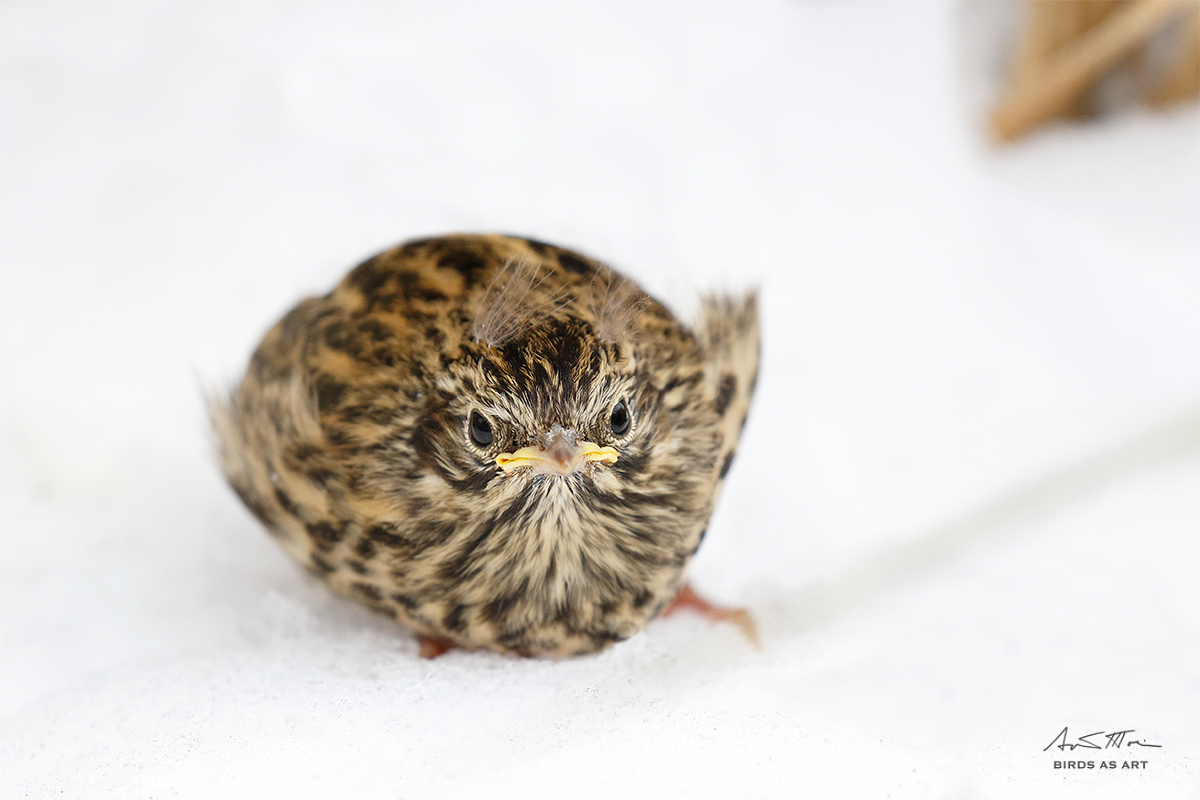
|
|
This image was created on one of my very favorite South Georgia landings, Fortuna Bay, with the hand held Canon EF 100-400mm f/4.5-5.6L IS II USM lens (at 400mm) and the amazing Canon EOS 7D Mark II. ISO 800. Evaluative metering +1 2/3 stops: 1/1000 sec. at f/8 in Manual mode.
Center AF point (Manual selection)/AI Servo/Rear Focus AF as originally framed was active at the moment of exposure (as is always best when hand holding). The selected AF point fall between the right side of the bird’s beak and its right eye. Click here to see the latest version of the Rear Focus Tutorial. Click on the image to see a larger version.
South Georgia Pipit waiting in the snow to be fed
|
Belligerent Little Bugger: Fledgling South Georgia Pipit
The near-threatened South Georgia Pipit is a rare passerine species that nests on South Georgia and small adjacent islands. It is the southernmost breeding songbird in the world. The major threat is the Norway brown rat that eats both its eggs and its chicks. The South Georgia Pipit Heritage Trust recently completed a five-year rat eradication project on South Georgia that was at least five times larger than any other rodent eradication area ever tackled worldwide. Results were quite excellent; the South Georgia government and the Heritage Trust believe that the eradication was 100% successful and will monitor the island for a second year to check for any sign of mice or rats.
If the operation was completely successful, the island could be rodent-free for the first time in more than 200 years. That is good news for the South Georgia Pipits and for other Tussock grass-nesting species such as South Georgia Pintail. The rats do not go after any penguin eggs or young but they are death on all the burrow nesting petrels and they may have had a negative impact on albatross as well. We expect everything from White-chinned Petrels on down to grow substantially in numbers. (Ted Cheeseman/personal comment.)
The Image
Cheesemans’ has a slew of great staff leaders on their Southern Ocean expeditions. I met Joe Kaplan several years ago on a CES voyage and we became fast friends. He is an expert birder, has tremendous enthusiasm for seabirds along with his running mate Dave Shoch, and is a skilled zodiac driver, one of my favorites. Joe found this fledgling pipit, searched me out, brought me to the area, found the bird for me, explained its behavior, and positioned me perfectly to get some good images without disturbing the bird.
How good does it get?
On five previous visits to South Georgia I had never gotten even a single lousy image of this rare species.
Fledgling songbirds often look belligerent because of their gapes which give them a thick-lipped look. No worries, they are shy and timid. Thanks a stack to Joe for his kindnesses over the years.
Why such a high shutter speed? The wind was howling. When I made this image I was just a bit more than a meter from the subject; the close focusing ability of the 100-400 II is simply amazing. I stand by my statement that it would be possible to do a Southern Ocean trip with only the new 1-4 and a 7D II. Along with a 1.4C III TC in your Xtrahand vest pocket….
|

|
|
All images on the card were created on the 2015 Cheesemans’ South Georgia Expedition. From top left clockwise to center: King Penguin resting on Snow, Fortuna Bay; Macaroni Penguin in snow, Cooper Island; Grey-headed Albatross, Elsehul; King Penguin neck abstract, Godthul; Northern Giant Petrel, Undine Harbor; adult Wandering Albatross, Prion Island; Elephant Seal, Undine Harbor; South Georgia Pipit fledgling/thanks Joe Kaplan! Fortuna Bay; high key King Penguins in snow, Fortuna Bay.
Card design and all images copyright 2015: Arthur Morris/BIRDS AS ART
|
The Cheesemans’ 2016 OCT/NOV South Georgia/Falklands Expedition
If reading Saturday’s blog post here put a thought in your mind about joining the BIRDS AS ART group on the Cheesemans’ 2016 OCT/NOV South Georgia/Falklands Expedition, please shoot me an e-mail with the words “Cheesemans’ Last South Georgia Expedition” cut and pasted into the Subject Line with any questions or if you wish to receive additional inspiration. This will surely be my last ship-based trip to the Southern Ocean as well.
|

|
|
All of the images on this card were created in the Falklands on the 2014 Cheesemans’ Southern Oceans Expedition. From top left clockwise to center: Black-browed Albatross tending chick, Steeple Jason Island; Black-browed Albatross courting pair, New Island; the Black-browed Albatross colony at Steeple Jason Island; Black-browed Albatross landing, New Island; King Cormorant head portrait, New Island; hull detail/derelict minesweeper, New Island; Rockhopper Penguin head portrait in bright sun, New Island; Striated Caracara, Steeple Jason Island; Magellanic Snipe chick, Sea Lion Island.
|
An Expedition Overview
Experience the vibrant spring of South Georgia, a true Antarctic wildlife paradise. Observe and photograph wildlife behaviors seldom seen beneath the towering, snow blanketed mountains that dominate the island’s landscape. Southern Elephant Seal bulls fight for breeding rights while females nurse young, overlook vast colonies of loafing King Penguins, watch Macaroni Penguins cavort in the snow, photograph handsome Gray-headed Albatrosses in flight or attending to their cliffside nests and awkward Wandering Albatrosses attempting first flight. The itinerary includes six landing days on South Georgia and three landing days in the Falklands to observe too cute Rockhopper Penguins, Magellanic Penguins standing watch at their nesting burrows, and more Black-browed Albatrosses than you could ever imagine. To commemorate Shackleton’s famous self-rescue crossing South Georgia, CES also offers an optional trek retracing his steps. With Cheesemans’ twenty years of experience in the Antarctic region, they commit to an in-depth exploration of one of the densest wildlife spectacles found anywhere in the world, and with only 100 passengers, they routinely give you the opportunity to completely immerse yourself on each landing.
Two of the scheduled Falklands’ landings, New Island and especially Steeple Jason Island, rival the best locations on South Georgia. Those will likely include Salisbury Plain, St. Andrews Bay, Elsehul, Fortuna Bay, and either Cooper Island or Hercules Bay (for Macaroni Penguins).
Why Sign Up Through BIRDS AS ART?
If you have been thinking and dreaming of finally visiting South Georgia, this is the trip for you. There will likely never be another trip like this as the best outfit in the Southern Oceans business will not be returning after 2016…. Quit dreaming and act now. Though I will not be an expedition staff member on this trip, those who have traveled with me know that I cannot help but teach. And I will be doing a introductory photography program for the entire ship on our crossing to South Georgia. All who sign up via BAA will receive a free copy the new Southern Ocean Photography Guide (a $100 value) that I am currently working on. It will include pre-trip gear and clothing recommendations and a ton of info that you will find to be invaluable.
I will hold informal pre-landing briefings aboard ship so that when you land you know exactly what to expect and where to go. I will be available on the ship to review your images, answer your questions, and conduct informal over-the shoulder Photoshop sessions. And best of all, everyone who signs up under the auspices of BAA are invited to tag along with me on the landings where I will be glad to offer invaluable in-the-field advice. And the same goes for the shipboard birds in flight and marine mammal photographic sessions.
Again, if you would like to join me on what will truly be a once in a lifetime opportunity to a wondrous place, please shoot me an e-mail with the words “Cheesemans’ Last South Georgia Expedition” cut and pasted into the Subject Line.
You can learn more about the trip here. If you sign up on your own be sure to mention that you would like to be part of the BAA Group. I’d be glad to answer any and all question via e-mail or by phone at 863-692-0906.
Important Notes
#1: If you fail to e-mail me as noted directly above, and register directly with CES you MUST let them know that you would like to be part of the BIRDS AS ART group.
#2: Joining the BIRDS AS ART group as above will not cost you one penny.
For additional details on the trip and the ship, see Saturday’s blog post here.


Facebook
Be sure to like and follow BAA on Facebook by clicking on the logo link upper right. Tanks a stack!
Typos
In all blog posts and Bulletins, feel free to e-mail or to leave a comment regarding any typos or errors. Just be right 🙂
|
|
























